Jack Ross's Blog, page 19
August 21, 2019
Craig Harrison (2): The Quiet Earth (1981)
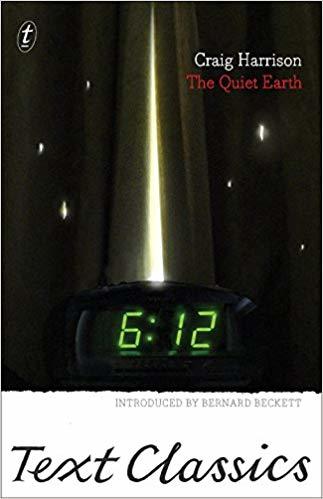
Craig Harrison: The Quiet Earth. 1981. Text Classics (2013)
There's a strange plot-twist in chapter 12 of Craig Harrison's empty world classic The Quiet Earth. His hero, John Hobson, is driving down the North Island, looking for any other survivors of whatever it is that's happened to us all: 'The Event,' as he calls it. Then, all of a sudden:
Christ! There was something ahead, on the road, running into the car lights! I jerked the wheel hard across, braked, swerved, nearly lost control. There was a wild screeching. The car tipped right, skidding, and I flinched, expecting it to roll. It didn't. The wheels lifted, then fell back. The car stopped, sideways across the camber, headlights whitening trees. What in the name of God had I just seen? [88]And what had he just seen? We have to wait almost a whole page to find out:
I had glimpsed, briefly, a bone-white beast the size of a big dog or a calf, hairless, wet and pallid like an abortion. Its head was deformed, a mutant of dog and goat, yet fat and imbecile, wide mouth snarling to the roots of its teeth, and glistening with spit; the car lights had glared back from red points of eyes rimmed pink. I had never seen such a monstrosity, not even among Perrin's worst experimental animals, and they were all mercifully dead. The double shock here was that this nightmare was alive, the only other living thing - ... [89]This sighting upsets the apparent naturalism of the book. As Hobson muses, driving on towards Rotorua ('The stench was the same as ever, like shit in hell'):
I know what I saw back there. If it was real then there were now things living on earth which should be dead, which defied every law of nature I ever knew. And there must be a reason for that. Something I could not live with, in any sense. It demanded my death. [90]In the end, the only language he can find for it 'sounded biblical:'
abomination, it surfaced like some diseased vision from Revelations. The way the creature moved! The slow lope totally alien to the run of a dog or calf, a kind of upright slithering ... [89]
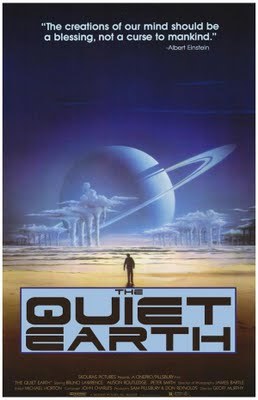
Geoff Murphy, dir.: The Quiet Earth (1985)
Those of you more familiar with Geoff Murphy's classic feature film version of The Quiet Earth (with a screenplay by Bill Baer, Bruno Lawrence, and Sam Pillsbury) probably find this episode not at all what you would expect from the story as you know it.
Like the book's John Hobson, the film's Zac Hobson (played by Bruno Lawrence) wakes up alone in a motel room outside Thames. If you watch it on a DVD with the 'commentary' feature on, you'll hear how proud the film-makers are of that first nearly half an hour of screen time without a single line of dialogue.
It's a tour-de-force. And the powerful logic of the film's story persuades us that's how it must always have been: that that's the way these plots are supposed to go: Zac's lunatic delusions in Auckland, cured by a life-giving swim at Piha. His drive south, meeting first one, then another survivor. His eventual self-sacrifice to stop the 'effect' continuing to the destruction of all life on earth. That final re-awakening on an alien beach, with its wonderful last shot of a strange new planet rising into the spectacular new sky ...
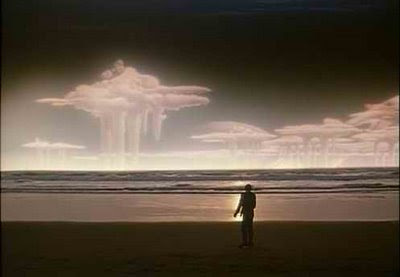
The Quiet Earth: Ending
So what about this strange beast - this apocalyptic revenant from a nightmare - this living disproof that John Hobson can be driving down the same island he knew before?
On the one hand, there's the mysterious nature of Rotorua itself - that place where hidden forces come close to the surface, seemingly always ready to break through - manifesting in strange events and disconcerting discoveries even for the most casual tourist (as I outlined in another blogpost earlier this year: The Mysteries of Rotorua).
On the other hand, there's the clear juxtaposition of this terrifying sight with Hobson's long flashback, in the next chapter, chapter 13, to the life and death of his severely autistic and disabled son Peter. The sole communication he achieves with the boy is (he believes) a request to be allowed to die:
If he wanted to kill himself, what could we do? I knew what the official answer would be; he would have to be placed under close watch in a mental hospital. If necessary, under restraint. [101]Now, as Hobson stands in his motel room, with the muzzle of a shotgun in his mouth, trying (and failing) to make himself pull the trigger, he remembers the final scene of Peter's life:
I am sitting on the edge of the bath. Peter's eyes are devious, they glance in all directions and then again with a wrench of his head they fix on my face. I know what will happen. Holding the sides of the bath, he sinks back, slowly. His face goes from the air by inches, mouth closed, the edge of the water sliding up his face in a silver glint of surface tension, the trapped bubbles of air bright like chromium beads, his eyes open beneath the water. His hair floats and drifts, rising from his forehead, combed in slow motion by the lift of the silver line. Now I have to decide. Ten seconds. Wet skin glitters. The eyes widen. I stand, trembling, the reflections slipping over the brilliance. Goodbye Peter. He will only see my lips move. Then the lights.
I go down the hallway and into the kitchen. I go back into the hall. My child is dying. I go into the front room. Joanne is out. He knows that. I go into the kitchen. How long? I shall tell the inquest I went for a towel to the airing cupboard. Some things fell out when I opened the door. Then the phone rang. Wrong number. Then it was too late. I go into the front room. Dear God. I wrap my arms around myself. I am shivering. The sky dark blue. There is no noise. [104]
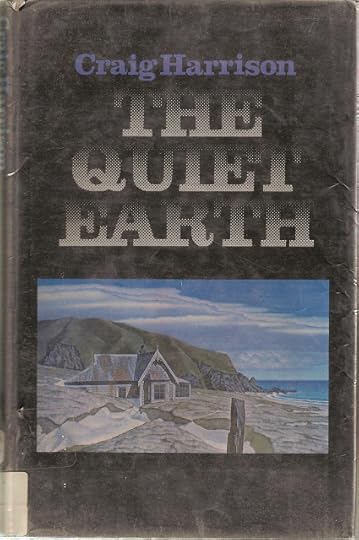
Craig Harrison: The Quiet Earth (1981)
It's not that the actual idea of a kind of cyclic purgatory, going over again and again the worst features of your life, is such an original one: it's not even that unusual a fictional solution to the idea of fleshing out fantastical landscapes. It's more the fact that Craig Harrison takes it so far, writes with such severe, disciplined precision, that makes this - to my mind, at any rate - one of the very best New Zealand novels, realist, speculative, or otherwise.
The stunned clarity of the landscape seemed almost insulting; but even this was only like an extension of the indifference it had always radiated. I had felt it often when driving through remote hills in the past, on deserted roads. The clear light which scrubbed the hills into such precise definition, which polished seas and rinsed distance from time as well as space, had not changed. The nothingness stretching over huge sections of land infinitely had extended itself everywhere [23-24]I guess we're more used to this kind of Terra Nullius evocation in descriptions of Australia: the endless sky, the boundless landscape running by. Expatriate Brit Harrison feels it here, too, though. It's as if New Zealand has always been a kind of purgatory for him: an afterlife, devoid of civilised life, not to mention the patina lent to Old World - in Harrison's case, Yorkshire - landscapes by age and long occupation.
The landscape held no possibilities other than those of that moment. You felt you had seen it all forever. It had no psychic resonance, no memories, no past; nothing human had ever happened here. That was not unusual for parts of New Zealand [my emphasis].
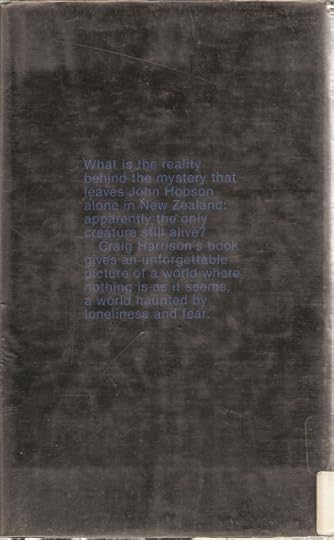
What is the reality behind the mystery that leaves John Hobson alone in New Zealand: apparently the only creature still alive?Of course the fallacy in all this will have struck you already. The South Island myth aside, New Zealand is not, nor ever has been - for the past thousand years, at least - an empty world, where 'nothing human had ever happened'.
Craig Harrison's book gives an unforgettable picture of a world where nothing is as it seems, a world haunted by loneliness and fear.
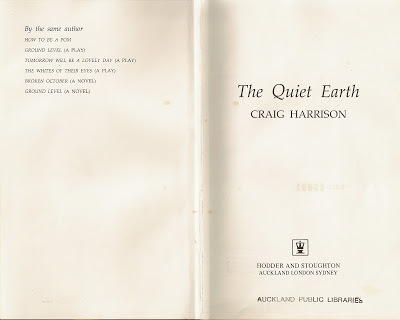
When it comes to Craig Harrison, though, you're preaching to the choir. Pākehā / Māori race relations have been his bread and butter as a writer ever since he first arrived here, back in the dim and distant 1960s. Having given John Hobson a gigantic case of white man's guilt, he goes on to explain a few of the reasons why, beginning with a childhood meeting with a young Māori boy from 'an old house in the next street':
I said something like 'Come in,' but he looked away, shook his head, and mumbled, 'Nah, better go, eh,' and walked off.When John Hobson does finally meet another human being in his strange Odyssey down the North Island it is, predictably, a Māori, ex-soldier Apirana Maketu. And they meet on the Volcanic Plateau, almost exactly in the centre of the island (rather than in Hamilton, as they do in the movie).
I was surprised, not merely at the warnings my aunt and uncle gave me about the undesirability of associating with Polynesian children, since I already had a vague idea that they disliked Maoris, and remarks about contagious scabies and head lice were familiar in the form of general warnings against people one should not mix with; no, what amazed me was the extent of my own naïveté, revealed by the fact that the Maori boy knew more about my surrogate parents than I did [84]
'Why us, then?' he asked; 'we must be special, eh?'
'We must have something in common,' I said, absurdly. He stood back and looked at me, in mock confusion. His face was lightened by very white teeth and the going of the frown, but he was quite dark-skinned and his eyes were very black and quick, scanning me up and down.
'You don't look like Ngati Porou to me,' he said. [123]
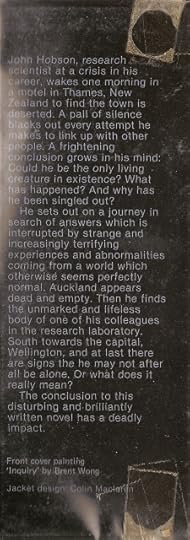
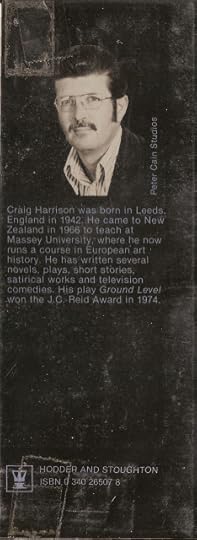
A couple of years ago I wrote a short story, 'Catfish', the protagonist of which is a retired Academic trying to compose a critical essay on Craig Harrison's The Quiet Earth (whilst simultaneously struggling against his own suicidal tendencies). You can, if you're curious, find the whole story in my recent collection Ghost Stories. Here's a quote from the essay-within-the-story:
Far more effectively than in the more programmatic Broken October, Hobson’s suspicions, fears, and final downright homicidal ferocity against Apirana Maketu – note the closeness of that surname to mākutu [curse] – map pākehā paranoia with deadly accuracy. [86]As the blurb above puts it: "The conclusion to this disturbing and brilliantly written novel has a deadly impact." Or, as my protagonist goes on to say in his essay:
The Quiet Earth is, basically, a novel about suicide. Its surface preoccupations with colonial guilt and racism, however strongly expressed, mask an obsession with the details of what might happen after death, especially if that death came out of despair.
Immediately after his terrifying encounter with the strange abortion / shadow-creature, Hobson “put the muzzle of the shotgun in my mouth and reached down to the trigger.” On this occasion, though, “I could do nothing.”
It isn’t till long afterwards, in narrative time, after he and his companion Apirana have run down the one surviving woman in Wellington in their car – by accident, but really as a result of the macho rivalry between them – and the two of them have fought to a finish (Hobson wins: sort of), that he finally has the strength to go back to his point of origin and complete the deed.
His realization, at that point, that he hated his own autistic son and indeed caused his death by drowning, linked to the fact that he and his wife spent their honeymoon in Rotorua, gives some substance to his sense that he is indeed creating the circumstances around him: that they constitute a kind of psychological parody of the conditions of his own life.
Of course, as luck would have it, when he does finally muster the guts to kill himself, he wakes up again, in the same hotel room, with – presumably – the same journey of self-discovery to endure.
No wonder the film chose a more cosmic ending, with its hero knocked through a hole between worlds into a beautiful alien beachscape, with a ringed, Saturn-like planet climbing up from a strangely tranquil sea.
The fact that this is clearly the same West Coast beach which he swam at earlier in the movie, might offer a hint towards the inescapable self-referential mise-en-abîme which lies at the heart of the book. [88-89]
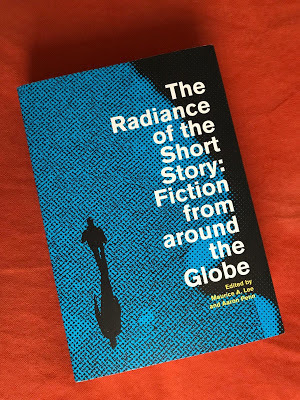
'Catfish'
Do I still agree with my character? Did I ever agree with my character, in fact? The great thing about fiction is that you can have it both ways at once. It's certainly a plausible reading of The Quiet Earth, and it does tie in nicely with my own story's preoccupations.
Earlier on the essay says:
The strength of the idea behind Harrison’s novel is, however, not so much in this use of Nietzsche’s “eternal return” as a plot-structuring device, as the facility with which it enables him to discuss the racial, post-colonial themes so close to his heart.That sounds a bit more like it, to me. There are plenty of 'empty world' stories out there - Earth Abides, I am Legend, The Stand. It's safe to say that none of these are one-idea books. All of them take the opportunity to explore in depth just what it is that bugs their respective authors most about the world we humans have built for ourselves.
That, for me, is a bit closer to the magnitude of Harrison's achievement in this, his second-to-be-published - and almost certainly his greatest - novel. Broken October has many strengths (though not probably not as many as the stage play, Tomorrow Will Be a Lovely Day, that preceded it). Ground Level, which came next, perhaps found more appropriate expression in slapstick form as the pioneering TV sit-com Joe and Koro.
In The Quiet Earth Harrison really found his stride, however. It's a claustrophobic, singularly dark vision he gives us - the film had to lighten it quite a few shades to make it acceptable to a larger audience - but that's what makes it such an impressive novel. It's something one can go back, finding new facets - both disturbing and enlightening - at each repetition of poor John Hobson's self-created, self-cursed trajectory.
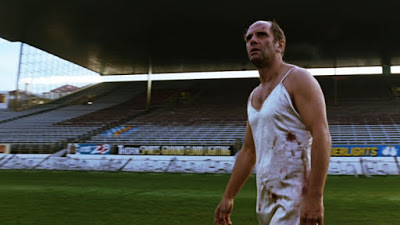
Bruno Lawrence (1941-1995)
•
Published on August 21, 2019 14:21
August 18, 2019
Craig Harrison (1): Broken October (1976)
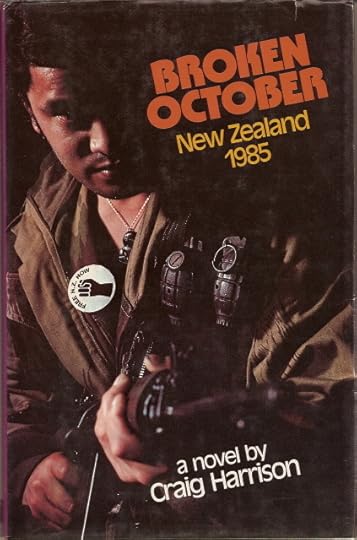
Craig Harrison: Broken October (1976)
From the places with their docile English names, Huntly, Hamilton, Cambridge, he drove on, to Tirau, Putaruru, up into the central hills, the remoteness, where there were few names or places, and thought of a story he had once read called The Heart of Darkness: about how in some central African jungle the Europeans had come to exploit and destroy and had been in their turn destroyed. He still did not really believe in any abstract forces which lay in all this, waiting like that; but the land did have some power to make human beings seem futile, he saw this in the way the road was just a small mark on the face of the hills and the thick forest, a futile and weak gesture, and in a sense it was almost amusing to think of the precariousness of human control over everything: civilisation just a gesture on the edge: and in the center, still, the same heart of darkness. - Craig Harrison: Broken October: 135.
•
When I first went to university, in 1980, I was intending to study history.
None of the papers available in first year really enthused me, though, so instead I drew up an eclectic assortment of courses designed to cover as many other options as possible. You were supposed to do 8 papers in your first year, and 7 in each of the successive years.
So far as I can recall, my 8 included two papers in Ancient History (Roman and Egyptian), two papers in Italian (an introduction to the language and the culture), two papers in English (Chaucer & Shakespeare and Twentieth Century Literature), a paper in Latin, and another paper in Anthropology.
English was not at the top of my list, but - somehow - it was what I ended up specialising in (my other majoring subject was Italian). Part of that was due to the fact that I really enjoyed the lectures and tutorials on modern literature.
I was a ridiculous little know-it-all, who'd already read most of the authors prescribed for us (Ulysses rather than Dubliners, all of Hardy's novels rather than just a few selections from his poetry, etc. etc.) I therefore expected my views to prevail in argument. They did not. Again and again I was forced to admit that even though I had wolfed down so many books, my interpretative skills were lamentably undeveloped.
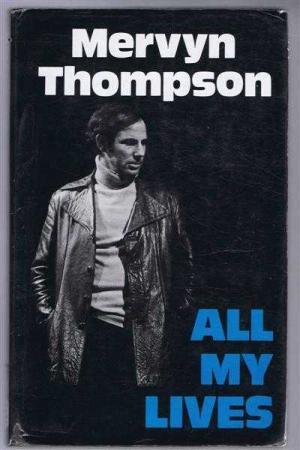
Mervyn Thompson: All My Lives (1975)
The lectures that stick in my mind most of all were a couple of guest appearances by Mervyn Thompson, who talked to us about Craig Harrison's then-recent play Tomorrow Will Be a Lovely Day (1975). I had no idea who Mervyn was, and had the snobbish disdain for New Zealand writers common to those who'd spent too much time trying vainly to keep up with what was 'in' in Europe and America.
The theme of Mervyn's first lecture was the necessity for New Zealand writers to express their own realities, by using local themes and details of local life - and to stop relying on views from elsewhere. I found this an interesting view, but felt compelled to approach him afterwards to acquaint him with the somewhat contrasting attitudes of Jorge Luis Borges in his classic essay 'The Argentine Writer and Tradition' (1951).
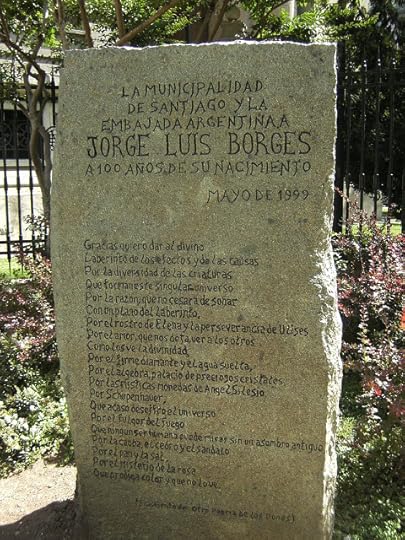
Jorge Luis Borges (1899-1984)
Borges advises his countrymen to eschew any self-conscious use of 'local colour'. Instead, he pontificates:
We should feel that our patrimony is the universe; we should essay all themes, and we cannot limit ourselves to purely Argentine subjects in order to be Argentine; for either being Argentine is an inescapable act of fate — and in that case we shall be so in all events — or being Argentine is a mere affectation, a mask.My efforts to explain all this to Mervyn were not very successful, partially because another enthusiast from the audience also wanted to discuss the lecture with him at the same time. I suppose what remains with me from this rather farcical scene is the courtesy and kindness he showed in trying to speak to each of us without privileging one over the other.
The other exciting aspect of his lecture - there was a follow-up one the next week - was the inside information he included in his discussion of the play. 'In our production we did so-and-so,' he would say. 'Philip Sherry played the news reader at this point in the play ...'
This was heady stuff! The thought of actually meeting and hobnobbing with writers, being involved with them in their artistic endeavours was something quite alien to someone who'd grown up on books of anecdotes about Eliot, Joyce, Pound, Woolf and all the other modernist giants.
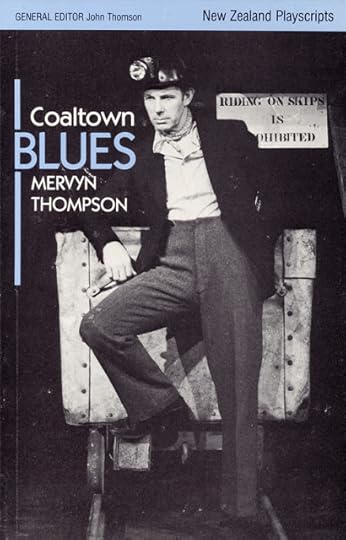
Mervyn Thompson: Coaltown Blues (1984)
Mervyn had his own strange destiny to work out still at that point. In 1984, the year of Coaltown Blues, he was abducted, stripped and tied to a tree with a 'Rapist' sign hung round his neck by a group of feminist protestors who were taking revenge for a student he had allegedly abused. Mervyn admitted the relationship, but claimed it had been concensual.
The bizarre details of his public shaming were borrowed from his friend Renee's play Setting the Table (1982), which he had originally assisted in workshopping. Talk about life imitating art! This was life doing so in the most deliberate fashion possible.
Some people would have submitted to the pressure to stay silent at this point. He was, after all, a lecturer at Auckland University, no friend as an institution - then or now - to loud controversies. Mervyn, however, chose to speak out, writing a long article about the event in the Listener.
What shocked me most about it, though, at the time - how naive of me! - was the fact that the Maidment Theatre almost immediately closed down his play. What happened to innocent until proven guilty, I wondered? No, the moment the flag went up, he became a non-person straight away.
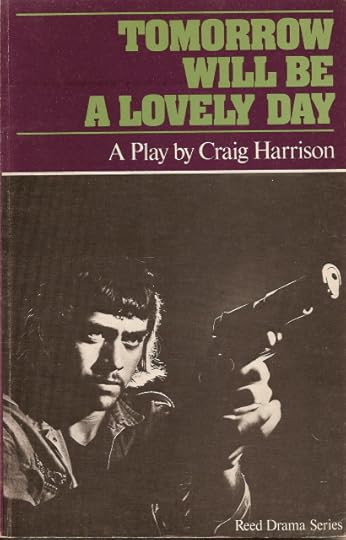
Craig Harrison: Tomorrow Will Be a Lovely Day (1975)
But I've strayed a long way from Craig Harrison and his play. Harrison was then an English lecturer at Massey University, and was rising rapidly in the New Zealand literary scene. I met him years later, in 1991, when I was employed as a tutor down in Palmerston North.
I'd heard he was a bit stand-offish from some of the other teachers around the Department. I'd noticed myself that he never attended Departmental meetings - though given that most of these ended with strident confrontations between the touchier members of the staff, who seemed to make a point of running out of the room in extreme high dudgeon, a different candidate each week - I could see his point about that.
The bold approach usually works best on these occasions, I find. I came up to him in the staffroom while he was making a cup of tea, and said that I'd just finished reading his book Grievous Bodily, and how much I'd enjoyed it.
What was it Mark Twain said? The best way to an author's heart is to tell them you've just read their book. If you really want to seal the deal, tell them you've (bought and) read all of them!
We had a great old natter after that: about Grievous Bodily (almost cripplingly funny, I found it at the time), The Quiet Earth, and various other matters. He told me that he was determined never to publish another novel.
"Whyever not?" I asked.
"Because of the editors. I spent so much time arguing with them over this book that it took all the enjoyment out of it. They insisted I write the word 'biro pen' with a capital letter because it was originally named after its creator, László Bíró. I told them that everyone writes it with a small letter now. They wouldn't give in ..."
And, you know, it's true. He didn't put out another novel after that for another 25 years, not until that amusing YA romp The Dumpster Saga in 2007.
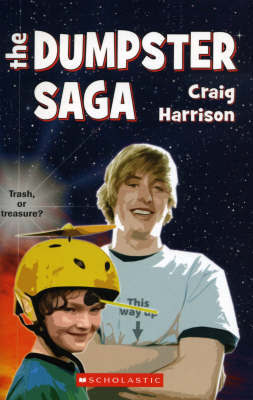
Craig Harrison: The Dumpster Saga (2007)
•

Robert Zemeckis, dir.: Back to the Future (1985)
Back to the Future. That's one way of putting it. Another phrase, devised by Frederick Pohl as the title of his autobiography, is - The Way The Future Was:
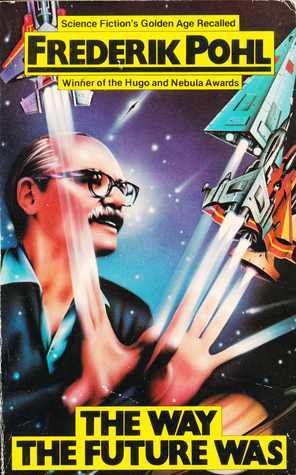
Frederick Pohl: The Way the Future Was (1978)
One of the problems with dystopian visions set in the near future is that they date so quickly. Harrison's play Tomorrow Will Be a Lovely Day was staged for the first time in 1975. It was quickly followed by his 'novelisation' of the script, Broken October, in 1976. That is, if that was the order they were written in - maybe the novel actually preceded the play?
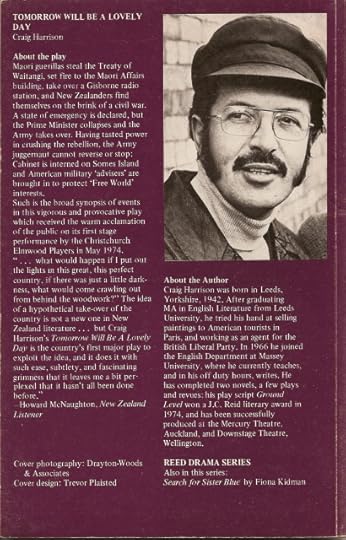
The rapid decay from a smug, paternalist democracy to a police state rather akin to General Pinochet's Chile takes place - in Harrison's grim vision - over a few months of fictional time in the - then distant - year of 1985.
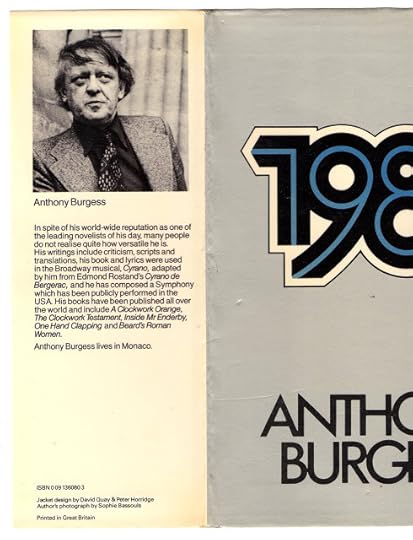
Anthony Burgess: 1985 (1978)
Not that there's anything neutral in that choice of dates. Just like Anthony Burgess a couple of years later, Harrison meant to link his bow-by-blow account of what just might happen in Aotearoa New Zealand if we allowed our already lamentable racial abuse and human rights record to decay any further to George Orwell's already classic masterpiece 1984:
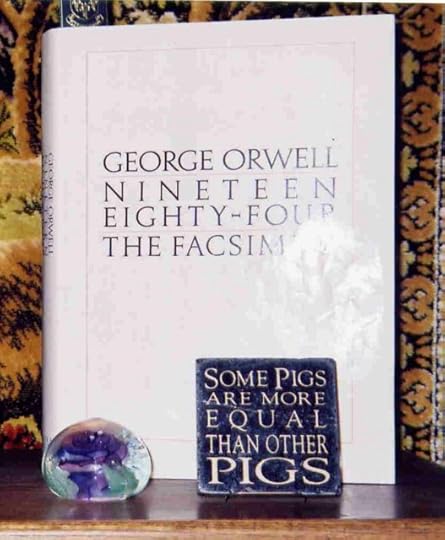
George Orwell: Nineteen Eighty-Four (1949)
Nineteen Eighty-Four may, then and now, be considered a classic - but is it really particularly prescient? is that the true source of its appeal?
Clearly, when we finally reached that canonical year (some 35 years ago now), things were not precisely as described in Orwell's novel - though his Eurasia, Eastasia and Oceania giant states did bear a strong resemblance to the triple power blocks of the USA, Russia, and emergent China.
Burgess's update is shabbier, more satirical, less starkly totalitarian. To be honest, it's a bit difficult to read now - time has not been kind to most of his late novels, only A Clockwork Orange and (perhaps) The Doctor is Sick retaining a bit of their counter-culture punch.
How, then, are we to read Harrison's own localised vision of the year after 1984? Most of what he foresaw didn't happen, of course. The election of a Labour Government in 1984 meant the end of ANZUS as a result of our new nuclear-free policy. The brutal economic warfare of the late 1980s chose a more bureaucratic and less direct way of grinding the people's face in the dust.
If one were to see it as one of (at least) three 1970s fictional visions of New Zealand in the near future: Broken October alongside C. K. Stead's Smith's Dream (1971) and M. K. Joseph's The Time of Achamoth (1976), it's definitely the gloomiest of the three.
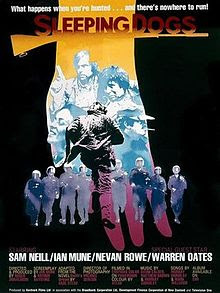
Roger Donaldson, dir.: Sleeping Dogs (1977)
Smith's Dream, compellingly filmed as Sleeping Dogs (1977), has at least the advantage of an initial pastoral vision to put alongside the brutal repression of the new regime. There's a certain artistic advantage in having a single protagonist, too.
M. K. Joseph's innate conservatism made it hard for him to hit out unequivocally at the forces of 'order' in his own complex blended vision of a past constantly interfusing into (and interfering with) the present.
Alongside these two others, Harrison's novel reads rather like a work of popular history: What went wrong with the revolution? Come to think of it, it does have certain analogies with more recent events such as the Arab Spring. His two contrasting Maōri protagonists, Rangi Tamatea and Rewi Waitoa, never really come to life, any more than their respective pakeha girlfriends Helen the nurse and Anne the rich party girl.
His play, Tomorrow Will Be a Lovely Day, has, on the other hand, the advantage of conciseness - as well as a clever use of music and lighting to shift from place to place in the dreamtime of his imagination.

Scott Hamilton: Reading the Maps (August 2004- )
Scott Hamilton, in a 2007 blogpiece on the differences between the Stead's and Harrison's novels, characterises them as follows:
Smith's Dream is bleak, as dystopias tend to be, but it is also abstract, ahistorical, and somewhat mysterious - more like Kafka's The Castle than Nineteen Eighty-Four. The dictator’s politics are hardly fleshed out; nor are those of the resistance that Stead's anti-hero unhappily joins. Stead is interested in telling a parable about the imperfection of humanity and the near-inevitability of the abuse of political power, not in comprehending the specifics of Kiwi society.Back to the future - again. I guess the reason that Stead's novel impacted so much more on popular consciousness is mainly because of those scenes in the film where faceless cops with batons beat the shit out of unarmed demonstrators. "When the Red Squad charged the anti-tour protestors in 1981, people said: 'It's just like Sleeping Dogs,'" said Sam Neill in his account of the film in his 1995 documentary Cinema of Unease.
Broken October, on the other hand, comes with an extended pre-history and a densely sociological present; it is a biggish novel stuffed with faux-newspaper reports and sardonic analyses of the policies of a US-backed military dictator and his trade unionist and Maori nationalist opponents. Stead's book could have been set anywhere, and written anytime in the twentieth century; Harrison's book could only have been written in New Zealand in the 1970s, a time when a strike wave, paranoia about communism, rising racial tension, and a nosediving economy were playing havoc with cosy myths about 'God's own country'.
Scott certainly has a point is in stressing Harrison's prescience in linking this political turmoil directly with race:
Warren Montag has argued that, in treating Heart of Darkness as an allegory for the human condition - that is, an abstract, ahistorical novel - literary canon-builders effectively diverted attention from Conrad’s expose of the horrors of colonialism in nineteenth century Africa. I think that some of the same tendency is at work when literary critics and historians choose Smith’s Dream over Broken October. Harrison is asking us to examine truths about Kiwi society which are concrete and uncomfortable. Stead lets us cop out by sermonising about a universal will to dictatorship. ('Nothing to do with the Maoris, mate, see.')'No politics in sport,' said the establishment spokespeople all through the closest thing New Zealand came to a civil war in 50 years - since the 1951 watersiders strike, in fact - the Springbok tour protests of 1981.
But, once again, it was all about race. Harrison, an outsider to the country, saw that obvious point at once, and has used it as the central vehicle for virtually all of his writing from this distant frontier. Stead's novel is, finally, a far more human piece of work than Harrison's, but its attempts to assert an apolitical common ground between the warring parties - seen most clearly, perhaps, in the famous closing vignette of the sunbathing girl - soon ceased to satisfy even himself. He rewrote that ending for the second edition, and it was rewritten again for Roger Donaldson's film.
Books that lose all interest once their topicality is past can never have been particularly good books in the first place. In fact, it's one of the few criteria we can apply to that perennial question: What actually makes a book good? What makes it worth reading?
Smith's Dream and Broken October are both still worth reading, imho. The first may be a better novel in terms of construction and plot, but the second certainly offers a richer and more nuanced vision of what was then the future - now, I suppose, an alternate timeline. Both, I think it's fair to say, played some small share in preventing the futures they foresaw from happening quite as described.
As I watch the land protests at Ihumātao, so reminiscent of Bastion Point in 1977 - the year after Harrison's novel appeared - the kind of dispute we were told need never happen again in the era of the Waitangi Tribunal, set up specifically to prevent such abuses from remaining unaddressed, I find myself wondering just how far we actually have got.
Walter Benjamin's Angel of History keeps on being swept backwards into the future, lamenting - but powerless to alter - the catastrophes happening in front of its face.
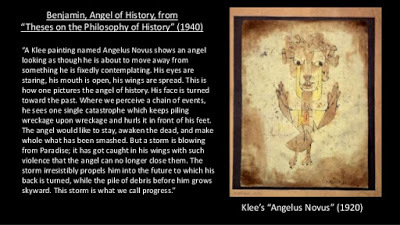
Walter Benjamin: The Angel of History (1920)
•

Craig Harrison
Craig Harrison
(b.1942)
Select Bibliography:
Books:
How to be a Pom. Palmerston North: Dunmore Press, 1975.
Broken October: New Zealand 1985. Wellington: A. H. & A. W. Reed, 1976.
The Quiet Earth. Auckland: Hodder and Stoughton, 1981.
The Quiet Earth. 1981. Introduction by Bernard Beckett. Text Classics. Melbourne: The Text Publishing Company, 2013.
Ground Level. Palmerston North: Dunmore Press, 1981.
Days of Starlight. Auckland: Hodder and Stoughton, 1988.
Grievous Bodily. Auckland: Penguin, 1991.
The Essence of Art: Victorian Advice on the Practice of Painting. Aldershot, England: Ashgate, 1999.
The Dumpster Saga. Auckland: Scholastic New Zealand Limited, 2007.
Plays:
Ground Level. Wellington: Radio NZ, 1974.
The Whites of their Eyes. Wellington: Radio NZ, 1974.
Tomorrow Will Be a Lovely Day. Reed Drama Series. Wellington: A. H. & A. W. Reed, 1975.
Joe and Koro. Wellington: NZBC, 1976-77.
The Quiet Earth. 1986.
White Lies. Auckland: New House, 1994.
Screen Adaptations:
The Quiet Earth, dir. Geoff Murphy, writ. Bill Baer, Bruno Lawrence, Sam Pillsbury (based on the novel by Craig Harrison) – with Bruno Lawrence, Alison Routledge, Pete Smith – (NZ, 1985).
Homepages & Online Information:
NZ Book council profile
NZ on screen profile
Wikipedia entry
•
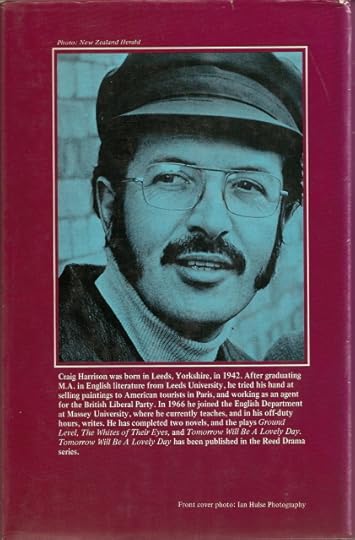
Published on August 18, 2019 15:37
July 31, 2019
My new book Ghost Stories is available today:
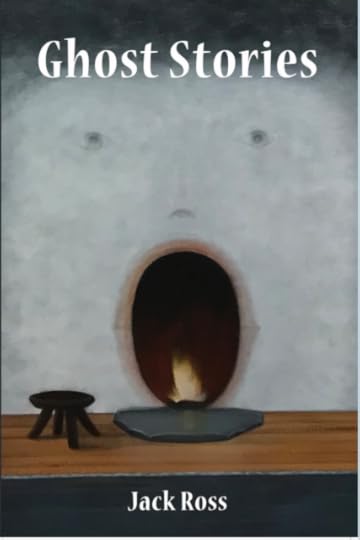
Cover image: Graham Fletcher (by courtesy of the artist) /
Cover design: Daniela Gast (2019)
The official publication date for my new collection of short fiction, Ghost Stories , was yesterday, 31st July 2019.
It's been a great pleasure to work on it with the team at Lasavia Publishing on Waiheke Island: editor Rowan Sylva, designer Daniela Gast, publisher Mike Johnson, as well as the other members of the collective. I also owe a big thank you to Graham Fletcher for the use of his cover image, and (as always) to my lovely wife Bronwyn for invaluable advice at every stage of the process. Thanks, too, to Tracey Slaughter for the use of that blurb quote.
So how do you obtain a copy of the book? That is, after all, the $64,000 question. If you wish to order one online, it's available from any of the following websites:
Amazon.comAs usual, the Book Depository seems to offer the best deal, but remember that copies can also be purchased at a discounted rate, $20, at the Waiheke Market, or (for that matter) directly from Lasavia Publishing:
RRP: $US 15.00 (+ postage)
Amazon.co.uk
RRP: £UK 12.28 (+ postage)
Book Depository
RRP: $NZ 29.44 (free postage)
Wheelers Books
RRP: $NZ 49.50
Lasavia PublishingWe're planning a big launch party later in the year, which I'll describe in detail here on the blog once all the arrangements are finalised, so - if you prefer - you could wait until then. But I know what eager beavers some of you readers can be!
37 Crescent Rd West
Ostend
Waiheke Island
Auckland 1081
https://www.lasaviapublishing.com/
Lasavia Publishing: Editorial
RRP: $NZ 20.00 (+ postage)
•
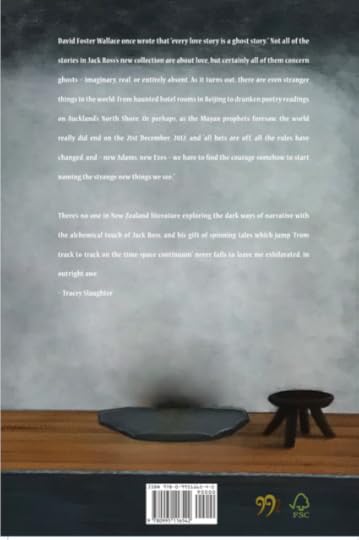
So what exactly is the book about? The easiest thing might just be to quote from the blurb:
David Foster Wallace once wrote that 'every love story is a ghost story.' Not all of the stories in Jack Ross’s new collection are about love, but certainly all of them concern ghosts – imaginary, real, or entirely absent. As it turns out, there are even stranger things in the world: from haunted hotel rooms in Beijing to drunken poetry readings on Auckland’s North Shore. Or perhaps, as the Mayan prophets foresaw, the world really did end on the 21st December, 2012, and 'all bets are off, all the rules have changed, and – new Adams, new Eves – we have to find the courage somehow to start naming the strange new things we see.'
'There’s no one in New Zealand literature exploring the dark ways of narrative with the alchemical touch of Jack Ross, and his gift of spinning tales which jump "from track to track on the time-space continuum" never fails to leave me exhilarated, in outright awe'.
- Tracey Slaughter
Jack Ross works as a senior lecturer in creative writing at Massey University. He is the author of five poetry collections, four novels and three books of short fiction. His novel The Annotated Tree Worship was highly commended in the 2018 NZ Heritage Book Awards. He has also edited numerous books, anthologies, and literary journals, including brief, Landfall, and Poetry New Zealand. He blogs at http://mairangibay.blogspot.com/.
And here's a - slightly more informative - abstract I composed to send to my masters at Massey University, who insist on full details of every publication by their staff:
This is a set of ten short stories, with two essays: 'The Classic New Zealand Ghost Story,' an introduction to the collection as a whole; and 'Kipling and the Cross-Correspondences,' an account of the alleged attempts at communication from the other side by various dead members of the Society for Psychical Research in the early years of last century. The stories, too, are grouped around the common theme of ghosts and ghost stories, but in some rather unexpected ways. Two ('The Scam' and 'The Cross-Correspondences') are set in China, but most are explorations of the haunted landscapes of the New Zealand's North Island, from Featherston and Eketahuna to Raglan and Auckland. All of them (with the exception of 'Paragraphs') have been previously published in periodicals or online.
•
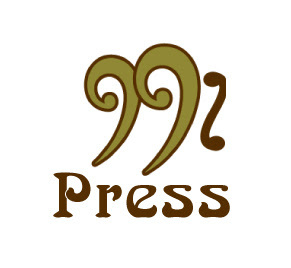
99% Press
Now those of you obsessed (as I am) by numerology, might well have noticed an ominous feature of that list of publications in the blurb above. My breakdown of books now stands at:
5 poetry booksYes, this is indeed my number thirteen!
4 novels
3 short story collections
+ 1 stand-alone novella
= 13 in total
All I can say is that nearly as many traditions see thirteen as a lucky number as fear it for being unlucky.
Mind you, I could fudge the count a bit if I wished. I could count my novel The Annotated Tree Worship as two books rather than one, given it appeared in two separate volumes. But they are intended as interlinked novellas, and were never really meant to be read independently.
There's also the fact that I've published 16 chapbooks at one time or another. That would bring up the total to an innocuous 29!
And then there are the various books and anthologies I've edited (15 in all, it would appear). That would bring us up to 44.
But these expedients would really just be cheating. So far as I'm concerned, I've now written 13 books, so I've taken some care to make the thirteenth as appropriate as possible. It is, after all, an exploration of the paranormal, the supernatural, as it manifests (for the most part) in some of the gloomier parts of New Zealand ...
I hope it's enjoyable. I know not everyone shares my fascination with such matters, but a great many people do. And I would argue that most of these stories can be read in a variety of ways: as actual 'ghost stories' being just one of them.
•
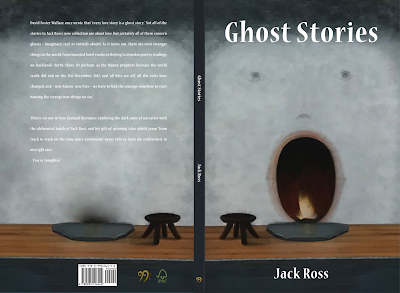
Here's a list of the contents:
IntroductionThe Classic New Zealand Ghost Story
StoriesEketahuna
The Scam
Featherston
Leaves from a Diary of the End of the World
Is it Infrareal or is it Memorex?
Company
General Grant in Paeroa
Brothers
Catfish
The Cross-CorrespondencesParagraphs
Kipling and the Cross-Correspondences
And here's a list of my 13 books to date:
City of Strange Brunettes . ISBN 0-473-05446-9 (Auckland: Pohutukawa Press, 1998) [poetry book 1] Nights with Giordano Bruno . ISBN 0-9582225-0-9 (Wellington: Bumper Books, 2000) [novel 1] Chantal’s Book . ISBN 0-473-08744-8 (Wellington: HeadworX, 2002) [poetry book 2] Monkey Miss Her Now & Everything a Teenage Girl Should Know . ISBN 0-476-00182-X (Auckland: Danger Publishing, 2004) [short story collection 1] Trouble in Mind . Titus Novella Series. ISBN 0-9582586-1-9 (Auckland: Titus Books, 2005) [novella] The Imaginary Museum of Atlantis . ISBN 0-9582586-8-6 (Auckland: Titus Books, 2006) [novel 2] To Terezín: A Travelogue . Afterword by Martin Edmond. Social and Cultural Studies, 8. ISSN 1175-7132 (Auckland: Massey University, 2007) [poetry book 3] EMO . ISBN 978-1-877441-07-3 (Auckland: Titus Books, 2008) [novel 3] Kingdom of Alt . ISBN 978-1-877441-15-8 (Auckland: Titus Books, 2010) [short story collection 2] Celanie: Poems & Drawings after Paul Celan . by Jack Ross & Emma Smith, with an Afterword by Bronwyn Lloyd. ISBN 978-0-473-22484-4 (Auckland: Pania Press, 2012) [poetry book 4] A Clearer View of the Hinterland: Poems & Sequences 1981-2014 . ISBN 978-0-473-29640-7 (Wellington: HeadworX, 2014) [poetry book 5] The Annotated Tree Worship (Auckland: Paper Table, 2017) [novel 4]Draft Research Portfolio. ISBN 978-0-473-41328-6. Paper Table Novellas, 2 (i).List of Topoi. ISBN 978-0-473-41329-3. Paper Table Novellas, 2 (ii). Ghost Stories . ISBN 978-0-9951165-5-9. 99% Press (Auckland: Lasavia Publishing, 2019) [short story collection 3]
•
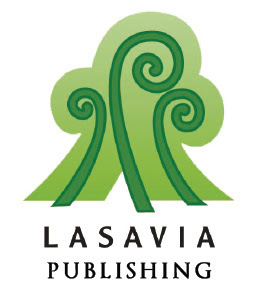
Lasavia Publishing
Published on July 31, 2019 16:07
July 29, 2019
Islomanes (3): Elizabeth Knox's Mortal Fire
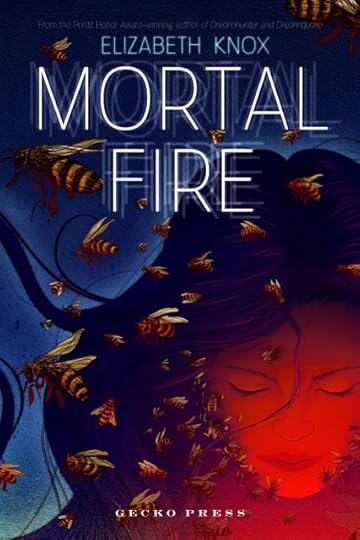
Elizabeth Knox: Mortal Fire (2013)
People often accuse me of taking a perverse angle on the texts I write about. I recall composing an essay on Angela Carter's wonderful novel The Infernal Desire Machines of Doctor Hoffman which was devoted almost entirely to the question of whether or not the book was set in South America.
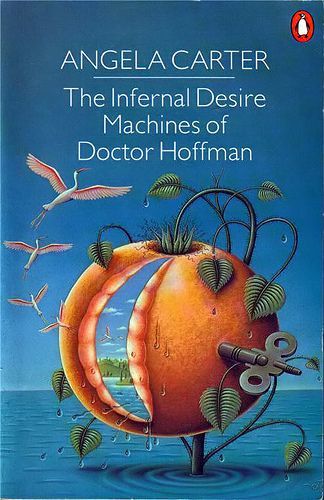
Angela Carter: The Infernal Desire Machines of Doctor Hoffman (1972)
This essay (eventually) formed part of my Doctoral thesis, and I recall my supervisor, Colin Manlove, saying two things in response to it:
What a wonderful book!What a bizarre and reductionist approach to take to it!In a sense I agreed with him, but given the thesis was about the various imaginative spins European writers had put on their own pet images of an increasingly imaginary continent they called 'South America,' the emphasis did seem an inevitable one. And it did allow me, contextually, to say a lot of other things about the novel as well.
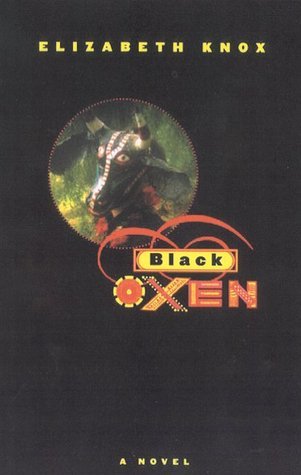
Elizabeth Knox: Black Oxen (2001)
Elizabeth Knox has already written her own Latin American epos, Black Oxen. In this post, though, I'll be continuing my reflections on Southland, her close-cousin-to-New-Zealand, albeit in a parallel time-line, mainly because she wrote another book set there, Mortal Fire, a few years after completing the Dreamhunter Duet.
I began my previous post on the subject with a quote, as follows:
Southland is a landmass without a native people, so there are not songs or legends for us to consult.This statement is not so much contradicted, as supplemented, towards the end of this new excursion to Southland, Mortal Fire:
'University isn't for us, eh.'The 'book' mentioned here is by Canny's brother Sholto - a restatement of his undergraduate essay about Southland, which I quote from further down. For the moment, though, let's just look at Knox's map of that 'mainland' again:
Jonno said ... 'If I get the job I'll be the first person from my family to go north in five hundred years.'
Jonno's 'five hundred years' made Canny forgive his 'not for us' remark. 'I love it that you can say that,' she said.
'You know, we all read your brother's book.'
'Your family?'
'Nope. All of us.'
He meant the Faesu, the people of the archipelago, Southland's first people, who had twice settled, and twice abandoned, the mainland. [412]

Elizabeth Knox: Southland (2013)
It seems, then, that Southland did once have an indigenous race, who 'twice settled, and twice abandoned' their lands. Why, one is tempted to ask? To clear them for white settlement?
Quite a few new parts of Southland's history are filled in in this new book, in various not too unsubtle versions of the old 'So tell me Professor, what did happen in the ...?' 'Well, my boy, I'm glad you asked me that. It was in the early -- hundreds that ...' trope so beloved of genre novelists generally.
Here's one example:
Ghislain took a breath and began: 'The Zarenes were one of the five Elprun families who ended their long wandering in Southland. The island of Elprus was destroyed by a volcanic eruption in - do you know this?'Mortal Fire is yet another of Knox's magical tales, based on yet another of the five Elprun families who caused all the trouble in Dreamhunter. Then it was the Haims; this time it's the Zarenes. The common feature in their magic, though, is the fact that it all stems in one way or another from the powerful supernatural forces unleashed by the raising of Lazarus in the New Testament.
'1715.'
'And the people of Elprus arrived in Southland?'
'1730. I'm good at dates. Sholto is always telling me snootily that history isn't all dates.'
'No, it's currants and raisins too.' [270]
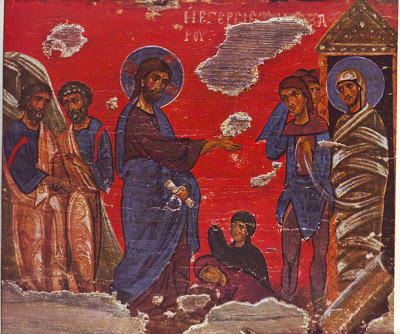
Christ's raising of Lazarus (12th-13th century CE)
I was actually asked to review Knox's book when it first came out, in 2013. It was frustrating to have so little space to discuss it, so I had to content myself with a few generalities on that occasion, but I do hope that I was able to make it clear just how much I admired the skill with which she managed her narrative, as well-populated with ideas as it was with people:
There was a time when I used to wait eagerly for each new Young Adult novel by Margaret Mahy. Starting with The Haunting in 1982, she had an extraordinary run of success in this very exigent genre. Come to think of it, there was a time before that when I used to read Maurice Gee’s Halfmen of O series with something of the same feelings of fascination and awe.
I don’t know what Elizabeth Knox’s future plans include (perhaps she doesn’t either), but I have to say that I would be very sorry indeed if she stopped publishing teenage fantasy novels such as Mortal Fire (and its predecessors, the Dreamhunter Duet, also set in her imaginary republic of Southland). I don’t think it’s any exaggeration to say that her books are every bit as good as Mahy’s and Gee’s, but with an extra edge and sophistication belonging solely to her.
That’s not to say that Mortal Fire is easy to read. In fact, there were moments in the first couple of chapters where I found it quite hard to assimilate the sheer weight of information she throws at her reader. Once the story really gets going, though, with Canny Mochrie and her step-brother Sholto’s arrival in the Zarene valley, any such obstacles melt away. This is not a book which could ever be exhausted on one run-through, though.
For myself, I like a bit of a tussle with ethical responsibilities in the dreamworlds of fantasy, and Mortal Fire does not disappoint in this respect. It’s hard to imagine any other New Zealand writer so adroitly mixing a plotline based on the Pike River Mine disaster into the rest of her narrative (though I suppose one might have anticipated it from her use of the Cave Creek disaster in her previous adult fantasy novel Daylight).
Southland is a useful palimpsest for Knox: a new land which can be overlaid with just enough of the actual history of New Zealand to make it relevant to the specific aspects of our culture she wants to examine, but which is also “fictional” enough to combine them with the powerful symbolic realms of magic which interest her just as much.
She does, after all, at the end of the day, have the central duty of constructing an interesting story. And this one adds race and class prejudice to the starker issues of crime and punishment from the Dreamhunter Duet. It’s worth emphasising, though, that this novel can be read and enjoyed without any knowledge of the earlier books. It is, after all, set fifty years after the events in those stories, referred to only in passing towards the end of Mortal Fire.- Jack Ross: "Wearing their ethics on their sleeves." NZ Books: A Quarterly Review vol. 23, no. 3, issue 103 (Spring 2013): 16-17.
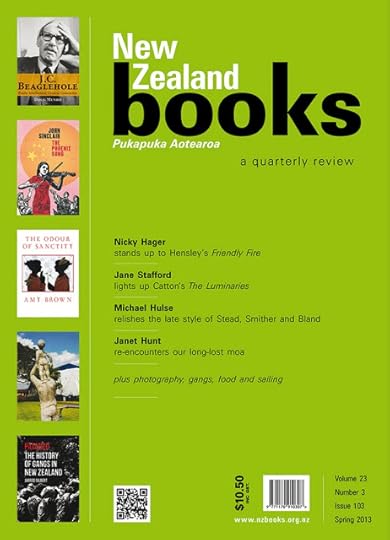
NZ Books 103 (Spring 2013)
I'm sorry that it's taken me this long to get round to saying some more about that 'useful palimpsest' - Knox's choice of:
a new land which can be overlaid with just enough of the actual history of New Zealand to make it relevant to the specific aspects of our culture she wants to examine, but which is also 'fictional' enough to combine them with the powerful symbolic realms of magic which interest her just as much.One advantage of the wait, however, is that she's now made her own statement about the novel, on her author's website, which is also where I borrowed the map of Southland (above) from:
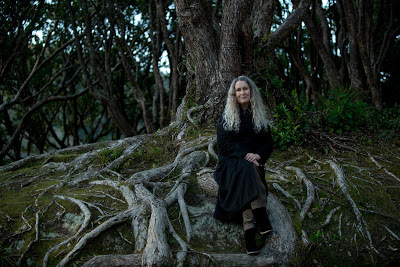
Grant Maiden: Elizabeth Knox
David Larsen, interviewing me for The Listener, wanted to know why I’d set the book in 1959. It’s a big decision with a huge input into the flavour of the book, but it was one I came to kind of expediently – although very happily. I’d decided one of the defining characteristics of my protagonist, Canny, was that she had a mother who was a heroine. And that Sisema was the kind of heroine who becomes more celebrated as time goes on, because her story is one that her Nation’s identity is forming around. I decided that this would work best if Sisema was a war hero. That immediately led me to World War Two and a Pacific island occupied by Japan. I’m not going to tell Sisema’s war story here, but this decision gave me a possible date for Canny’s birth. I wanted to write about a sixteen-year-old, and my addition gave me the year 1959. To my amused exasperation one mostly very positive review on Goodreads worries that Canny sounds “young for her age compared to US teenagers I know”. Perhaps – the reviewer writes – that’s because she comes from this New Zealand-like place and maybe teens grow up slower there. And I’m reading this and going like, “Um – it’s 1959.”
Beekeeping. I wanted to set my story in a pastoral paradise. The Zarene Valley is kind of based on valleys now beneath Lake Dunstan. Those now-drowned valleys circa 1981, when I was down there with my sister and some friends (touring about in a 1957 Plymouth station wagon). Back then there were no vineyards, and more kiwi holidaymakers than tourists. 1981 is pretty much equidistant from 1959 and 2013, but it was more like 1959. Also I felt that I was in some ways writing the book for my editor, Frances Foster. I was thinking of her as a first reader. And I remembered how, when I met Frances at the Disney Convention Centre in 2008, when I was there for the American Library Association Conference, she told me about being a child visiting her grandparents’ farm in Anaheim, back before Disneyland bought up all the land. I remember her description of the pastoral paradise now under the theme park and hotels and highways. So – old Anaheim, and the apricot orchards under Lake Dunstan, are what made the Zarene Valley.- Elizabeth Knox: "Letting in the Ghosts: Why certain things are in Mortal Fire." Elizabeth Knox: Author's Website (c. June 2013)

Lake Dunstan (2018)
I think that I might have guessed that detail about the lost orchards around Cromwell, along with that still contentious dam on the Clutha river, but for the most part I'm struck by how sedulously she sticks to personal details, and how little she gives away about the larger questions behind the novel ...
Why, for instance, has Southland now been supplied with a native race, and even an island protectorates off in the Pacific?
Cyrus said to Sholto, 'But she's not your sister, is she?'
'She's my stepsister.'
Canny's mother is Sisema Afa,' Susan said. 'The war hero.'
'So she's not a Southlander?'
The young man looked irritated. 'The Shackles are a protectorate of Southland.'
Cyrus thought, 'Any minute now he'll accuse me of bigotry.'
'Shackle islanders have citizenship,' Sholto went on, then added, 'whether you like it or not.'
Cyrus laughed. 'I didn't mean any offense. I was only curious. I hope my amateur curiosity is acceptable to you, as opposed to your professional one.' [213]
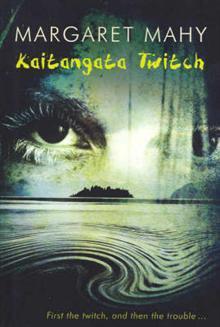
Margaret Mahy: Kaitangata Twitch (2005)
It's interesting, too, that Knox should choose to employ a brown-skinned rather than a white-skinned heroine this time - a little like the TV producers of Margaret Mahy's Kaitangata Twist, who changed its originally white heroine for a Māori Meredith instead.
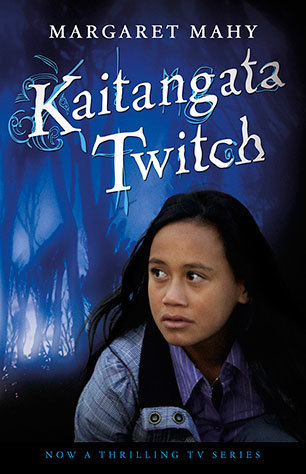
Margaret Mahy: Kaitangata Twitch (2010)
That may sound like mere tokenism, but I have to say that the substitution immediately made better sense of Mahy's story - and it's now hard to imagine the narrative any other way. The TV Meredith's motivation is far easier to understand than that of her novelistic counterpart.
Is the same true of Knox's narrative? It's hard to say. I do feel that she must have feared some co-option of her stories by 'Celtic New Zealand' fanatics if she didn't acknowledge this gap in the first two novels - so seized the opportunity to elaborate creatively on the larger Oceanic context of her imaginary island in this way. After all, any version of New Zealand without Māori is a little difficult to justify ...
'Yes,' Sholto said. He knew that the [Lazuli] dam was first planned in the mid-1920s. If it had been built it would have flooded the Zarene Valley and drowned all the orchards. The plans were shelved after the stock market crash, resurrected in 1938, and shelved again when Southland went to war in 1941. [179]Why, too, did Southland go to war in 1941 rather than in 1939? The rest of the dates here sound reasonably compatible with those in our own 'real' world. Presumably it must have been because Southland is a republic, not a monarchy, and therefore affiliates more naturally with the United States than the United Kingdom.
Calvary was the only sizable town on the Shackle Island chain ... The Shackle Islands produced sugar and, lately, copper. The islands were peopled by their original inhabitants, the Ma'eu; by the descendants of cane cutters brought to the island by blackbirders in the late eighteenth century; and by the descendants of colonial settlers, most of whom had originally come from Southland. [49]The Pacific paradise of the Shackle Islands has experienced far less of a 'fatal impact' than the real Polynesian islands on which it's presumably based, but I suppose the essence of a parallel time-stream is that you can alter the dates of events, and thus alter their consequences.
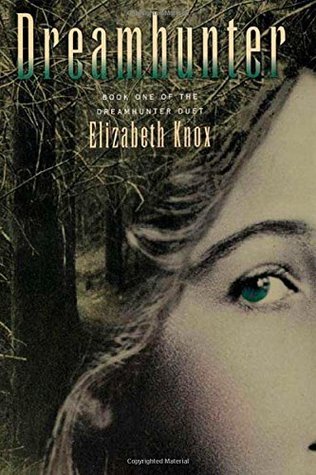
Elizabeth Knox: Dreamhunter (2005)
Perhaps the most vital change is expressed by Canny's would-be-historian brother Sholto, in his own overarching theory of Southland:
'He was a dreamhunter!' said Sholto.
'Ranger,' said the barber. 'He was making photographic landmark maps for the Dream Regulatory Body.'
The silence of loss came into the room.
As an undergraduate Sholto had once tried to write an essay about this. The Professor said that it was very interesting, but was Sholto trying to invent a new kind of history? One without historical references and facts? Sholto's essay argued something like this: Southland was a big country, with a population that was sufficiently large but not too large; with industry and a wealth of minerals, with scientifically developed agriculture, good roads, and rail, three deepwater harbors, some fine universities - so why wasn't it more of a player on the world stage? Sholto's answer to his essay's question was that Southlanders were in a sense a sad and defeated people. They were people who had once lived in a beautiful house, which had burned down ... Southlanders had had something irreplaceable - the Place, a mysterious territory where some could go and catch dreams that they could perform for others - they had that miraculous thing, and they lost it.
[183-84]
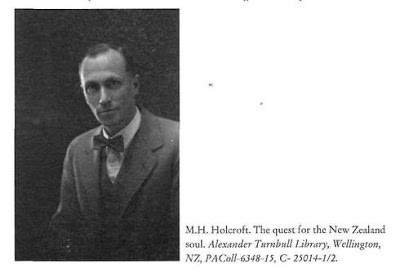
Michael Grimshaw: Believing in 'New Zealand': The South Island Myth revisited (2016)
Am I wrong to hear in this thesis of Sholto's about the 'silence of loss' in Southland culture a distant echo of such portentous 'whither Aotearoa?' essays as Monte Holcroft's The Waiting Hills (1943) or even, perhaps more plausibly, Bill Pearson's classic 'Fretful Sleepers' (1952)?
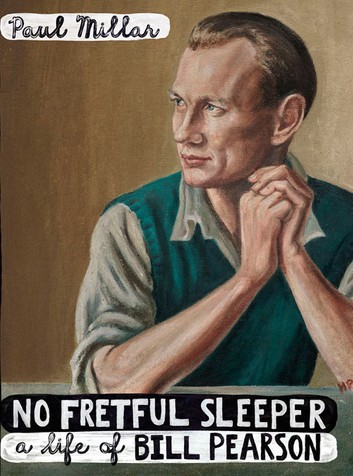
Paul Millar: No Fretful Sleeper (2010)
Some sense of isolation is inevitable, some detachment and discrimination, but that is the occupational hazard of every artists and especially of the novelist who must always be, so long as there are conflicts within his society, something of a spy in enemy territory. The thing to avoid is developing one’s isolation because that way lies desiccation, etiolation, clique-writing that will get yellow in manuscript and deserve to. Emigration is no solution, even for the novelist or dramatist to whom ideas are more important than sense-impressions. There is stimulation at first, a sense of expansion – but in England the artist’s loneliness that we have known longer is beginning to be felt, and publishing, because of rearmament and American stockpiling of paper, is getting costly and difficult, and liberties of thought are slipping away too. But after the stimulation you will dry up: you can neither feel completely at home in your adopted country, not enough to write deeply of it, nor can you write of your own country except through a mist of nostalgia and unappeased resentments. We New Zealanders have far less in common with the English middle classes than we may think and at best they will patronize us and emasculate us. We could no more lose our national habits if we were to try, than we could, if we wanted to, disguise our kiwi twang. Our accent stands out a mile and the time will come when so does the accent of our literature, but not before we have a social system that makes possible the meaningful liberation of the talents and energies of the common people. Until then there is hard work to be done, there are quiet mortifications to be suffered, humiliations and misunderstandings to be put up with, and yet one will meet a lot of cheerfulness to ease the effort.
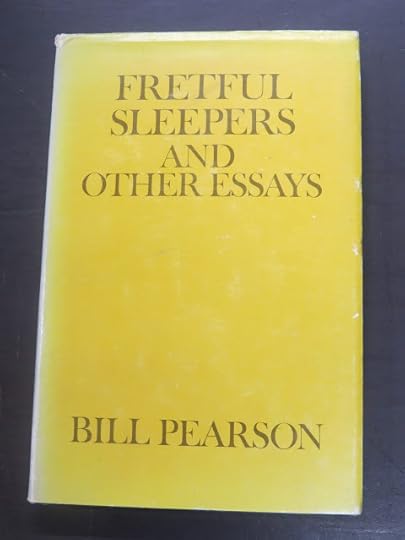
Bill Pearson: Fretful Sleepers and Other Essays (1974)
We're doomed to be Kiwis, in other words - so we'd better get used to it, and try to do a good job.
To conclude, then, what is Elizabeth Knox's 'Southland' trilogy really about? Many things, certainly - state oppression; the responsibilities underlying fantasy, the free flow of the imagination; class; families, magic; bees; ice-cream ... There are lovely evocations of her mirror versions of actual New Zealand cities - Castlereagh / Wellington, for instance:
Castlereagh was all hills, ridges around the harbor, and steep-sided valleys where the desirable houses were built up high to catch either the morning or the afternoon sun. Much of the inner city dated from the time when cars were rare, so roads were narrow and steep and many lacked footpaths. Instead there were dozens of ... official and unofficial shortcuts, steps and paths, some with safety rails, some without. The citizens of Castlereagh had strong hearts and big calf muscles. [34]Predictably, Founderston / Auckland is rather further from the reality of our own garish Big Smoke.
Unlike Elizabeth Knox, Austin Tappan Wright did not live to write any sequels to his own vision of Islandia in the mid-1900s. This deficiency was partially made up for, however, by the editor of his novel, Mark Saxton:
There are also three sequels/prequels ... Reviewers describe these books as entertaining and self-contained. The prequels concern events that are mentioned briefly in the original novel, and are likely based on Wright's unpublished notes. All three books were published with the permission of Wright's estate. Sylvia Wright, Wright's daughter and the executrix of the estate, died shortly before the third Saxton book was completed, and there have been no additional books since.
The Islar, Islandia Today - A Narrative of Lang III. Published in 1969, this book is set in the then-present day. The plot concerns a coup attempt in Islandia that occurs while the national government is debating whether to join the United Nations. The protagonist, as indicated in the title, is John Lang's grandson.The Two Kingdoms, published in 1979, is a prequel set in the 14th century. The plot concerns the events surrounding the reign of the only female ruler in Islandian history, and the dynastic change that ensued from this.Havoc in Islandia, published in 1982, is yet another prequel, set in the 12th century. The Roman Catholic Church attempts to overthrow the government of Islandia, and, having failed, is itself expelled from the country (parallel to the expulsion of Christians from Japan).
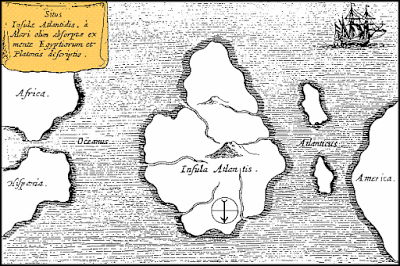
Athanasius Kircher: Mundus Subterraneus (1669))
It must be very difficult to leave behind any imaginary kingdom so fully formed as these two are (as Plato must have discovered, when he kept on returning to his original inspiration in the successive, not really fully consistent, dialogues Timaeus, Critias and the unfinished Hermocrates).
J. R. R Tolkien, too, at one point in his unending struggles with the unfinished (unfinishable?) Silmarilion, started to draft a sequel to the Lord of the Rings where the rebellious youth of Gondor had developed a fashion of dressing up as Orcs and fetishising the vanished Dark Lord, rather like the skinheads and Neo-Nazis of his own time.
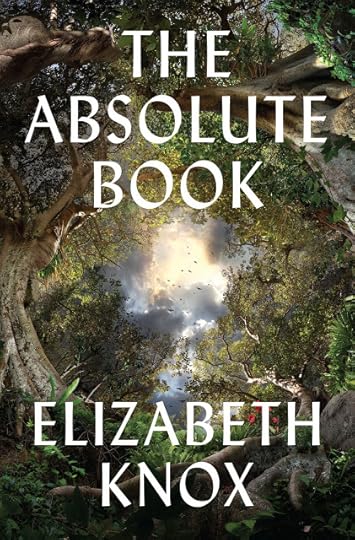
Elizabeth Knox: The Absolute Book (2019)
I haven't been privileged (this time) to see an advance copy of Knox's new novel, The Absolute Book, due out from VUP in September this year, but judging from the blurb description of it as:
a book of journeys and returns, set in London, Norfolk, and the Wye Valley; in Auckland, New Zealand; in the Island of Apples and Summer Road of the Sidhe; at Hell’s Gate; in the Tacit with its tombs; and in the hospitals and train stations of Purgatory.it's pretty safe to say that she's managed to break free of her own island paradise - for now, at least - though possibly at the expense of an even more perilous sojourn in the Forbidden Realms of Faerie.
•
Published on July 29, 2019 17:15
July 21, 2019
Islomanes (2): Elizabeth Knox's 'Southland'

Elizabeth Knox: Southland (2013)
Southland is a landmass without a native people. so there are not songs or legends for us to consult.- Dr Michael King, A History of Southland (1904)
Elizabeth Knox's imaginary country of 'Southland', the setting for her two Dreamhunter novels and their sequel Mortal Fire, continues to fascinate me.
On the one hand, it's clearly New Zealand - albeit a New Zealand through the looking-glass, a Mirror City version of the rather less tidy set of islands we actually inhabit.
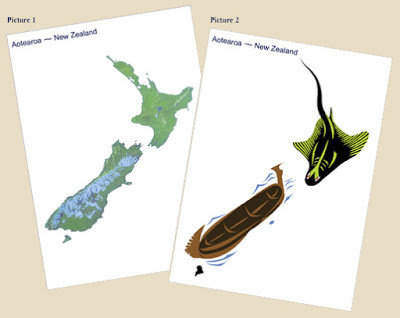
Te Ika-a-Māui & Te Waipounamu (2013)
On the other hand, there are several vital differences in this alternative history version of our country.
The first one is mentioned above. The extracts from Dr King's imaginary history of this 'landmass', quoted from Knox's novel Dreamhunter (2005) - incidentally, note the symmetry between the 1905 the story is set in, and the 2005 of the novel itself - mentions 'the arrival of the first settlers nearly two hundred and fifty years ago."
In other words, the late eighteen, early nineteenth century of the real settlement of New Zealand, has been moved back to 1650 or so - back to the approximate time of Abel Tasman's drive-by in 1642, in fact. What if New Zealand hadn't already been settled by 'a native people' with their own 'songs or legends to consult'? What if Tasman had gone ashore, established 'a fort and a river port'? Perhaps a town called Founderston would have been the result ...

Elizabeth Knox: Dreamhunter (2005)
The second major difference between 'us' and 'them' is described as follows in Dr. King's history:
Excerpts from 'The Invisible Road', a chapter from Dr Michael King's A History of Southland (1904):The real Michael King had, alas, died in a car crash before these words were published. His immensely successful Penguin History of New Zealand (2003), which clearly inspired this mirror history, is written in much the same bland yet authoritative style.It is difficult to convey to anyone beyond our shores the extraordinary influence of dreamhunting on the life and culture of Southland. Since the arrival of the first settlers nearly two hundred and fifty years ago much has been made of the tyranny of distance, the fifteen hundred sea miles between ourselves and our nearest neighbour, and five thousand between us and the great centres of civilisation. Ours is a productive but isolated country. Southland can export wool and leather, but not meat or milk; wine, but not fruit; grain and linen, steel, tools and machinery - but not dreams. Dreams are a highly perishable commodity and are yet to be sent offshore. [73]
Interestingly, in this version of history refrigeration appears to have not yet been trialled. In reality, of course, the first cargo of refrigerated meat left New Zealand for Britain in 1882.

Elizabeth Knox: Dreamquake (2007)
So what exactly are these dreams King makes so much of? Their use and abuse is the main subject of Knox's fascinating story. They are found in a part of the country called 'the place', which can only be entered by certain people with a hereditary disposition. Of these, only a few can catch the dreams which are localised in certain parts of the realm. Here's a map of 'the place' from the endpapers of Dreamhunter:
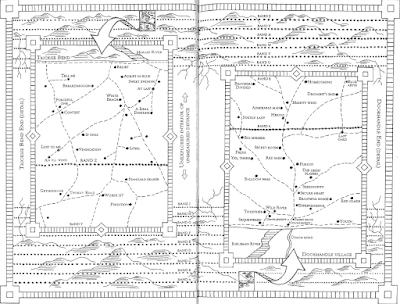
Elizabeth Knox: Dreamhunter (2005)
Note the dots with strange names beside them: these are the resident dreams to be found there by those gifted enough to retain them, and then redream them for the public in specially constructed dream palaces.
And here's the section of the country, in the very North (looking a bit like Farewell Spit in Golden Bay) where the almost illimitable 'place' can be found:
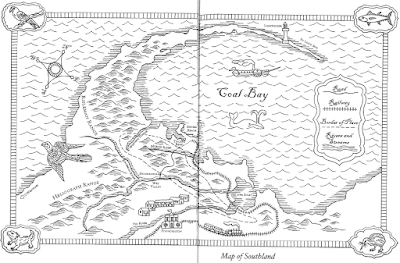
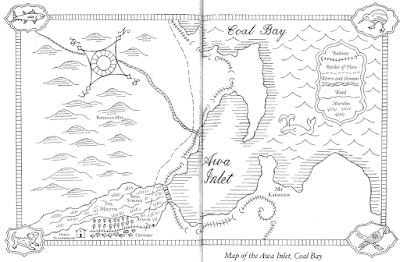
Elizabeth Knox: Dreamquake (2007)
If we try to narrow in on precisely what dreams are - or rather what they are like - the following conversation between Rose Tiebold (one of the two adolescent girl protagonists) and her father Chorley may give us some clues:
'Mother can catch horned whales, a dream of horned whales. Dreams have sound and sensations, colours and tastes. Films don't.'Is it too much of a stretch to see this conversation as referring to fiction - and creative writing in general - under the guise of these metaphorical dreams? There's a reference later on, in Dreamquake (2007), the sequel to Dreamcatcher, to certain distinctions between dreamers:
'So you think films are only a novelty?' Chorley asked his daughter.
'No - but they're for recording facts. They can't do fiction, like dreams can.'
'Has anyone been able to establish that dreams are fiction rather than fact? They may all be true. They might be like a mirage - a strange image of a distant place, some spot in the world very like here. No one knows what they really are.' [71]
Jerome Tilley, one of the rare Novelists (as those who caught split dreams [dreams from more than one point of view] were called) [379]As well as this, there are 'Gifters' - those 'who can take [their] own memories of real people's faces and manners, and graft them onto the characters in the dreams [they've caught]' [354]; 'Soporifs', who can 'enhance the effects of anaesthetics' [285]; and the illegal 'Colourists,' who can insert little extra ideas, such as the desirability of retaining certain officials past their allotted term, into the edges of someone else's dream narrative.
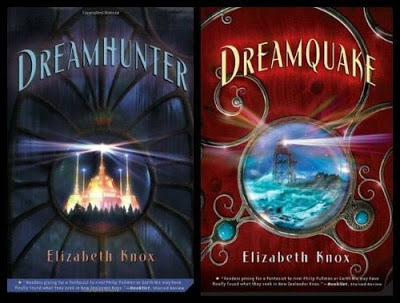
Elizabeth Knox: The Dreamhunter Duet (2005-7)
Elizabeth Knox's inaugural Margaret Mahy Lecture in 2014 was entitled "An Unreal House Filled with Real Storms" (presumably a reference to Marianne Moore's famous poem Poetry and its "imaginary gardens with real toads in them'). In both cases the emphasis seems to be both on the close interconnectedness of the 'unreal' worlds of the imagination and the 'real' world of experience.
Or, as W. B. Yeats put it, even more trenchantly: 'In dreams begin responsibilties.' You are responsible for the products of your imagination. 'Did that play of mine send out / certain men the English shot?' as he demanded of himself in one of his very last poems, 'The Man and the Echo' (1938).
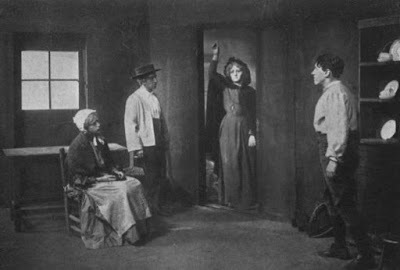
W.B. Yeats’ Cathleen ni Houlihan (1902)
In other words, did his early play Cathleen ni Houlihan (1902), with its striking final image of the bent old beggar woman suddenly straightening up into the magnificent young nationalist firebrand Maud Gonne - the very embodiment of Ireland herself - provide an important motive for at least some of those killed in the tragic Easter Rising of 1916? It's a bit of a stretch, perhaps, but not - given the sheer incantatory power of his imagination - an unreasonable one.
Does Elizabeth Knox see herself as a mythmaker on that level? A 'novelist', what's more, a dreamer with the power of capturing more than one point of view - unlike the short story writers and poets who are more common among us?
That may sound a bit conceited, but it really isn't, given the status of her imagination here in New Zealand. If so, what might she be trying to tell us in this parable of hers?
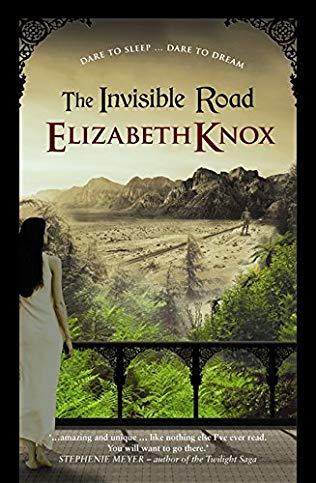
Elizabeth Knox: The Invisible Road (2008)
Why, to begin with, does it have to be 'without a native people,' unlike the actual New Zealand? On the surface, this might seem to have analogies with Austin Wright's choice to make his imaginary 'Islandia' more than a thousand years old - a chronology similar to that of Iceland, in fact.
Given the obvious analogies between Wright's visionary state and the actual South Africa ('Bants' for 'Bantu', German colonies across the border, Arabs up the coast, etc. etc.), this works to substantiate the Afrikaaner myth that their migration into the hinterland took place at the same time (or even before) the Bantu migration south - caused by the devastating mfecane wars in the early nineteenth century.
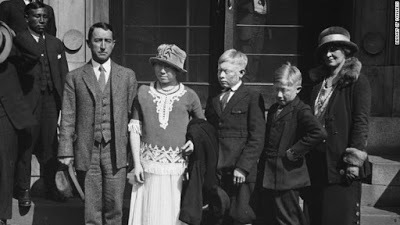
Richard Marsh: 'White Indians' - obviously albinos - from Panama (1924)
Wright's idealised Afrikaaners therefore have a superior right to the land they inhabit than the Black races who surround them on all sides (particularly the violent and destructive 'Mountain Bants' immediately across the border). It resembles more than a little the various racist myths of an initial white settlement in America predating the arrival of the 'Indians' themselves.
We have more than our fair share of such self-serving colonialist 'theories' in New Zealand also. Note what Knox herself has to say about the early settlement of her 'Southland,' though:
He [Sandy] had already done the Hames and history. He knew - for instance - that they were one of five families who had come to the country from the island of Elprus after a volcanic eruption. The Elpra who crossed the seas all settled in Founderston - then a jerry-built settlement around a fort and river port. They were welcomed for their highly cultivated skills in silk making - and for the relics, the bones of St Lazarus. ... The islanders stayed together as a people in the streets they built, in what, over the centuries, became Founderston's Old Town. In fact, up until eighty years before Sandy was born, the Old Town was predominantly peopled by the dark-skinned, curly-haired people, and would be still, were it not for a cholera epidemic, and the two contaminated wells in the Old Town which caused more than half the epidemic's deaths. [214]These violin-playing, textile-savvy, 'dark-skinned, curly-haired people' sound more like Jews or Gypsies than the solid Anglo-Saxons who seem to make up most of the rest of the population.
Southland, after all, has at least seven major towns, most of them named after British and European statesmen, just like so many cities ([George Eden, Lord] Auckland, Governor-General of India, 1836-42 - [Admiral Horatio] Nelson, victor at Trafalgar, 1805 - [Arthur Wellesley, Duke of] Wellington, victor at Waterloo, 1815, British PM, 1828-30 & 1834) in New Zealand itself:
FounderstonMetternich [Austrian Foreign Minister, 1821-48]WestportMiddleton [a suburb of Christchurch]Castlereagh [British Foreign Minister, 1812-22]Canning [British Prime Minister, 1827]Esperance [French for 'hope' = Akaroa?]
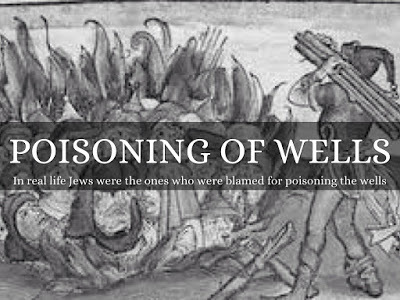
The Black Death (2015)
The comments about the 'contaminated wells' are particularly disturbing, given the long history of Christians accusing Jews of poisoning wells to cause epidemics. There's an atmosphere of pogroms and racial prejudice lurking under the surface of the whole novel, in fact, as the ultra-white Secretary of the Interior Cas Doran and the President Garth Wilkinson plot to set up a quasi-fascist state in Southland.
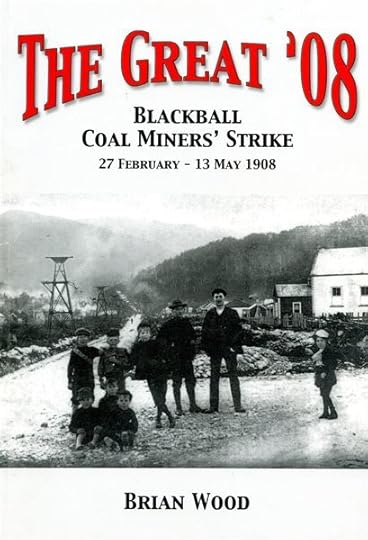
Brian Wood: The Great O8 (2008)
There's another interesting subtext in the novel, though, too: let's call it its Norma Rae moment - union, union, union!
Sandy felt herded and corralled. But he was the son of a shop steward in a factory that made flax matting. He had been raised in a house with strong views on the rights of working people. 'You know what we need?' he whispered to his uncle as they tramped along 'We need a union.' [354]

Sally Field in Norma Rae (1979)
Could Knox's 'Hames' have been Māori, rather than Greeks refugees? Possibly, but not without great difficulties when it came to introducing the Golems and other dream trappings her novel is constructed around. There would be an immense risk of giving cultural offence if she were to impose an entire mythology on the actual native race of New Zealand (however disguised).
I'm inclined to think that we may have to give her a free pass on this issue of eliminating the Māori from her alternative history version of New Zealand, then. It's not a question of simply scrubbing the question off the landscape, as in Peter Jackson's version of NZ-as-Tolkien's-Middle-earth. She's nothing if not a careful thinker about the consequences of her creative decisions (as you can see in Tara Black's witty cartoon below):

Tara Black: Ode to Ursula [Le Guin] (2018)
This is not the end of the discussion, however (heaven forbid!) For all its beauty and richness, I'm not sure that the Dreamhunter Duet did actually accomplish all that Knox intended to do with Southland, her imaginary kingdom by the sea. So she returned there, a few years later, in another YA fantasy novel called Mortal Fire ...
•

Elizabeth Knox
Elizabeth Fiona Knox
(b.1959)
Select Bibliography:
After Z-Hour. Wellington: Victoria University Press, 1987.
Treasure. Wellington: Victoria University Press, 1992.
Glamour and the Sea. Wellington: Victoria University Press, 1996.
The Vintner’s Luck: A Novel. 1998. Wellington: Victoria University Press, 1999.
The High Jump: A New Zealand Childhood. Pomare; Paremata; Tawa. 1989, 1994, 1998. Wellington: Victoria University Press, 2000.
Black Oxen. London: Chatto & Windus, 2001.
Billie’s Kiss. Wellington: Victoria University Press, 2002.
Daylight. Wellington: Victoria University Press, 2003.
Dreamhunter. Fourth Estate. Sydney: HarperCollins Publishers Pty Limited, 2005.
Dreamquake. Fourth Estate. London: HarperCollins Publishers, 2007.
The Invisible Road. 2005 & 2007. Harper Voyager. Sydney: HarperCollins Publishers Australia Pty Limited, 2008.
The Love School: Personal Essays. Wellington: Victoria University Press, 2008.
The Angel's Cut. Wellington: Victoria University Press, 2009.
Mortal Fire. Wellington: Gecko Press, 2013.
Wake. Wellington: Victoria University Press, 2013.
An Unreal House Filled with Real Storms. The Inaugural Margaret Mahy Lecture, Christchurch 31 August 2014. Wellington: Victoria University Press, 2014.
•
Published on July 21, 2019 16:13
July 13, 2019
Greeneland

Quentin Walsh: Travels in Greeneland (1985 / 2010)
Obsessed with “Greeneland,” the seedy, despair-filled imaginary of his novels, his biographers have ignored the world in which Greene immersed himself.- Maurice Walsh (2017)Is that really true? Is the 'despair-filled imaginary' of his novels (and films, and essays, and plays, and memoirs, and travel books) really a separable entity from the real world Graham Greene interrogated - and travelled through - so relentlessly?

John Lehman, ed.: Penguin New Writing 30 (1947)
I have an old copy of Penguin New Writing 30 (1947), edited by John Lehman, which includes a piece by Greene called "Across the Border: An Unfinished Novel." So far as I can tell, this wasn't reprinted until 2005, when it was included in his Complete Short Stories under the title "The Other Side of the Border" - mind you, that's just a guess, as I don't have the latter book to hand.
In any case, his 1947 introduction to this abandoned piece is very interesting. After lamenting the fact that "most novelists' careers are littered with abandoned books," he goes on to characterise this particular one as follows:
I could identify the year when I began to write it as probably 1937, after I had returned from a journey in Liberia: at any rate, if it had no other merit, the book seems to me stamped unmistakably with the atmosphere of the middle thirties - Hitler is still quite new, dictatorship is only a tang on the breeze blowing from Europe: in England is depression and a kind of metroland culture.I guess its the specificity of that evocation of the "atmosphere of the middle thirties" that intrigues me most. It's an atmosphere I can recognise from such novels as Orwell's Keep the Aspidistra Flying (1936), as well as - supremely - Greene's own England Made Me (1935). In fact Greene goes on to comment, of the latter novel:
Why did I abandon the book? I think for two main reasons - because another book, Brighton Rock, was more insistent to be written, and because I realised that I had already dealt with the main character in a story called England Made Me. Hands, I realised, had the same origin as Anthony Farrant in that novel.
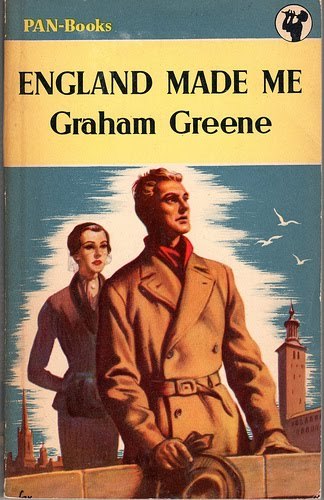
Graham Greene: England Made Me (1935)
England Made Me has always been one of my especial favourites among Greene's novels (along with The End of the Affair), I think because of that exquisitely precise evocation of atmosphere. It's depressing, yes, but in a very finely calculated way. I can still almost recite that final combination of seemingly irrelevant details, so meaningful in the context of what has gone before in the story:
"So you're going back to England?" Minty said, remembering the fifty-six stairs, the empty flat, the Italian woman on the third floor.The real pay-off in this little introduction comes at the end, however:
"No," Kate said. "I'm simply moving on. Like Anthony."
the incense cones, the cup (I've forgotten the cup).
"A job in Copenhagen."
the missal in the cupboard, the Madonna, the spider withering under the glass, a home from home.
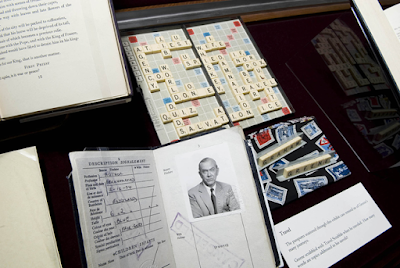
Graham Greene passport & ephemera (2016)
Another point interested me: since those days I have been back to live and work in the West African port described in Part II and I realise now that this picture of the place, its whole atmsophere, couldn't be more 'wrong.' I spent a week there in 1936 before this novel was begun, but now I know the port from a year's residence. It is every bit as seedy, depressed and drab as I have described it, but in a totally different way [my emphasis]. Denton of Part I on the other hand, which is the town in the Home Counties where I was born and brought up, seems to me right. Between the two lies the whole difference between the passport photograph and the family snapshot. [64-65]
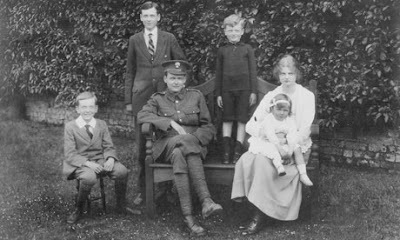
Greene famly portrait:
[l-to-r: Graham, Raymond, Herbert, Hugh, Molly & Elizabeth
"It is every bit as seedy, depressed and drab as I have described it, but in a totally different way." What an extraordinarily revealing thing to say! It's recorded that Greene used to enter routinely the 'write a passage in pastiche Graham Greene style" competitions in the British papers, but he never won. Generally he came second or third = or so we're told.
Perhaps it was the fine precision with which he judged degrees of seediness (as revealed above), the need to get each place's ration of drabness and despair precisely true to his experience of it which tripped him up, again and again.
There is a sense in which every Graham Greene setting and character resembles all the others - and yet the more interesting aspect of his work is the fine details and distinctions between them. The seaside town of Brighton of Brighton Rock is probably just as dangerous - to their respective protagonists, that is - as the garish Haiti of The Comedians, but there's an immense difference in decor and - clearly a crucial term for him - atmosphere.
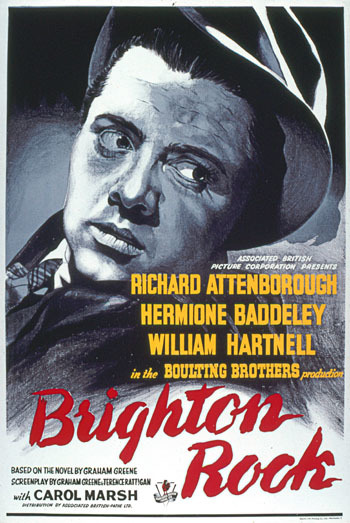
John Boulting, dir. Brighton Rock (1947)
I once undertook the interesting task of reading all of Graham Greene's novels in chronological order. It must have been in the early 80s, because I recall we'd been set Brighton Rock to read in one of my English papers at Auckland Uni. The first chapter put me off so much, that I found it difficult to continue, so I decided - precocious little budding Don that I must have been - that this would be the best way to achieve some understanding of it.
I don't know if it had the desired effect or not, but it was certainly a fascinating experience. It dispelled for good any idea I might have had that he simply wrote the same book over and over again (though there were still a few to come at that point).
So, yes, Greeneland - it's an excellent pun, and it accounts for a great many contemporary references to certain types of settings and characters which one tended to encounter quite frequently, both in life and literature, such as the following quip from his near-contemporary, W. H. Auden:
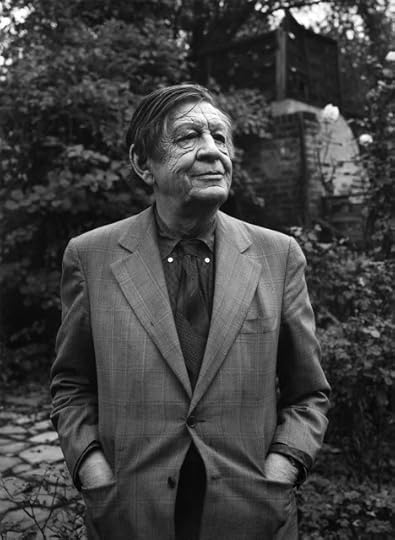
Yousuf Karsh: W. H. Auden (1972)
Is this a milieu where I mustIn reality, though, I think that Maurice Walsh may have a point. Too much has been made of the features the various provinces of Greeneland have in common with one another, and not enough of the different species of seediness and despair he was so concerned to differentiate.
How grahamgreeneish! How infra dig!
Snatch from the bottle in my bag
An analeptic swig?- W. H. Auden: On the Circuit (1965)
Much of it is, admittedly, attributable to the films of his work, which have a tendency to be more monochrome than the books they were based on - The Third Man, written originally for the screen, and only turned subsequently into a novella, is a case in point. Carol Reed's movie may be magnificent, but the story itself - judged purely as a piece of prose - is not really one of Greene's strongest.
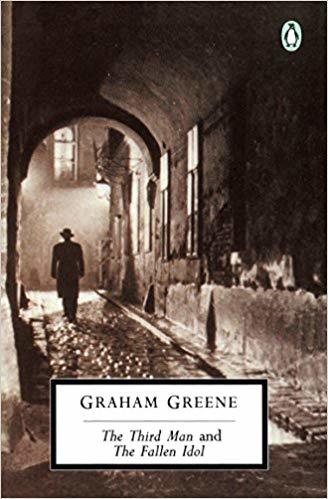
Graham Greene: The Third Man and the Fallen Idol (1950)
You'll notice some interesting features in the list below of my Greene-iana. It is, of course, incomplete - he was too prolific, too various in his activities to collect in toto.
There's one item there which may surprise you, though. Greene famously repudiated his second and third novels, The Name of Action (1930) and Rumour at Nightfall (1931). They've never been reprinted to this day. I was lucky enough to find a copy of the first in a library booksale, nestled among various other neglected cullings from the stacks.
•
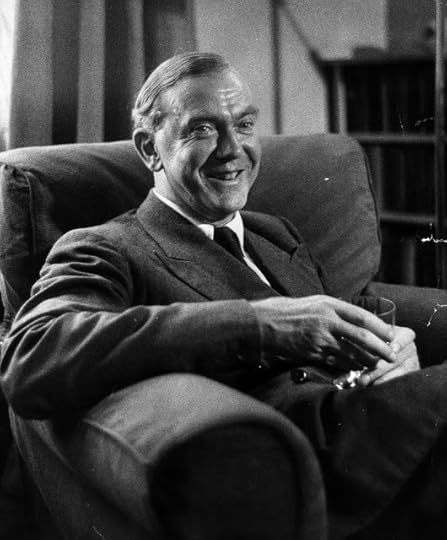
Kurt Hutton: Graham Greene (1954)
Henry Graham Greene
(1904-1991)
Graham Greene:
Novels:
Greene, Graham. The Man Within. 1929. Uniform Edition. London: William Heinemann Ltd., 1952.
Greene, Graham. The Name of Action. London: William Heinemann Ltd., 1930.
Greene, Graham. Stamboul Train: An Entertainment. 1932. The Library Edition of the Works of Graham Greene. London: William Heinemann Ltd., 1959.
Greene, Graham. It's a Battlefield. 1934. London: Pan Books Ltd., 1953.
Greene, Graham. It's a Battlefield. 1934. Introduction by the Author. The Collected Edition, 2. London: William Heinemann / The Bodley Head, 1970.
Greene, Graham. England Made Me. 1935. London: Pan Books Ltd., 1954.
Greene, Graham. A Gun for Sale. 1936. Introduction by the Author. The Collected Edition, 9. London: William Heinemann / The Bodley Head, 1973.
Greene, Graham. Brighton Rock. 1938. Uniform Edition. London: William Heinemann Ltd., 1947.
Greene, Graham. The Confidential Agent: An Entertainment. 1939. Harmondsworth: Penguin / London: William Heinemann Ltd., 1976.
Greene, Graham. The Power and the Glory. 1940. The Vanguard Library, 3. London: William Heinemann Ltd. / Chatto & Windus Ltd., 1954.
Greene, Graham. The Ministry of Fear: An Entertainment. 1943. Uniform Edition. London: William Heinemann Ltd., 1956.
Greene, Graham. The Heart of the Matter. 1948. London: The Reprint Society Ltd. / William Heinemann Ltd., 1950.
Greene, Graham. The Third Man and the Fallen Idol. Prefaces by the Author. 1950. London: Pan Books Ltd., 1955.
Greene, Graham. The Third Man: A Film by Graham Greene and Carol Reed. 1968. Modern Film Scripts. London: Lorrimer Publishing Limited, 1969.
Greene, Graham. The End of the Affair. 1951. Harmondsworth: Penguin / London: William Heinemann Ltd., 1978.
Greene, Graham. Loser Takes All. London: William Heinemann Ltd., 1955.
Greene, Graham. The Quiet American. 1955. World Books. London: The Reprint Society Ltd. / William Heinemann Ltd., 1957.
Greene, Graham. The Quiet American: Text and Criticism. 1955. Ed. John Clark Pratt. The Viking Critical Library. New York: Penguin, 1996.
Greene, Graham. Our Man in Havana: An Entertainment. London: William Heinemann Ltd., 1958.
Greene, Graham. A Burnt-Out Case. 1961. London: The Reprint Society Ltd. / William Heinemann Ltd., 1962.
Greene, Graham. The Comedians. 1966. Melbourne: Readers Book Club, 165. / London: William The Companion Book Club, 1967.
Greene, Graham. Travels with My Aunt. 1969. Harmondsworth: Penguin / London: The Bodley Head, 1972.
Greene, Graham. The Honorary Consul. 1973. London: Book Club Associates / The Bodley Head, 1974.
Greene, Graham. The Human Factor. 1978. Harmondsworth: Penguin, 1978.
Greene, Graham. Doctor Fischer of Geneva, or The Bomb Party. London: The Bodley Head, 1980.
Greene, Graham. Monsignor Quixote. 1982. Harmondsworth: Penguin, 1984.
Greene, Graham. The Tenth Man. 1985. Harmondsworth: Penguin, 1986.
Greene, Graham. The Captain and the Enemy. 1988. Harmondsworth: Penguin / London: Reinhardt Books Ltd., 1989.
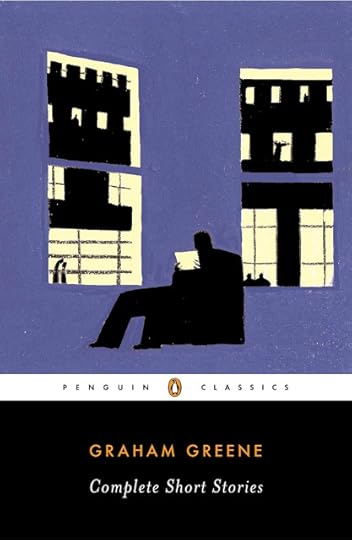
Graham Greene: The Complete Short Stories (2005)
Short Stories:
Greene, Graham. Twenty-One Stories. 1947 & 1954. Harmondsworth: Penguin, 1970.
Greene, Graham. A Sense of Reality. 1963. Harmondsworth: Penguin, 1970.
Greene, Graham. May We Borrow Your Husband? And Other Comedies of the Sexual Life. London: The Bodley Head Ltd., 1967.
Greene, Graham. The Last Word and Other Stories. 1990. Harmondsworth: Penguin / London: Reinhardt Books Ltd., 1991.
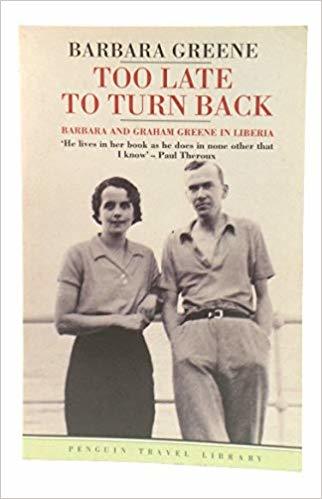
Barbara Greene: Too Late to Turn Back (1981)
Travel:
Greene, Graham. Journey Without Maps: A Travel Book. 1936. Uniform Edition. London: William Heinemann Ltd., 1962.
Greene, Graham. The Lawless Roads. 1939. Harmondsworth: Penguin / London: William Heinemann Ltd., 1971.
Greene, Graham. In Search of a Character: Two African Journals. 1961. Harmondsworth: Penguin / London: The Bodley Head, 1977.
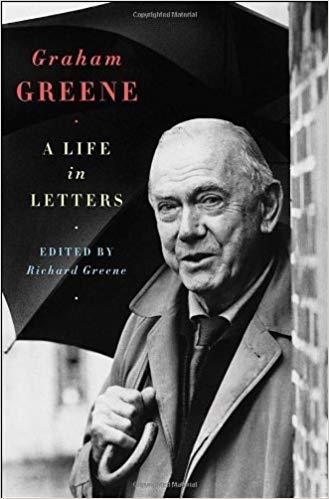
Richard Greene, ed.:
Autobiography:
Greene, Graham. A Sort of Life. 1971. Harmondsworth: Penguin / London: The Bodley Head, 1974.
Greene, Graham. Ways of Escape. 1980. Harmondsworth: Penguin, 1981.
Greene, Graham. Getting to Know the General: The Story of an Involvement. London: The Bodley Head Ltd., 1984.
Greene, Graham. A World of My Own: A Dream Diary. 1992. Harmondsworth: Penguin, 1993.
Greene, Richard, ed. Graham Greene: A Life in Letters. 2007. New York & London: W. W. Norton & Company, Inc., 2008.
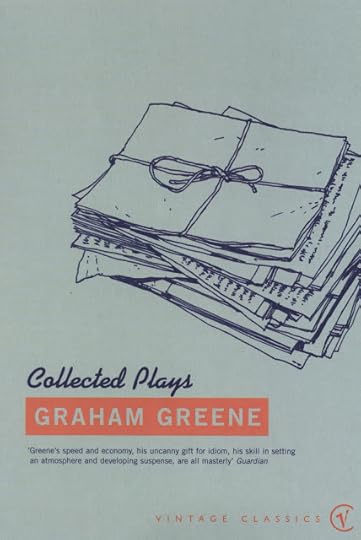
Graham Greene: Collected Plays (1985)
Plays:
Greene, Graham. Three Plays: The Living Room / The Potting Shed / The Complaisant Lover. 1953, 1957 & 1959. Mercury Books, 15. London: The Heinemann Group of Publishers, 1962.
Greene, Graham. The Return of A. J. Raffles: An Edwardian Comedy in Three Acts Based Somewhat Loosely on E. W. Hornung’s Characters in The Amateur Cracksman. 1975. Penguin Plays. Harmondsworth: Penguin, 1978.
Greene, Graham. Collected Plays: The Living Room / The Potting Shed / The Complaisant Lover / Carving a Statue / The Return of A. J. Raffles / The Great Jowett / Yes and No / For Whom the Bell Chimes. 1953, 1958, 1959, 1964, 1975, 1981, 1983. Harmondsworth: Penguin, 1985.
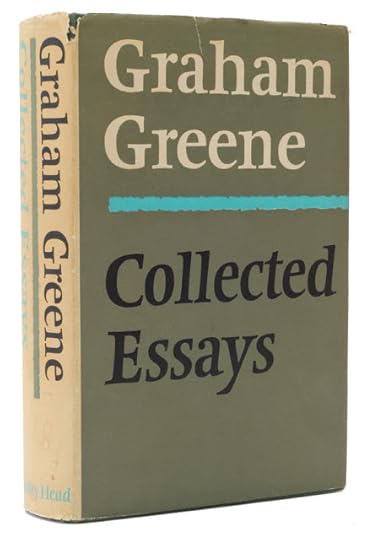
Graham Greene: Collected Essays (1969)
Miscellaneous Prose:
Greene, Graham. The Lost Childhood and Other Essays. 1951. London: Eyre & Spottiswoode (Publishers) Ltd., 1954.
Greene, Graham. Collected Essays. London: The Bodley Head Ltd., 1969.
Greene, Graham. The Pleasure-Dome: The Collected Film Criticism, 1935-40. Ed. John Russell Taylor. 1972. Oxford: Oxford University Press, 1980.
Greene, Graham. Lord Rochester's Monkey: Being the life of John Wilmot, Second Earl of Rochester. London: The Bodley Head Limited, 1974.
Greene, Graham. J'Accuse: The Dark Side of Nice. London: The Bodley Head Ltd., 1982.
Greene, Graham. Yours, etc.: Letters to the Press, 1945-89. Ed. Christopher Hawtree. Viking. London: Reinhardt Books Ltd. / Harmondsworth: Penguin, 1989.
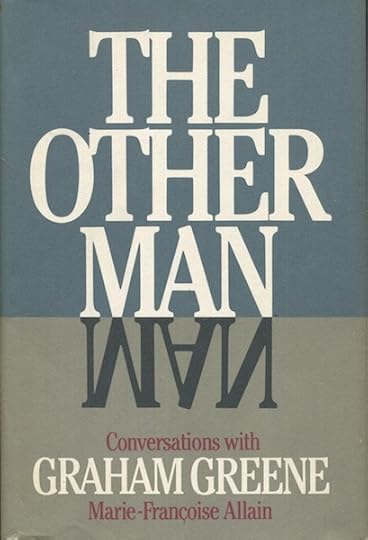
Marie-Françoise Allain: The Other Man (1983)
Secondary:
Allain, Marie-Françoise. The Other Man: Conversations with Graham Greene. 1981. Trans. Guido Waldman. London: The Bodley Head Ltd., 1982.
Sherry, Norman. The Life of Graham Greene. Volume One: 1904-1939. London: Jonathan Cape Ltd., 1989.
Sherry, Norman. The Life of Graham Greene. Volume Two: 1939-1955. 1994. New York: Viking Penguin, 1995.
Sherry, Norman. The Life of Graham Greene. Volume Three: 1955-1991. London: Jonathan Cape Ltd., 2004.
Published on July 13, 2019 20:50
June 29, 2019
Islomanes (1): Austin Tappan Wright's Islandia

Alberto Manguel & Gianni Guadalupi: The Dictionary of Imaginary Places (1980)
'Now,' he said as we left the bridge and walked into Anglesey, 'now you are like Robinson Crusoe, you are on your island. How should you like to live in that house all the year round, winter and summer?' he said pointing at a white house on a little rock island in the straits. I said I thought there might be worse places. 'They live like fighting cocks there,' winked the old man with the merry twinkle in his eye and his tall white hat nodding from side to side. 'They have got a weir there and they catch all the fish.'- Kilvert’s Diary: Selections from the Diary of the Rev. Francis Kilvert, 1 January 1870 - 13 March 1879. 3 vols. Ed. William Plomer. 1938 (London: Jonathan Cape, 1977): I: 360.
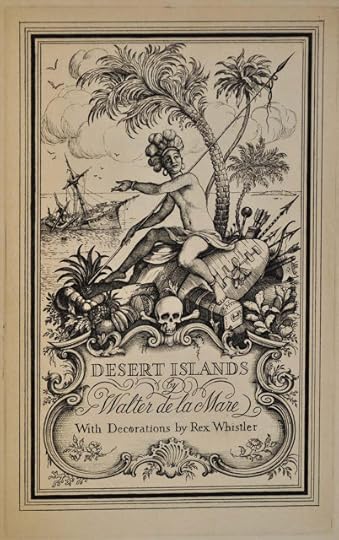
Walter de la Mare: Desert Islands and Robinson Crusoe (1930)
The fascination of islands and island living is something a great many people have written about. English poet and whimsical anthologist Walter de la Mare devoted an entire book to the subject, and of course that old reprobate Lawrence Durrell also had a good deal to say on the subject as well:
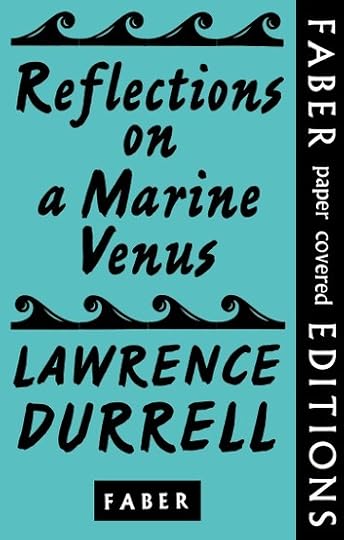
Lawrence Durrell: Reflections on a Marine Venus (1953)
Somewhere among the notebooks of Gideon I once found a list of diseases as yet unclassified by medical science, and among these there occurred the word islomania, which was described as a rare but by no means unknown affliction of spirit. These are people, Gideon used to say, by way of explanation, who find islands somehow irresistible. We islomanes, says Gideon, are the direct descendants of the Atlanteans, and it is toward the lost Atlantis that our subconscious is drawn. This means that we find islands irresistible.He went on to say, in a letter to a friend, that 'Islomania is a rare affliction of spirit. There are people who find islands somehow irresistible. The mere knowledge that they are in a little world surrounded by sea fills them with an indescribable intoxication.'― Lawrence Durrell, Reflections on a Marine Venus: A Companion to the Landscape of Rhodes (1953)
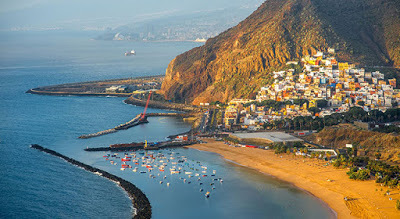
Tenerife, Canary Islands
One of my students, Carlota, comes from the Canary Islands. She tells me that it sometimes seems to her as if the whole of New Zealand were enclosed inside a bubble – 'like a floating island.'Carlota's islands, the Canaries, are a small archipelago of seven islands situated 100 kilometres off the coast of Morocco. By contrast, our two main islands, Te Ika a Māui and Te Waipounamu - complemented by 600-odd others - are pretty much on their own: 2,000 km east of Australia and 1,000 km south of New Caledonia. 'Next stop Antarctica,' as they say.
'I know, because I'm from an island too,' she goes on. Hers, though, was first settled by a blue-eyed, fair-haired race ('perhaps Vikings') before the Spanish arrived to wipe them all out.
'Atlanteans?' I ask. She agrees that many people think so. She's a little sceptical, though.
'A floating island.' She describes it like something out of Jules Verne: a huge transparent membrane, sealing us off from the pressures of the world outside. Or perhaps a better comparison might be with José Saramago's 1986 novel The Stone Raft, where the whole Iberian peninsula breaks off from Europe and floats into the Atlantic Ocean, splitting apart, once and for all, the pillars of Hercules.- Jack Ross, "The Stokes Point Pillars." 11 Views of Auckland. Edited by Jack Ross & Grant Duncan. Social and Cultural Studies, 10 (Auckland: Massey University, 2010): 155.
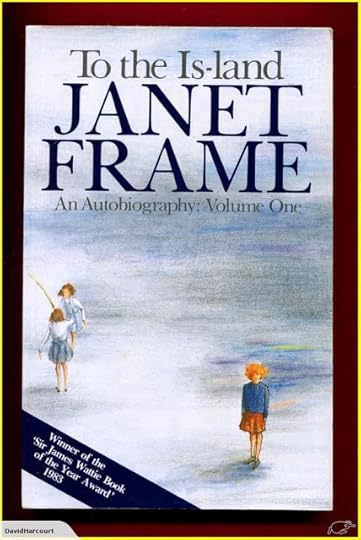
Janet Frame: To the Is-land (1982)
One more quote before we get going properly:
When the New Zealand writer Janet Frame was 7, she found in her school reader an adventure story, 'To the Island,' that she read as 'To the Is-land.' Though corrected by her teacher, she accepted the word thereafter as meaning what it said, the Land of Is, not the Was-Land, not the Future. In this first volume of her autobiography, which she calls 'a selection of views of the Is-Land,' it is the place of her childhood and adolescence.All of which should serve to prepare us for the actual subject of this post, the strange utopian romance Islandia (1942), by eccentric American lawyer Austin Tappan Wright:Helen Bevington, 'The Girl from New Zealand.' New York Times (21 November, 1982)
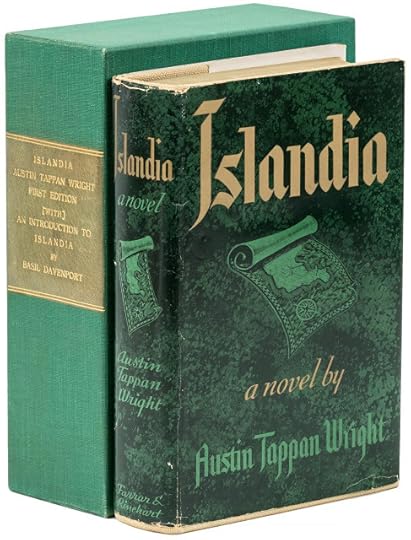
Austin Tappan Wright: Islandia (1942)
Wright had been dead for eleven years when his immense novel finally saw the light of day. Not that the publishers of the day were prepared to contemplate the publication of the whole thing. In her afterword to the 2001 paperback edition, his daughter Sylvia explains that this 1,000-page tome 'represents only a part of the total Islandia papers.'
The original novel, containing close to six hundred thousand words, was so vast as to be virtually unpublishable, particularly during a wartime paper shortage. It was in this form, however, a manuscript contained in seven thick spring binders, too heavy for me to carry by myself, that it was accepted by the publishers.- Sylvia Wright Mitarachi, 'Afterword.' In Austin Tappan Wright. Islandia. Ed. Mark Saxton, Margaret Garrad Wright & Sylvia Wright. 1942. Introduction by John Silbersack (New York: Overlook Duckworth, 2001): 1015.
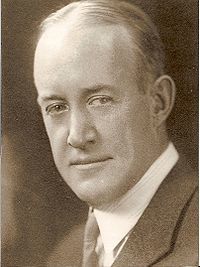
Austin Tappan Wright (1879-1931)
So what got left out? Sylvia Wright goes on:
With the intelligent and sensitive help of Mark Saxton, then an editor of Farrar & Rhinehart, I cut the [twenty-three hundred pages of the] original novel by about a third. This is its form today. As I indicated in a note in the original edition, my father knew the exact lineaments of every scene John Lang saw, down to its geological causes, and enjoyed describing such things. Much of the cutting was of this sort of leisurely observation. Also, as Mr. Basil Davenport pointed out in his essay on the Islandia papers, published as a companion volume to the novel, my father's writing became more succinctly his own as he went on. The bulk of the cutting, therefore, was in the early part of the book. [1016]
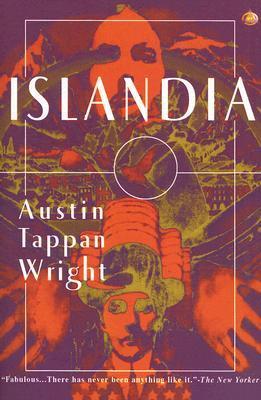
Austin Tappan Wright: Islandia (2006)
It seems rather a pity that the decision was taken to include this essay by Basil Davenport as part of the original publication, rather than more of the ancillary papers associated with the novel itself:
My father knew the country so well because he had considered it and travelled around it in so many guises. In one, he constructed its history, a scholarly work entitled Islandia: History and Description, by M. Jean Perier, whom readers of the novel will recognize as the first French consul to Islandia.
This document, of about 135,000 words, is the major part of the remainder of the unpublished Islandia papers. In addition, there are a large number of appendices to the history, including a glossary of the Islandian language; a bibliography; several tables of population; a gazeteer of the provinces with a history of each; tables of viceroys, judges, premiers, etc.; a complete historical peerage; notes of the calendar and climate; and a few specimens of Islandian literature. There are also nineteen maps, one geological. To use Leonard Bacon's phrase from the introduction he wrote to the first publication, here one discovers, 'the very Devonian outcrop of Never Never country.' [1016]
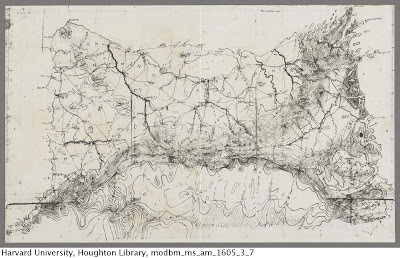
John K. Wright: Map of Islandia
So what is the book itself like? That phrase 'never never country,' with its echoes of J. M. Barrie's Peter Pan, implies a kind of fantasy world, with fairies and elves and other mythological trappings. Nothing could be further from the truth. Islandia is a fully fleshed-out, realistic fantasy world with politics, history, and - above all - human relationships to the fore.
Ursula K. Le Guin, a big fan of the book, once wrote that she and her family was Islandia-philes in the same way as a later generation would be Tolkien-freaks. They quoted from it, argued over details, and generally lived through its pages.
So, it seems, did the entire Wright family. Austin's brother John, a professional geographer, contributed the splendid topographical map pictured above to the enterprise, and his daughter Sylvia recalls it having been an inextricable part of her childhood:
We always knew about Islandia, although apparently my father did not talk very much about it outside the family. We had ideas of what it looked like, from comments like, 'This view looks like Islandia.' Our boat was called Aspara, the Islandian word for seagull. [1019-20]It's in this same section of her afterword that she explains how the word should be pronounced: 'Aye-landia' - rather than 'Iz-landia' or 'Ee-landia':
My father originated Islandia as 'my island' when he was a boy. This is why the name is the only exception to the rule that there are no silent letters in the Islandian language.
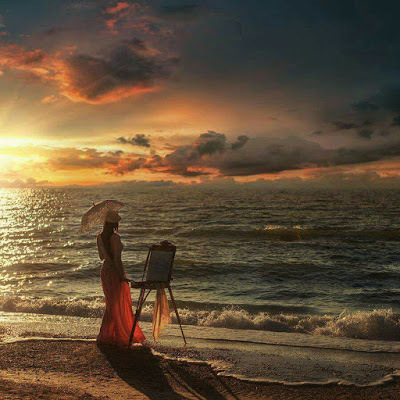
Islandian landscape (2018)
Interestingly, this genre of imaginary Islandian landscapes appears to be alive and well in the alternate Never-never world of Facebook. There are a number of pages devoted to the subject (though it is quite easy to confuse it with Ísland, Íslendingur - Iceland, Icelandic - especially when Islandia happens to be the word for "Iceland" in Spanish and various other languages).
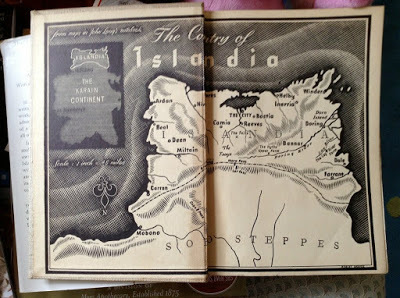
The Country of Islandia (1942)
It's important to emphasise the slightly ponderous - though very serviceable - nature of Wright's plotting and prose generally. Islandia is a perfectly readable novel, though its interests are not quite those of the 1920s, when it was written.
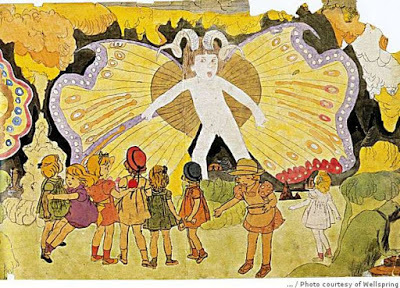
Henry Darger: Illustration from In the Realms of the Unreal (c.1913-1973)
It bears only a slight resemblance to a work such as outsider artist Henry Darger's 15,000 page magnum opus The Story of the Vivian Girls, in What Is Known as the Realms of the Unreal, of the Glandeco-Angelinian War Storm, Caused by the Child Slave Rebellion. Darger's work is unpublished, and will probably remain so, though extracts have appeared in various catalogues as well as in Jessica Yu's wonderful 2004 documentary about his life, also entitled (what else?) In the Realms of the Unreal.
A great deal of Wright's text, by contrast, is devoted to a rather wistful, Edwardian-flavoured exploration of the nature of love, which the Islandians divide into four separate concepts:
alia: love of place and family land and lineage amia: love of friends ania: desire for marriage and commitment apia: sexual attractionJohn Lang, the hero, experiences all of these in the course of the narrative, and it is this aspect of the book which is referred to specifically in Ursula Le Guin's almost equally ambitious fantasy work Always Coming Home (1985), devoted to the future anthropology of the Kesh, inhabitants of the land now known as Northern California (and now available in an expanded, 'definitive' edition through the Library of America):
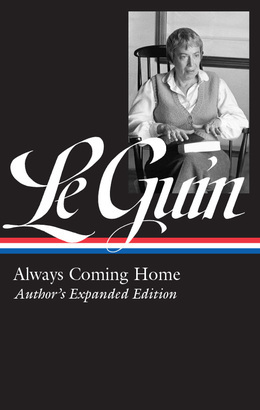
Ursula K. Le Guin: Always Coming Home (1985 / 2019)
Curiously enough, Islandia is not really set on an island - in the strictest sense of the term, at any rate. The country of Islandia is merely the tip of the immense 'semi-continent' of Karain, whose location is as elusive as that of the lost continent of Atlantis.
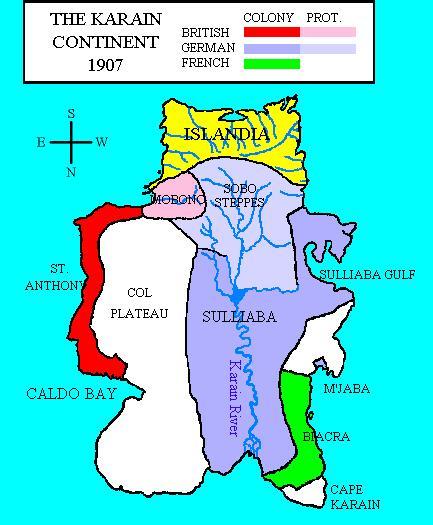
Johnny Pez: Karain Continent, 1907 (2006)
Sylvia Wright (as usual) sums up the evidence judiciously, if inconclusively:
Elmer Davis, and other writers, decided that Islandia is in the South Pacific. Both Lang and Perier assume that everyone knows where the country is, so neither mentions latitude and longitude. M. Perier does say, however, that the Karain subcontinent is not on the Spanish side of the Pope's line, which I have been told by so eminent an authority as Dr. John K. Wright, former head of the American Geographical Society, means that Islandia cannot be in the Pacific proper. Dr. Wright has studied the situation. He also feels that the Atlantic is too crowded.
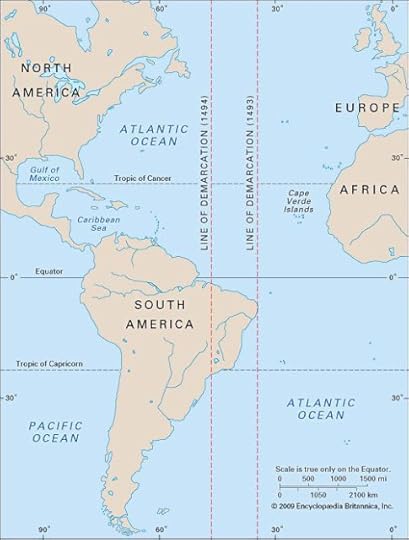
Treaty of Tordesillas (1494)
For those of you unfamiliar with the expression, the 'Pope's line' refers to an imaginary line drawn by Pope Alessandro Borgia in 1493 (and subsequently shifted slightly in 1494) which divided up the entire world into (respectively) the Spanish and Portuguese spheres of interest.
The idea was to keep the Spanish out of the Portuguese discoveries in the far East, and the Portuguese out of the Spanish discoveries in the Americas. However, as you'll observe, the existence of one Portuguese-speaking country in Latin America - Brazil - is due largely to this shifting of the lines. Moreover, as you'll see from the image below, any line drawn on a sphere such as the earth must come, literally, full circle, so considerable latitude for debate remained even after this apparently 'definitive' decision had been reached.
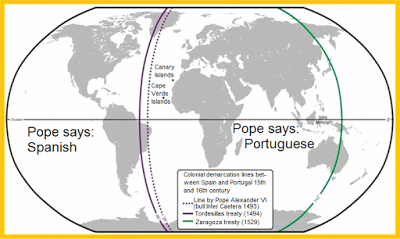
Bull of Demarcation
There's an indescribable atmosphere to the slow unfolding of Wright's long tale which makes it immensely beguiling to read. I'm on my second run-through myself, and am finding it quite as attractive as the first time round. What's more, I'm fascinated to discover that the entire text is finally available online, through the good offices of Harvard University Library.
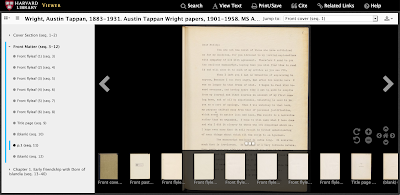
Online Reader
Here's what you'll see if you click on the link above. You can (if you wish) read the typescript of the entire novel there, without the 1942 cuts, as well as examining in detail the text of M. Jean Perier's comprehensive guidebook Islandia: History and Description.
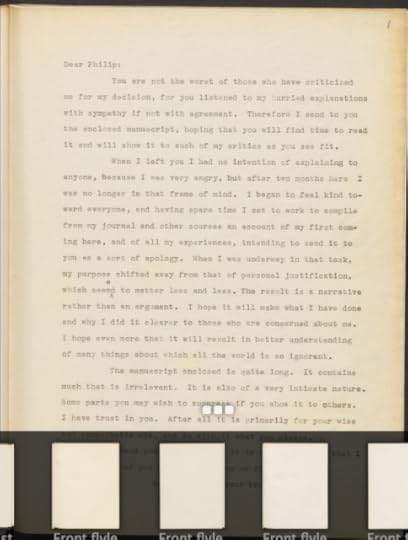
Islandia, page 1
Like all utopias, however, Wright's has its fly in the ointment. Isolationist Islandia is unquestionably dominated by white people. The 'natives' to the south are regarded by the Islandians with a certain disdain (not unmixed with fear). As described, in fact, the continent of Karain sounds a lot more like South Africa than, say, Australia, with which it would otherwise tempting to identify it.
Is it a racist state? Certainly it betrays many of the characteristics of its era. Wright describes the 'blacks' and 'mulattos' who surround Islandia with the patronising attitudes of his time. He is, moreover, careful to make it clear that the people he is interested in originated somewhere in Northern Europe. They sound quite a bit like Icelanders, in fact - stubbornly independent and proudly different - albeit displaced from the North to the South of the globe.
Hard though he tries to sideline it, this is one of the features of his work which makes it difficult for me to embrace it quite so wholeheartedly as Ursula Le Guin and all of its other fans. It also explains why this constitutes only part one of my consideration of Islomania.
In part two I'd like to look further - at the risk of being accused of reductionism - into this political dimension of such 'pure' creations of the imagination. It is with a certain discomfort that many New Zealanders, myself included, have observed the conscious transformation of our country into an ersatz simulacrum of Tolkien's Middle-earth over the last couple of decades. The fact that so many Māori were cast as Orcs (albeit with a leavening of whining Dickensian cockneys), while the Elvish roles were reserved for willowy Europeans, was, to say the least, a trifle disconcerting.
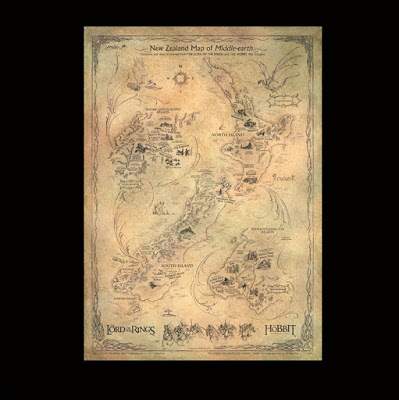
Weta Workshop: New Zealand as Middle-earth
Let's not romanticise this island-mania too much, then. One of the important points about islands is that they are more easily policed and kept under control than other parts of the earth - witness the infamous rounding-up of the aboriginal population of Tasmania: a pointless enterprise in other parts of that vast, turbulent continent.
The Celtic New Zealand hpothesis does not exist in a vaccuum. Many of us would like to rewrite the history of our world to our own satisfaction, leaving certain key aspects out - islomania, in its more extreme forms, could be seen to lend itself awfully easily to ethnic cleansing ...
For the moment, though, I would like to emphasise the immense charm and complexity of Wright's Islandia. Little could be said to happen in the novel, but then it exists really to provide a setting for his own sense of displacement and Heimweh: that belief we all share that there is a true home for us, somewhere, if only we could find it - if not in the real world, than in memory, or (better) still, the realms of the imagination.
That, it seems to me, is at the heart of this thing called Islomania.
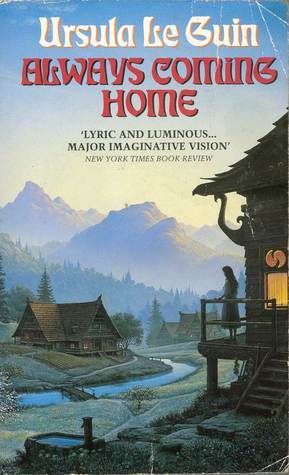
Ursula K. Le Guin: Always Coming Home (1985)
•
Published on June 29, 2019 16:21
June 13, 2019
Henry James: The Legend of the Master
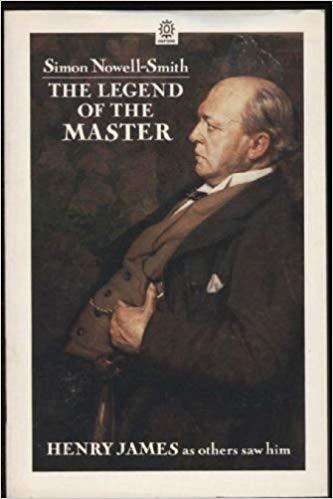
Simon Nowell-Smith: The Legend of the Master (1947)
At the Grave of Henry James
The snow, less intransigeant than their marble,"A great and talkative man," W. H. Auden called him in this magnificent elegy, first published in Horizon in 1941. I too - to descend from the sublime to the ridiculous - have already written a short post on Henry James, some years ago, but solely in connection with his prowess as a writer of ghost stories.
Has left the defence of whiteness to these tombs;
For all the pools at my feet
Accommodate blue, now, and echo such clouds as occur
To the sky, and whatever bird or mourner the passing
Moment remarks they repeat.
His importance to Auden appears to have been as a kind of final court of literary appeal:
All will be judged. Master of nuance and scruple,Others, too (Graham Greene among them), found his example strangely inspiring in the 1940s, as the brute beasts trampled the earth, and utter darkness threatened to swallow up the exquisite niceties of perception for which James stood for, both as man and writer.
Pray for me and for all writers living or dead;
Because there are many whose works
Are in better taste than their lives, because there is no end
To the vanity of our calling: make intercession
For the treason of all clerks.
Do I find him easy to read? Not really, no - with the exception of such fine early works as "Daisy Miller" or The American. I've never undertaken the task of reading a James novel without a certain trepidation. And there are still great gaps in my knowledge of his œuvre.
Paradoxically, though, I find him very easy to read about. I've worked my way through Leon Edel's magisterial, multi-volumed biography a couple of times now, and find it, alas, more enthralling than any of the Master's own books.
Of course it's only one among many biographies. And - just to make things simpler - it exists in a number of diverse forms. There's the original, five-volume edition, in which it first appeared between 1953 and 1972:
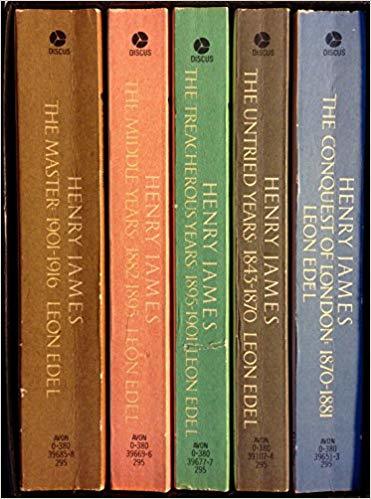
Leon Edel: Henry James (1978)
Edel, Leon. Henry James. The Untried Years: 1843-1870. 1953. New York: Avon Books, 1978.
Edel, Leon. Henry James. The Conquest of London: 1870-1881. 1962. New York: Avon Books, 1978.
Edel, Leon. Henry James. The Middle Years: 1882-1895. 1962. New York: Avon Books, 1978.
Edel, Leon. Henry James. The Treacherous Years: 1895-1901. 1969. New York: Avon Books, 1978.
Edel, Leon. Henry James. The Master: 1901-1916. 1972. New York: Avon Books, 1978.
Then there's the unabridged, but slightly reorganised British paperback edition:
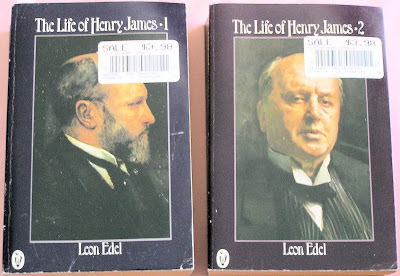
Leon Edel: The Life of Henry James (1977)
Edel, Leon. The Life of Henry James. Vol. 1: 1843-89. 1953, 1962, 1963. Peregrine Books. Harmondsworth: Penguin, 1977.
Edel, Leon. The Life of Henry James. Vol. 2. 1963, 1969, 1972. Peregrine Books. Harmondsworth: Penguin, 1977.
And then, finally, there's the one-volume abridgement of 1985, which unfortunately contains some extra material, and therefore needs to be acquired by the fastidious collector (though it turned out to consist mostly of some rather tenuous speculations about some possible new sources for "The Turn of the Screw"):
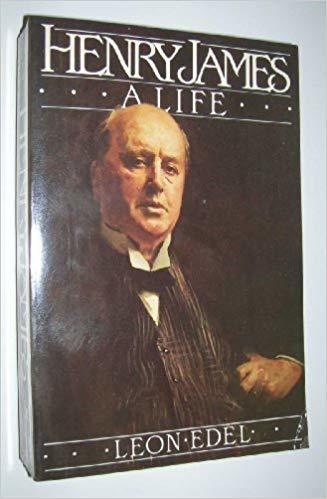
Leon Edel: Henry James: A Life (1978)
Edel, Leon. Henry James: A Life. 1953, 1962, 1963, 1969, 1972 & 1977. New York: Harper & Row, Publishers, Inc., 1985.
That really is just the tip of the iceberg when it comes to Jamesiana, though. There's the disreputably entertaining work by Simon Nowell-Smith pictured at the head of this post. And, if it's the Master's domestic arrangements that preoccupy you, there's the almost equally interesting work below by H. Montgomery Hyde:
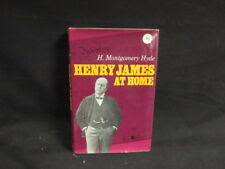
H. Montgomery Hyde: Henry James at Home (1978)
Nowell-Smith, Simon. The Legend of the Master: Henry James as Others Saw Him. 1947. Oxford Paperbacks. Oxford: Oxford University Press, 1985.
Hyde, H. Montgomery. Henry James at Home. London: Methuen, 1969.
Then there are the curious events of the so-called 'Year of Henry James' - 2004 - when a whole series of novelists seem to have decided simultaneously to make him the star of their books. David Lodge and Colm Tóibín are the most prominent among them, but Lodge lists a number of others in his book of essays on the subject:
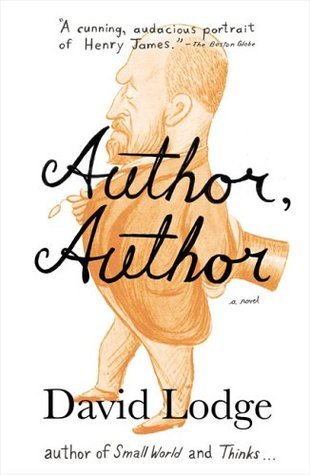
David Lodge: Author, Author (2004)
Lodge, David. Author, Author: A Novel. Secker & Warburg. London: Random House, 2004.
Lodge, David. The Year of Henry James or, Timing is All: The Story of a Novel. With Other Essays on the Genesis, Composition and Reception of Literary Fiction. Harvill Secker. London: Random House, 2006.
Tóibín, Colm. The Master: A Novel. Scribner. New York: Simon & Schuster, 2004.
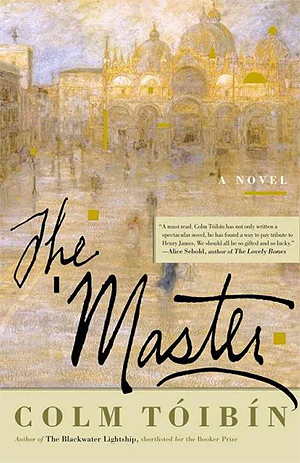
Colm Tóibín: The Master (2004)
What other ways are there to fritter away your time in the beguiling province of Henry-Jamesia without venturing to scale the daunting mountain ranges of his late prose? I can think of a few answers.
First of all, there are a number of other books by Leon Edel to sample - not to mention an intriguing book on 'The Turn of the Screw' by Auckland University lecturer Dr Elizabeth Sheppard. But the real motherlode lies in the books by and about the rest of the family: not just his polymathic elder brother William, but also his fiercely intelligent 'professional invalid' of a sister, Alice:
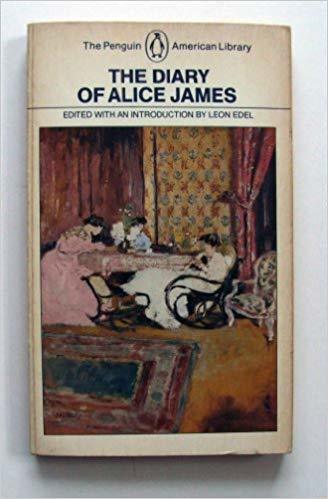
Leon Edel, ed.: The Diary of Alice James (1964)
Edel, Leon. The Psychological Novel, 1900-1950. London: Rupert Hart-Davis, 1955.
Edel, Leon. Bloomsbury: A House of Lions. 1979. Harmondsworth: Penguin, 1981.
Edel, Leon, ed. The Diary of Alice James. 1964. Introduction by Linda Simon. Boston: Northeastern University Press, 1999.
Hardwick, Elizabeth, ed. The Selected Letters of William James. The Great Letters Series. New York: Farrar, Straus and Cudahy, 1961.
James, William. The Principles of Psychology. Great Books of the Western World, 53. Ed. Robert Maynard Hutchins. Chicago: William Benton, Publisher / Encyclopaedia Britannica, Inc., 1952.
James, William. The Varieties of Religious Experience: A Study in Human Nature. 1901-2. Introduction by Arthur Darby Nock. 1955. The Fontana Library: Theology & Philosophy. London: Collins, 1968.
Lewis, R. W. B. The Jameses: A Family Narrative. 1991. An Anchor Book. New York: Doubleday, 1993.
Sheppard, E. A. Henry James and The Turn of the Screw. Auckland: Auckland University Press / Oxford University Press, 1974.
Yeazell, Ruth Bernard, ed. The Death and Letters of Alice James. 1981. Boston: Exact Change Books, 1997.
Sooner or later, of course, you'll have to bite the bullet and just start reading The Portrait of a Lady, or some other reasonably approachable early or mid-period novel, but even that can be put off for some considerable time if you choose to go via the distinctly less daunting letters-and-notebooks route:
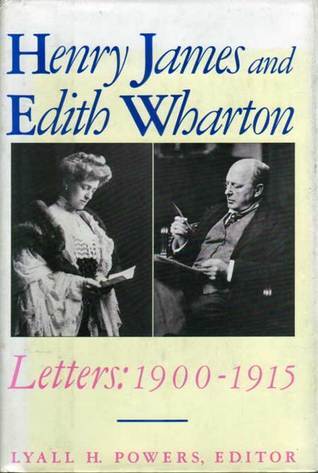
Lyall H. Powers, ed.: Henry James and Edith Wharton (1990)
Matthiessen, F. O., & Kenneth B. Murdock, ed. The Notebooks of Henry James. 1947. A Galaxy Book GB 61. New York: Oxford University Press, Inc., 1961.
Edel, Leon, ed. The Selected Letters of Henry James. New York: Farrar, Straus and Cudahy, 1955.
James, Henry. Letters I: 1843-1875. Ed. Leon Edel. London: Macmillan London Limited, 1974.
James, Henry. Letters II: 1875-1883. Ed. Leon Edel. 1975. London: Macmillan London Limited, 1978.
James, Henry. Letters III: 1883-1895. Ed. Leon Edel. 1980. London: Macmillan London Limited, 1981.
James, Henry. Letters IV: 1895-1916. Ed. Leon Edel. The Belknap Press. Cambridge, Massachusetts & London: Harvard University Press, 1984.
James, Henry. Selected Letters. Ed. Leon Edel. The Belknap Press. Cambridge, Massachusetts & London: Harvard University Press, 1987.
Edel, Leon, & Lyall H. Powers, ed. The Complete Notebooks of Henry James. New York & Oxford: Oxford University Press, Inc., 1987.
Horne, Philip, ed. Henry James: A Life in Letters. Viking Penguin. Harmondsworth: Penguin, 1999.
Powers, Lyall H, ed. Henry James and Edith Wharton. Letters: 1900-1915. London: George Weidenfeld & Nicolson Limited, 1990.
Smith, Janet Adam, ed. Henry James and Robert Louis Stevenson: A Record of Friendship and Criticism. London: Rupert Hart-Davis, 1948.
Once again (as usual), it's Leon Edel who leads the charge, with his four-volume edition of the Letters, as well as a couple of one-volume selected editions. But, as you can see from the list above, there are also number of correspondences with particular friends and fellow authors to be savoured - not to mention one of those 'Life in Letters' compilations which offer such a good way of selling essentially the same material twice.
All of which brings me to what is (ostensibly, at least) the actual subject of this post: the decision to complete my set of the Henry James volumes included in the Library of America. If you've read my recent piece on the subject, you'll know more than enough already about my obsession with this black-backed series of classics.
Their Henry James collection includes the complete novels (in six volumes), the complete stories (in five volumes), the collected travel writings (in two volumes), the collected literary criticism (in two volumes), and the complete autobiographical writings (in one volume): 16 volumes in all. When I receive the last couple of volumes of novels, I'll be proud to say that I have them all:
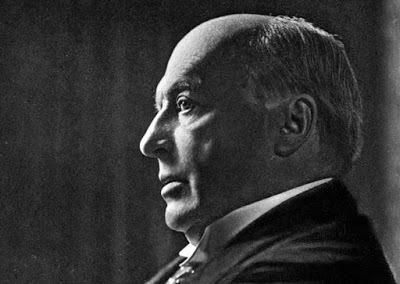
Henry James
James, Henry. Novels 1871-1880: Watch and Ward / Roderick Hudson / The American / The Europeans / Confidence. Ed. William T. Stafford. The Library of America, 13. New York: Literary Classics of the United States, Inc., 1983.
James, Henry. Novels 1881-1886: Washington Square / The Portrait of a Lady / The Bostonians. Ed. William T. Stafford. The Library of America, 29. New York: Literary Classics of the United States, Inc., 1985.
James, Henry. Novels 1886-1890: The Princess Casamassima / The Reverberator / The Tragic Muse. Ed. Daniel Mark Fogel. The Library of America, 43. New York: Literary Classics of the United States, Inc., 1989.
James, Henry. Novels 1896-1899: The Other House / The Spoils of Poynton / What Maisie Knew / The Awkward Age. Ed. Myra Jehlen. The Library of America, 139. New York: Literary Classics of the United States, Inc., 2003.
James, Henry. Novels 1901-1902: The Sacred Fount / The Wings of the Dove. Ed. Leo Bersani. The Library of America, 162. New York: Literary Classics of the United States, Inc., 2006.
James, Henry. Novels 1903-1911: The Ambassadors / The Golden Bowl / The Outcry / Appendix: “The Married Son.” Ed. Ross Posnock. The Library of America, 215. New York: Literary Classics of the United States, Inc., 2011.
James, Henry. Complete Stories, Volume 1: 1864-1874. Ed. Jean Strouse. The Library of America, 111. New York: Literary Classics of the United States, Inc., 1999.
James, Henry. Complete Stories, Volume 2: 1874-1884. Ed. William L. Vance. The Library of America, 106. New York: Literary Classics of the United States, Inc., 1999.
James, Henry. Complete Stories, Volume 3: 1884-1891. Ed. Edward Said. The Library of America, 107. New York: Literary Classics of the United States, Inc., 1999.
James, Henry. Complete Stories, Volume 4: 1892-1898. Ed. David Bromwich and John Hollander. The Library of America, 82. New York: Literary Classics of the United States, Inc., 1996.
James, Henry. Complete Stories, Volume 5: 1898-1910. Ed. Denis Donoghue. The Library of America, 83. New York: Literary Classics of the United States, Inc., 1996.
James, Henry. Collected Travel Writings. Great Britain and America: English Hours; the American Scene; Other Travels. Ed. Richard Howard. The Library of America, 64. New York: Literary Classics of the United States, Inc., 1993.
James, Henry. Collected Travel Writings. The Continent: A Little Tour in France; Italian Hours; Other Travels. Ed. Richard Howard. The Library of America, 65. New York: Literary Classics of the United States, Inc., 1993.
James, Henry. Literary Criticism: Essays on Literature; American Writers; English Writers. Ed. Leon Edel & Mark Wilson. The Library of America, 22. New York: Literary Classics of the United States, Inc., 1984.
James, Henry. Literary Criticism: French Writers; Other European Writers; The Prefaces to the New York Edition. Ed. Leon Edel & Mark Wilson. The Library of America, 23. New York: Literary Classics of the United States, Inc., 1984.
James, Henry. Autobiographies: A Small Boy and Others / Notes of a Son and Brother / The Middle Years / Other Writings. 1913, 1914, 1917. Ed. Philip Horne. The Library of America, 274. New York: Literary Classics of the United States, Inc., 2016.
•
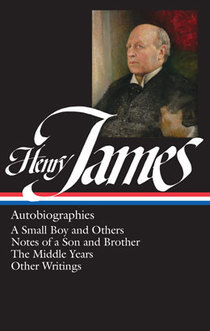 Henry James: Autobiographies LOA N°274
Henry James: Autobiographies LOA N°274 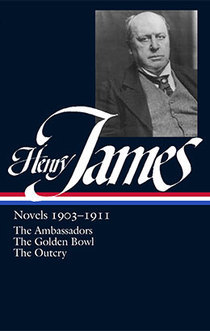 Henry James: Novels 1903-1911 LOA N°215
Henry James: Novels 1903-1911 LOA N°215 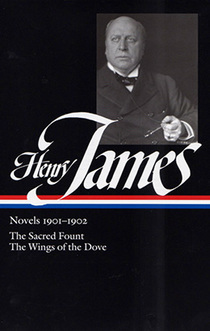 Henry James: Novels 1901–1902 LOA N°162
Henry James: Novels 1901–1902 LOA N°162 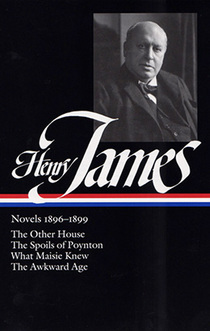 Henry James: Novels 1896–1899 LOA N°139
Henry James: Novels 1896–1899 LOA N°139 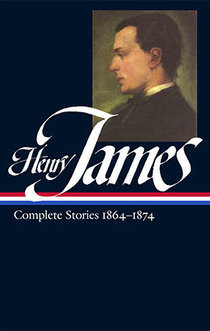 Henry James: Complete Stories 1864–1874 LOA N°111
Henry James: Complete Stories 1864–1874 LOA N°111 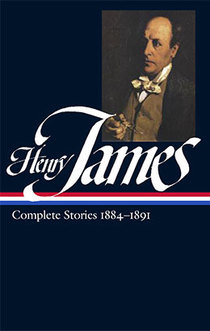 Henry James: Complete Stories 1884–1891 LOA N°107
Henry James: Complete Stories 1884–1891 LOA N°107 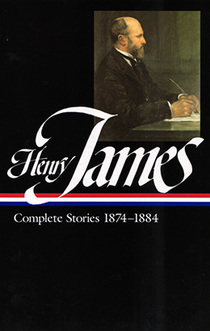 Henry James: Complete Stories 1874–1884 LOA N°106
Henry James: Complete Stories 1874–1884 LOA N°106 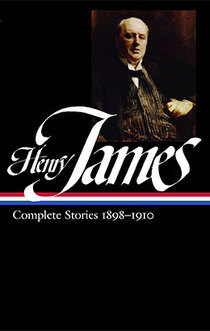 Henry James: Complete Stories 1898–1910 LOA N°83
Henry James: Complete Stories 1898–1910 LOA N°83 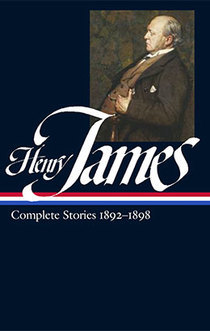 Henry James: Complete Stories 1892–1898 LOA N°82
Henry James: Complete Stories 1892–1898 LOA N°82 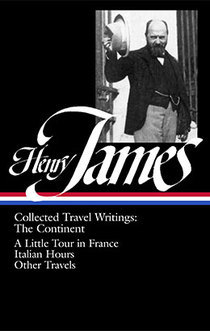 Henry James: Collected Travel Writings: The Continent LOA N°65
Henry James: Collected Travel Writings: The Continent LOA N°65 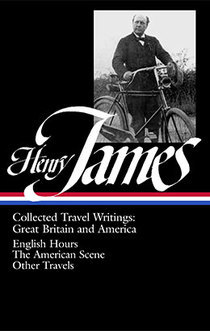 Henry James: Collected Travel Writings: Great Britain and America LOA N°64
Henry James: Collected Travel Writings: Great Britain and America LOA N°64 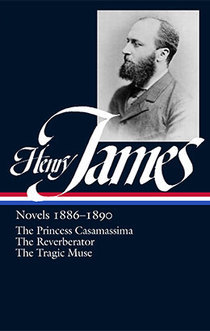 Henry James: Novels 1886–1890 LOA N°43
Henry James: Novels 1886–1890 LOA N°43 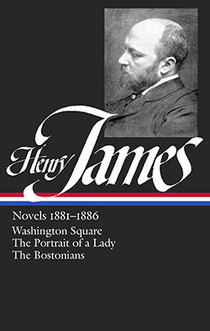 Henry James: Novels 1881–1886 LOA N°29
Henry James: Novels 1881–1886 LOA N°29 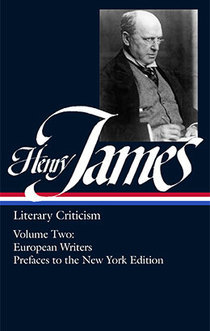 Henry James: Literary Criticism: French Writers, Other European Writers, Prefaces to the New York Edition LOA N°23
Henry James: Literary Criticism: French Writers, Other European Writers, Prefaces to the New York Edition LOA N°23 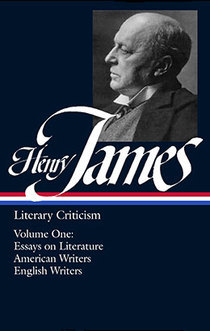 Henry James: Literary Criticism: Essays on Literature, American Writers, English Writers LOA N°22
Henry James: Literary Criticism: Essays on Literature, American Writers, English Writers LOA N°22 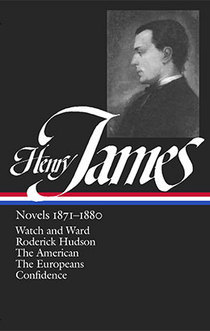 Henry James: Novels 1871–1880 LOA N°13
Henry James: Novels 1871–1880 LOA N°13 •
James (according to Leon Edel, at any rate) had an obsession with collected editions. His aspiration, from the very beginning, was to create a kind of American Comédie humaine in the spirit of Balzac's monumentally comprehensive portrait of nineteenth-century France. The set of Balzac he himself read was in 23 volumes. Hence the 23 volumes he attempted to compress his works into for the late New York edition (1907-9) of his works.
Unfortunately it sprawled into 24 volumes instead, and eventually included two posthumous volumes as well, so it's safe to say that his long-meditated enterprise didn't go quite as planned.
What's more, it was a financial disaster. He'd rewritten, revised, and radically pruned his early fiction to fit the aesthetic dictates of his late style, and the result was hardly pleasing to fans of the works in their earlier form. The elaborate prefaces he wrote for each volume, though subsequently collected as a kind of treatise on the art of fiction, were also seen as somewhat excessive.
This - as he perceived it - ruin of his life's work drove him into a depression, and it wasn't really until the pressure of war work in 1914 awoke him from lethargy that he was able to recover the will to live, let alone to write.
When he died in 1916, he accordingly left an immense but disordered legacy. Above all, there's the problem of which texts to read: the original versions or the revised ones? Leon Edel, by and large, preferred the novels and stories as they first appeared, and he attempted to restore them to popular attention in the many, many collections of James's works he edited or oversaw.
The most prominent of these was probably his 12-volume set of the Master's complete short stories:
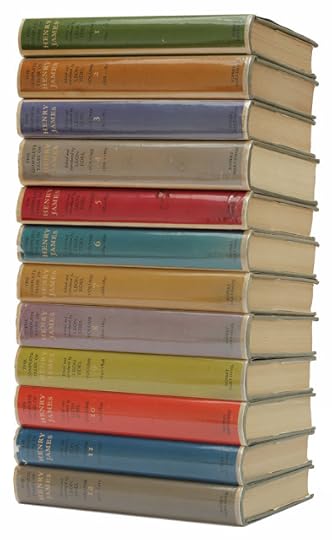
Leon Edel, ed. The Complete Tales of Henry James (1962-64)
Edel, Leon, ed. The Complete Tales of Henry James. Volume 1: 1864-1868. London: Rupert Hart-Davis, 1962.
Edel, Leon, ed. The Complete Tales of Henry James. Volume 2: 1868-1872. London: Rupert Hart-Davis, 1962.
Edel, Leon, ed. The Complete Tales of Henry James. Volume 3: 1873-1875. London: Rupert Hart-Davis, 1962.
Edel, Leon, ed. The Complete Tales of Henry James. Volume 4: 1876-1882. London: Rupert Hart-Davis, 1962.
Edel, Leon, ed. The Complete Tales of Henry James. Volume 5: 1883-1884. London: Rupert Hart-Davis, 1963.
Edel, Leon, ed. The Complete Tales of Henry James. Volume 6: 1884-1888. London: Rupert Hart-Davis, 1963.
Edel, Leon, ed. The Complete Tales of Henry James. Volume 7: 1888-1891. London: Rupert Hart-Davis, 1963.
Edel, Leon, ed. The Complete Tales of Henry James. Volume 8: 1891-1892. London: Rupert Hart-Davis, 1963.
Edel, Leon, ed. The Complete Tales of Henry James. Volume 9: 1892-1898. London: Rupert Hart-Davis, 1964.
Edel, Leon, ed. The Complete Tales of Henry James. Volume 10: 1898-1899. Philadelphia: J. B. Lippincott, 1964.
Edel, Leon, ed. The Complete Tales of Henry James. Volume 11: 1900-1903. London: Rupert Hart-Davis, 1964.
Edel, Leon, ed. The Complete Tales of Henry James. Volume 12: 1903-1910. London: Rupert Hart-Davis, 1964.
I wouldn't want you to walk away with the impression that the Library of America edition of James is in any way complete, however. Perish the thought! Conspicuous among the absences are James's last two novels, unfinished and posthumously published: The Ivory Tower and The Sense of the Past (consituting, respectively, the last two volumes of the New York edition).
Then there are the plays (available in another fine edition by Leon Edel).
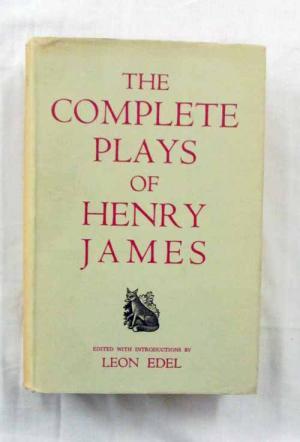
Leon Edel, ed. The Complete Plays of Henry James (1949)
Then there's his one, full-length biography, William Wetmore Story and His Friends (1903):
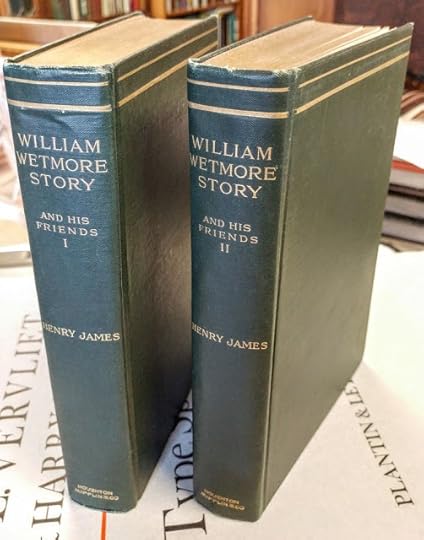
Henry James: William Wetmore Story and His Friends (1903)
Of course, there are reasons for allowing at least some of these to sink into oblivion. The biography was a duty job: forced upon him as an obligation to some friends, and not written from the heart (he didn't even like the sculptor Story very much).
The plays, too, were a kind of slow-motion disaster which had occupied much of his time in the 1890s, and came very near to breaking his heart:
"I'm the last, My Lord, of the Domvilles," as the eponymous hero of his play Guy Domville intoned in its one, abortive production.
"And it's a bloody good thing y'are!" a rough voice shouted from the stalls.
What else? There are facsimile editions of his annotated copies of early novels intended as guides for his later revisions - there are reprints, selections, re-editions, in basically every series of modern classics known to man. Truly, once you start, there's no obvious end to the number of books you need to collect to see this strangest of beings, this - in many ways - most loveable of writers, whole.
As a teacher of creative writing, I often find myself quoting his precept for young writers: "Dramatise!"
Even more often, though, I think of his three rules for civilised conduct: Be kindBe kindBe kind

John Singer Sargent: Henry James (1913)
Henry James
(1843-1916)
Novels:
James, Henry. Watch and Ward. 1871 & 1878. Introduction by Leon Edel. 1959. London: Rupert Hart-Davis, 1960.
James, Henry. The American: The Version of 1877 Revised in Autograph and Typescript for the New York Edition of 1907. Reproduced in Facsimile from the Original in the Houghton Library, Harvard University. Introduction by Rodney G. Dennis. Houghton Library Manuscript Facsimiles, 1. 1976. London: Scolar Press, 1978.
James, Henry. The Portrait of a Lady: An Authoritative Text / Henry James and the Novel / Reviews and Criticism. 1881. Ed. Robert D. Bamberg. A Norton Critical Edition. New York: W. W. Norton & Company, 1975.
James, Henry. The Portrait of a Lady. 1881. Ed. Geoffrey Moore. 1984. Notes by Patricia Crick. Penguin Classics. Harmondsworth: Penguin, 2003.
James, Henry. The Princess Casamassima. 1886. London: Heron Books / Macmillan & Co., n.d.
James, Henry. A London Life and The Reverberator. 1888 & 1908. Ed. Philip Horne. The World’s Classics. Oxford: Oxford University Press, 1989.
James, Henry. The Tragic Muse. 1890. Penguin Modern Classics. Harmondsworth: Penguin, 1978.
James, Henry. The Other House. 1896. Introduction by Leon Edel. London: Rupert Hart-Davis, 1948.
James, Henry. The Spoils of Poynton. 1897. Penguin Modern Classics, 1922. Harmondsworth: Penguin, 1963.
James, Henry. What Maisie Knew. 1897 & 1908. Ed. Douglas Jefferson & Douglas Grant. 1966. The World’s Classics. Oxford: Oxford University Press, 1980.
James, Henry. The Awkward Age. 1899. With the Author’s Preface. New York Edition, 1908. Penguin Modern Classics. Harmondsworth: Penguin, 1981.
James, Henry. The Sacred Fount. 1901. With an Introductory Essay by Leon Edel. 1953. A Black Cat Book. New York: Grove Press, Inc., 1979.
James, Henry. The Wings of the Dove: An Authoritative Text / The Author and the Novel / Criticism. 1902 & 1909. Ed. J. Donald Crowley & Richard A. Hocks. A Norton Critical Edition. New York: W. W. Norton & Company, 1978.
James, Henry. The Ambassadors: An Authoritative Text / The Author on the Novel / Criticism. 1903. Ed. S. P. Rosenbaum. A Norton Critical Edition. New York: W. W. Norton & Company, 1964.
James, Henry. The Golden Bowl. 1904. With the Author’s Preface. Penguin Modern Classics, 2449. Harmondsworth: Penguin, 1966.
James, Henry, with William Dean Howells, Mary E. Wilkins Freeman, Mary Heaton Vorse, Mary Stewart Cutting, Elizabeth Jordan, John Kendrick Bangs, Elizabeth Stuart Phelps, Edith Wyatt, Mary R. Shipman Andrews, Alice Brown & Henry Van Dyke. The Whole Family: A Novel by Twelve Authors. 1908. Introduction by Alfred Bendixen. New York: the Ungar Publishing Company, 1986.
James, Henry. The Outcry. Methuen's Colonial Library. London: Methuen & Co., Ltd., 1911.
James, Henry. The Outcry. 1911. Introduction by Jean Strouse. New York Review Books Classics. New York: The New York Review of Books, 2002.
James, Henry. The Ivory Tower. Preface by Percy Lubbock. 1917. With an Essay by Ezra Pound. 1954. Introduction by Alan Hollinghurst. New York Review Books Classics. New York: The New York Review of Books, 2004.
James, Henry. The Sense of the Past. The Novels and Tales of Henry James: New York Edition, Volume XXVI. Preface by Percy Lubbock. 1917. Classic Reprint Series. N.p.: Forgotten Books [www.forgottenbooks.org], 2010.
Stories:
Aziz, Maqbool, ed. The Tales of Henry James. Volume One, 1864-1869. Oxford: Clarendon Press, 1973.
James, Henry. The Turn of the Screw, The Aspern Papers and Other Stories. 1879-1910. Introduction by Michael Swan. Collins Classics. London: Collins, 1956.
James, Henry. Ghost Stories. Ed. Martin Scofield. Tales of Mystery & the Supernatural. Ware, Hertfordshire: Wordsworth Editions Limited, 2001.
Plays:
Edel, Leon, ed. The Complete Plays of Henry James. London: Rupert Hart-Davis, 1949.
James, Henry. Guy Domville: A Play in Three Acts. With Comments by Bernard Shaw, H. G. Wells, Arnold Bennett. Preceded by Biographical Chapters, Henry James: The Dramatic Years. Ed. Leon Edel. 1960. London: Rupert Hart-Davis, 1961.
James, Henry. The Scenic Art: Notes on Acting and the Drama, 1872-1910. Ed. Allan Wade. Foreword by Leon Edel. London: Rupert Hart-Davis, 1949.
Travel:
Kaplan, Fred, ed. Travelling in Italy with Henry James: Essays. A John Curtis Book. London: Hodder and Stoughton Ltd., 1994.
Literary Criticism:
James, Henry. The Art of the Novel: Critical Prefaces. Introduction by Richard P. Blackmur. 1934. New York & London: Charles Scribner’s Sons, 1947.
James, Henry. The House of Fiction: Essays on the Novel. Ed. Leon Edel. 1957. Mercury Books, 24. London: The Heinemann Group of Publishers, 1962.
James, Henry. Selected Literary Criticism. Ed. Morris Shapira. Preface by F. R. Leavis. 1963. A Peregrine Book Y73. Harmondsworth: Penguin, 1968.
Biography & Autobiography:
James, Henry. William Wetmore Story and His Friends: From Letters, Diaries, and Recollections. In Two Volumes (Combined). 1903. London: Thames & Hudson, n.d.
James, Henry. Autobiography: A Small Boy and Others; Notes of a Son and Brother; The Middle Years. 1913, 1914, 1917. Ed. Frederick W. Dupree. London: W. H. Allen, 1956.
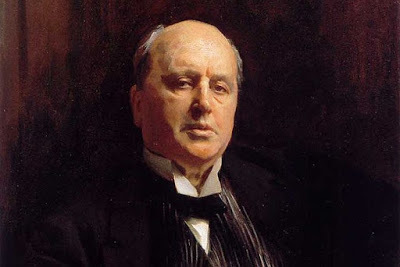
John Singer Sargent: Henry James (detail)
Published on June 13, 2019 14:22
June 7, 2019
Bruxelles & la Bibliothèque de la Pléiade

Brussels: Grande Place
A long time ago in a country far, far away - called Belgium - I lived a life in what now seems to me almost an alternate universe.
I don't know how convinced you are by the physics of the multiverse: the infinite branching paths radiating out from each moment in each of our lives (or, for that matter, in the life of the cosmos), but certainly in my own life I can see certain moments of decision - certain choices which determined one chain of events or another.

Palmerston North
One of them was in Palmerston North, where I taught for a year at Massey University, and was offered at the end of it a new, improved half-time contract rather than the full-time one I'd been on.
On that occasion, a counter-offer of full-time work at Auckland was decisive. I returned to my home town, not without certain regrets, but forced by economic necessity.

Brussels: Kraainem
My brief life as potential citizen of Europe (or Eurotrash, if you prefer) built up over several years from the late eighties to the mid-nineties. It was all involved with my first marriage, to a London-born, Paris-educated, French, German and Flemish speaking girl whose quite wealthy family lived in one of the nicer suburbs of Brussels.
The only one of those languages I could really speak was French, but no doubt the others would have come in time (I have a reading knowledge of German, though no Flemish at all).
The moment of our break-up put paid to that life. Nearly a quarter of a century later, I can't say I'm sorry. There's a certain comfort, as well as a certain complexity, in making your life in the place you originally came from. I do miss speaking French every day, but returning to New Zealand with the determination to try and get to know it properly for the first time has been as absorbing as any life task could be.
Some of the reliquaries of that vanished life include a large library of French books. One or two of them I should probably have returned to Jackie-Anne when we split up our few sticks of property, but I guess I hung on to them because they would be so much easier for her to replace than for me to reacquire (this was long before the days of Amazon.com and such digital gateways to virtually all the books in existence).

Tintin murals: Stockel metro station
I did send back a whole lot of things, but some I overlooked at the time. Since she kept everything we had in the other country, I imagine it worked out pretty equally. If not, it's all a long time ago now. I hope I learned some things about avoiding pettiness on such occasions as a result, though. It certainly confirmed my agreement with that old Shakespearean tag: 'He jests at scars who never felt a wound.'
Marriage break-ups, like any other emotional upheaval, are not to be taken lightly - and it's been a help to me many times since to remember my own feelings at the time. I don't feel judgemental about excesses of behaviour which might otherwise seem inexplicable.
Some people are able to stay on civil terms with their ex's. I wish that were true of me, too, but it isn't. I envy their maturity, but - again - it's helped me to understand why people will change countries, let alone cities, to avoid any casual encounters.
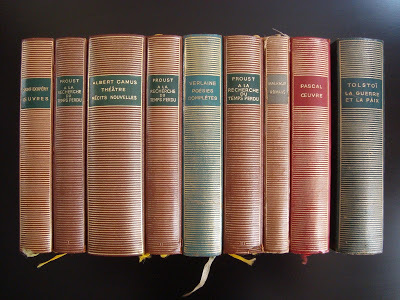
Bibliothèque de la Pléiade
These are some of the thoughts I have when I examine the following maniacal-seeming list of books belonging to the magisterial French collection of classics, the Bibliothèque de la Pléiade. If you notice obvious gaps, that's probably because I have a lot of other French books in less impressive forms.
And if you've got sick of these long lists of books-in-particular-series I've been putting up on this blog, all I can say is that I suspect this will be the last of them for a while. So far my lists-of-lists have included:
La Bibliothèque de la Pléiade (1931- )The Folio Society (1947- )The Library of America (1979- )The Loeb Classics (1912- )Longman Annotated English Poets (1965- )The Nonesuch Library (1927-77Penguin Modern Poets (1962-83)Penguin Modern European Poets (1958-84)Penguin Poets in Translation (1996-2005)The Reynard Library (1950-71)Russian Foreign Languages Publishing House (1946-64)
It's the Pléiade which has the most tender, still smarting associations, however.
I'll never regret that other life I almost started to live, but the life I live now is so much more satisfactory in every way, that I have to say that my main feeling about the whole thing now is gratitude both for the amazing opportunity, and also for the fact that I ended up taking another road - the road home, the one less travelled by.
Maybe I'll write more about it someday.
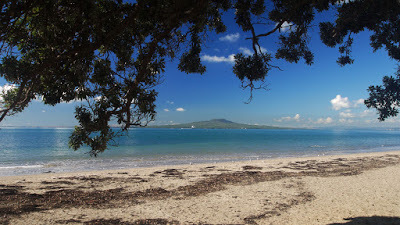
Auckland: Mairangi Bay
•

La Pléiade (1931- )
Ma bibliothèque
MES LIVRES
37 ouvrages / 26 auteurs
Anonyme
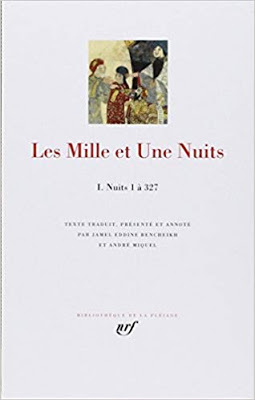
Les Mille et Une Nuits: Tome I (2005)
Bencheikh, Jamel Eddine, and André Miquel, trans. Les Mille et Une Nuits. Tome 1: Nuits 1 à 327. 3 vols. Bibliothèque de la Pléiade, 515. Paris: Gallimard, 2005.
Parution le 13 Mai 2005, 1312 pages, 68.00 €
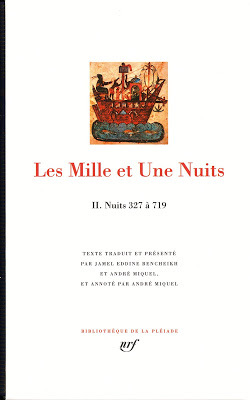
Les Mille et Une Nuits: Tome II (2006)
Bencheikh, Jamel Eddine, and André Miquel, trans. Les Mille et Une Nuits. Tome 2: Nuits 327 à 719. 3 vols. Bibliothèque de la Pléiade, 526. Paris: Gallimard, 2006.
Parution le 12 Octobre 2006, 1104 pages, 61.00 €
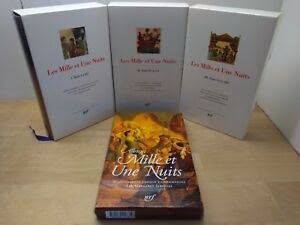
Les Mille et Une Nuits: Tome III (2006)
Bencheikh, Jamel Eddine, and André Miquel, trans. Les Mille et Une Nuits. Tome 3: Nuits 719 à 1001. 3 vols. Bibliothèque de la Pléiade, 527. Paris: Gallimard, 2006.
Parution le 12 Octobre 2006 1088 pages, 61.00 €
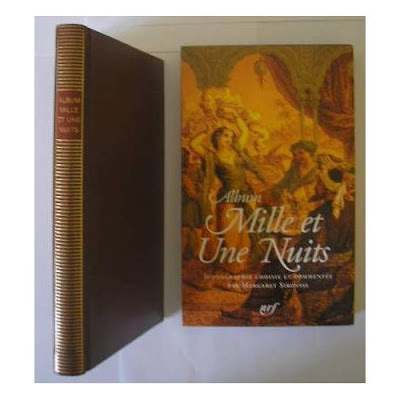
Margaret Sironval: Album Mille et Une Nuits: Iconographie commentée (2005)
Album Mille et Une Nuits : Iconographie. Choisie et commentée par Margaret Sironval. Bibliothèque de la Pléiade. Albums de la Pléiade, n° 44. Paris: Gallimard, 2005.
Parution le 13 Mai 2005, 272 pages, 248 ill.
Wilhelm Albert Włodzimierz Apolinary Kostrowicki [Guillaume Apollinaire] (1880-1918)
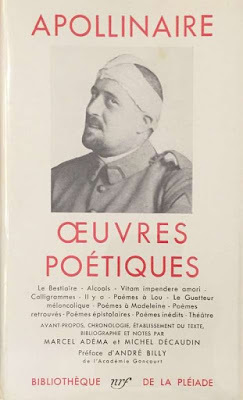
Guillaume Apollinaire : Œuvres poétiques complètes (1956)
Apollinaire, Guillaume. Œuvres poétiques : Le Bestiaire - Alcools - Vitam impendere amori - Calligrammes - Il y a - Poèmes à Lou - Le Guetteur mélancolique - Poèmes à Madeleine - Poèmes à la marraine - Poèmes retrouvés - Poèmes épistolaires - Poèmes inédits. Théâtre : Les Mamelles de Tirésias - Couleur du temps - Casanova. Ed. Marcel Adéma & Michel Décaudin. Préface d'André Billy. Bibliothèque de la Pléiade, 121. 1956. Paris: Gallimard, 1990.
Parution en Décembre 1956, 1344 pages, 59.00 €

Guillaume Apollinaire : Œuvres en prose complètes: Tome I (1977)
Apollinaire, Guillaume. Œuvres en prose complètes I : Contes et récits : L'Enchanteur pourrissant - L'Hérésiarque et Cie - Le Poète assassiné - Contes écartés du «Poète assassiné» - La Femme assise - Contes retrouvés - La Fin de Babylone - Les Trois Don Juan - La Femme blanche des Hohenzollern. Théâtre : La Température - Le marchand d'anchois - Jean-Jacques - La colombelle - Fragments divers. Cinéma : La Bréhatine - C'est un oiseau qui vient de France. Ed. Michel Décaudin. Bibliothèque de la Pléiade, 267. 1977. Paris: Gallimard, 1988.
Parution le 14 Mai 1977, 1584 pages, 60.00 €
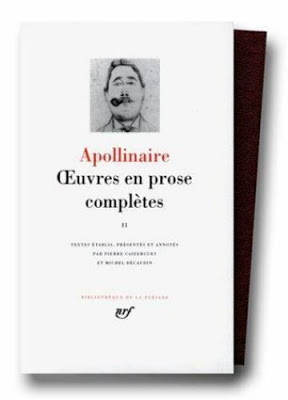
Guillaume Apollinaire : Œuvres en prose complètes: Tome II (1991)
Apollinaire, Guillaume. Œuvres en prose complètes II : Écrits sur l'art : Méditations esthétiques - Les Peintres cubistes - Fragonard et l'Amérique - Chroniques et paroles sur l'art. Critique littéraire : La Phalange nouvelle - Les Poèmes de l'année - Les Poètes d'aujourd'hui - [Sur la littérature féminine] - L'Antitradition futuriste - L'Esprit nouveau et les Poètes. Chroniques et articles : Théories et polémiques - Portraits et silhouettes - Critique - Variétés. Échos sur les lettres et les arts. Ed. Pierre Caizergues & Michel Décaudin. Bibliothèque de la Pléiade, 382. Paris: Gallimard, 1991.
Parution le 20 Novembre 1991, 1872 pages, 74.50 €
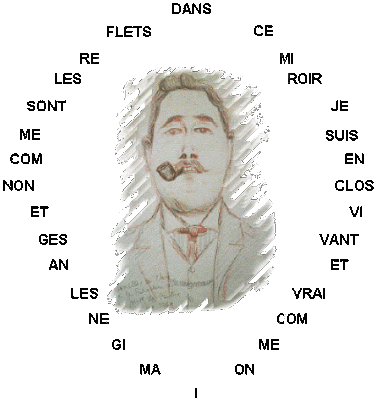
Guillaume Apollinaire : Œuvres en prose complètes: Tome III (1993)
Apollinaire, Guillaume. Œuvres en prose complètes III : Le Flâneur des deux rives - La Vie anecdotique - Chroniques et échos - Les Diables amoureux. Appendices : Essai sur la littérature sotadique au XIXe siècle - L'Arétin et son temps - [Les Fleurs du Mal] - Lettre à Louis Chadourne. Textes érotiques : Les Onze Mille Verges - Les Exploits d'un jeune don Juan. Compléments : théâtre : Un buveau d'absinthe qui a lu Victor Hugo - À la cloche de bois. Pièce en un acte - Revue de l'année : la Vérité sur la vie et le théâtre. Compléments : contes : [Projet de contes] - Un vol à la cour de Prusse - Le Roi Lune - Héloïse ou Dieu même. Chroniques et échos. Ed. Pierre Caizergues & Michel Décaudin. Bibliothèque de la Pléiade, 399. Paris: Gallimard, 1993.
Parution le 13 Mai 1993, 1632 pages, 76.00 €
Georges Bataille (1897-1962)
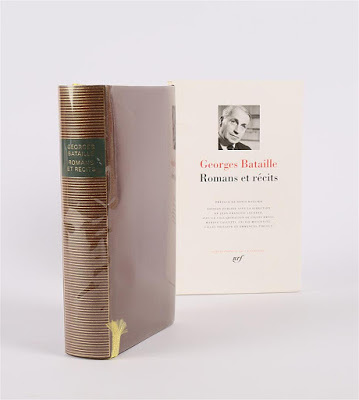
Georges Bataille : Romans et récits (2004)
Bataille, Georges. Romans et récits : Histoire de l'œil - Le Bleu du ciel - Madame Edwarda - Le Petit - Le Mort - Julie - L'Impossible - La Scissiparité - L'Abbé C - Ma mère - Charlotte d'Ingerville - Archives du projet «Divinus Deus». Appendices : Récits retrouvés - La Maison brûlée - Ébauches. Ed. Jean-François Louette. Preface by Denis Hollier. Bibliothèque de la Pléiade, 511. Paris: Gallimard, 2004.
Parution le 18 Novembre 2004, 1552 pages, ill., 66.00 €
Charles Pierre Baudelaire (1821-1867)
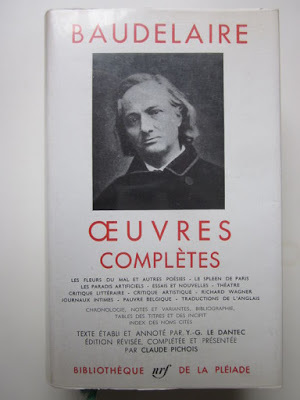
Charles Baudelaire : Œuvres complètes: Tome I (1931)
Baudelaire, Charles. Œuvres. Tome 1 : Les Fleurs du Mal - Le Spleen de Paris - Les Paradis artificiels - Essais et nouvelles - Théâtre - Critique littéraire - Critique artistique - Richard Wagner - Journaux intimes - Pauvre Belgique - Amœnitates Belgicæ - Traductions de l'anglais. Ed. Y.-G. Le Dantec. Bibliothèque de la Pléiade, 1. 1931. Paris: Gallimard, 1944.
Ancienne édition, Parution le 2 Octobre 1931, 666 pages
Albert Camus (1913-1960)
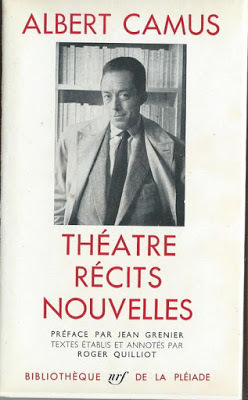
Albert Camus : Théâtre – Récits et nouvelles (1962)
Camus, Albert. Théâtre – Récits et nouvelles : Théâtre : Caligula - Le Malentendu - L'État de siège - Les Justes - Révolte dans les Asturies. Adaptations : Les Esprits - La Dévotion à la croix - Un Cas intéressant - Le Chevalier d'Olmedo - Requiem pour une nonne - Les Possédés. Récits et nouvelles : L'Étranger - La Peste - La Chute - L'Exil et le royaume : La Femme adultère. Le Renégat. Les Muets. L'Hôte. Jonas. La Pierre qui pousse. Ed. Roger Quilliot. Préface de Jean Grenier. Bibliothèque de la Pléiade, 161. 1962. Paris: Gallimard, 2005.
Ancienne édition, Parution le 13 Décembre 1962, 2128 pages
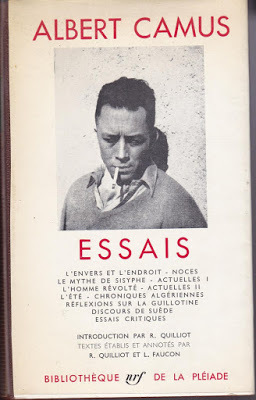
Albert Camus : Essais (1965)
Camus, Albert. Essais : L'Envers et l'Endroit - Noces - Le Mythe de Sisyphe - Lettres à un ami allemand (1943-1944) - Actuelles I, chroniques 1944-1948 - L'Homme révolté - Actuelles II, chroniques 1948-1953 - L'Été - Actuelles III, chroniques algériennes 1939-1958 - Réflexions sur la guillotine - Discours de Suède (1957). Essais critiques : Introduction aux « Maximes » de Chamfort - Avant-propos à « La Maison du peuple », de Louis Guilloux - Rencontres avec André Gide - L'Artiste en prison - Roger Martin du Gard - Sur « Les Îles », de Jean Grenier - René Char. Appendices : Métaphysique chrétienne et néoplatonisme - Articles, préfaces, interviews, inédits. Ed. Roger Quilliot & Louis Faucon. Bibliothèque de la Pléiade, 183. 1965. Paris: Gallimard, 1981.
Épuisé, Parution le 8 Décembre 1965, 2000 pages
Paul Claudel (1868-1955)
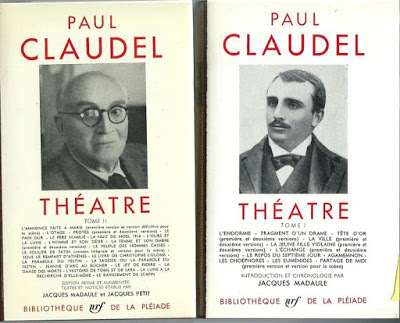
Paul Claudel : Théâtre: Tome I (1948)
Claudel, Paul. Théâtre. Tome 1 : L'Endormie - Fragment d'un drame - Tête d'or (1re et 2e versions) - La Ville (1re et 2e versions) - La Jeune fille Violaine (1re et 2e versions) - L'Échange (1re et 2e versions) - Le Repos du septième jour - Partage de midi (1re version et version pour la scène). Traductions d'Eschyle : Agamemnon - Les Choéphores - Les Euménides. Ed. Jacques Madaule & Jacques Petit. 2 vols. Bibliothèque de la Pléiade, 72. 1947. Paris: Gallimard, 1991.
Ancienne édition, Parution en Avril 1948, 1440 pages
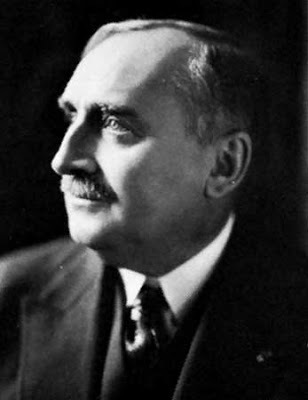
Paul Claudel : Théâtre: Tome II (1948)
Claudel, Paul. Théâtre. Tome 2 : L'Annonce faite à Marie (1re version et version pour la scène) - L'Otage - Protée (1re et 2e versions) - Le Pain dur - Le Père humilié - La Nuit de Noël 1914 - L'Ours et la Lune - L'Homme et son désir - La Femme et son ombre (1re et 2e versions) - Le Peuple des hommes cassés - Le Soulier de satin (version intégrale et version pour la scène) - Sous le rempart d'Athènes - Le Livre de Christophe Colomb - La Parabole du festin - La Sagesse ou La Parabole du Festin - Jeanne d'Arc au bûcher - Le Jet de pierre - La Danse des morts - L'Histoire de Tobie et de Sara - La Lune à la recherche d'elle-même - Le Ravissement de Scapin. Ed. Jacques Madaule & Jacques Petit. 2 vols. Bibliothèque de la Pléiade, 73. 1948. Paris: Gallimard, 1965.
Ancienne édition, Parution le 23 Mars 1948, 1568 pages
Denis Diderot (1713-1784)
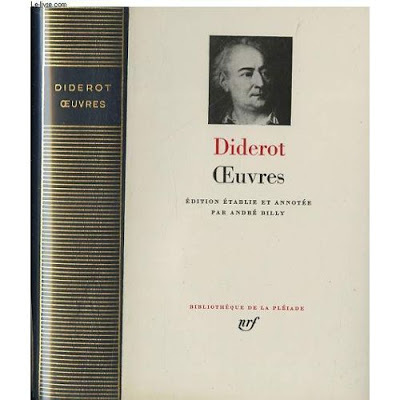
Denis Diderot : Œuvres (1946)
Diderot, Denis. Œuvres : Les Bijoux indiscrets - La Religieuse - Le Neveu de Rameau - Jacques le fataliste et son maître - Lui et moi - Les Deux amis de Bourbonne - Entretien d'un père avec ses enfants - Ceci n'est pas un conte - Sur l'inconséquence du jugement publique de nos actions particulières - Mon père et moi - Lettre à mon frère - Lettre sur les aveugles à l'usage de ceux qui voient - Entretien avec d'Alembert - Le rêve de d'Alembert - Regrets sur ma vieille robe de chambre - Sur les femmes - Sur l'estampe de Cochin - Supplément au Voyage de Bougainville - Paradoxe sur le comédien - Éloge de Richardson - Traité du Beau - Essai sur la peinture - Entretien d'un philosophe avec la Maréchale de *** - Satire I sur les caractères et les mots de caractère, de profession, etc. - Entretiens sur «Le fils naturel» - Des auteurs et des critiques - Lettres de Madame Riccoboni. Ed. André Billy. Bibliothèque de la Pléiade, 25. 1946. Paris: Gallimard, 1969.
Ancienne édition, Parution le 25 Septembre 1946, 1478 pages
Dumas Davy de la Pailleterie [Alexandre Dumas, père] (1802-1870)
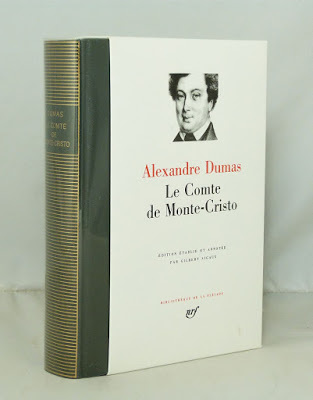
Alexandre Dumas : Le Comte de Monte-Cristo (1981)
Dumas, Alexandre. Le Comte de Monte-Cristo. 1845-46. Ed. Gilbert Sigaux. Bibliothèque de la Pléiade, 290. Paris: Gallimard, 1981.
Parution le 6 Mai 1981, 1504 pages, 60.00 €
André Paul Guillaume Gide (1869-1951)
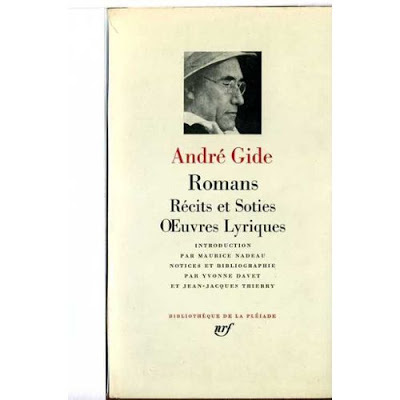
André Gide : Romans – Récits et soties – Œuvres lyriques (1958)
Gide, André. Romans; Récits et Soties; Œuvres lyriques : Le Traité du Narcisse - Le Voyage d'Urien - La Tentative amoureuse - Paludes - Les Nourritures terrestres - Les Nouvelles Nourritures - Le Prométhée mal enchaîné - El Hadj ou Le Traité du faux prophète - L'Immoraliste - Le Retour de l'Enfant Prodigue - La Porte Étroite - Isabelle - Les Caves du Vatican - La Symphonie pastorale - Les Faux-Monnayeurs - L'École des femmes - Robert - Geneviève ou La confidence inachevée - Thésée. Introduction by Maurice Nadeau. Ed. Yvonne Davet & Jean-Jacques Thierry. Bibliothèque de la Pléiade, 139. 1958. Paris: Gallimard, 1980.
Ancienne édition, Parution le 13 Novembre 1958, 1664 pages
Louis Poirier ['Julien Gracq'] (1910-2007)
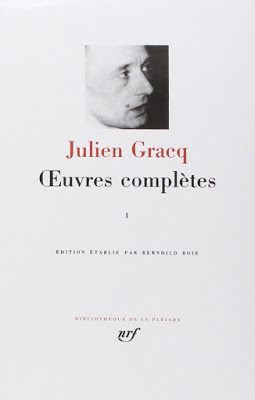
Julien Gracq : Œuvres complètes: Tome I (1989)
Gracq, Julien. Œuvres complètes. Tome 1 : Au château d'Argol - Un beau ténébreux - Liberté grande - Le Roi pêcheur - André Breton. Quelques aspects de l'écrivain - La Littérature à l'estomac - Le Rivage des Syrtes - Préférences. Appendices : Éclosion de la pierre - Un cauchemar - Le Surréalisme et la Littérature contemporaine - Prose pour l'étrangère - Enquête sur la diction poétique - Kleist : «Penthésilée» - Entretien sur «Penthésilée» de H. von Kleist. Ed. Bernhild Boie. Bibliothèque de la Pléiade, 354. Paris: Gallimard, 1989.
Parution le 4 Avril 1989, 1536 pages, 74.50 €
Pierre Ambroise François Choderlos de Laclos (1741-1803)
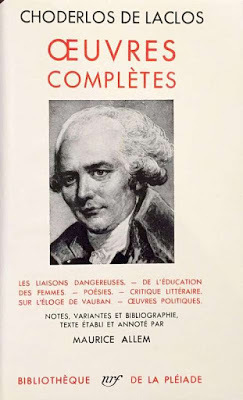
Choderlos de Laclos : Œuvres complètes (1944)
Choderlos de Laclos. Œuvres complètes : Les Liaisons dangereuses - De l'éducation des femmes - Poésies - Critique littéraire - Sur l'éloge de Vauban - Œuvres politiques - Appendices. Ed. Maurice Allem. Bibliothèque de la Pléiade, 6. 1944. Paris: Gallimard, 1959.
Ancienne édition, Parution le 16 Mars 1944, 942 pages
Stéphane [Étienne] Mallarmé (1842-1898)
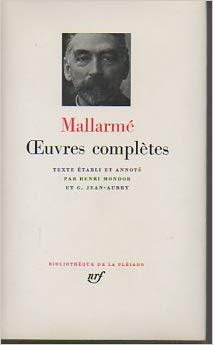
Stéphane Mallarmé : Œuvres complètes (1945)
Mallarmé, Stéphane. Œuvres complètes : Poëmes d'enfance et de jeunesse - Poésies - Vers de circonstance - Les Poëmes d'Edgar Poe - Proses de jeunesse - Poèmes en prose - Crayonné au théâtre - Variations sur un sujet - Un Coup de dés - Quelques médaillons et portraits en pied - Richard Wagner - Préface à «Wathek» - Le «Ten o'clock» de M. Whistler - Contes indiens - La Musique et les Lettres - Proses diverses - Les Mots anglais - Thèmes anglais - Les Dieux antiques - L'Étoile des fées. Ed. Henri Mondor & G. Jean-Aubry. Bibliothèque de la Pléiade, 65. 1945. Paris: Gallimard, 1992.
Épuisé, Parution le 12 Juin 1945, 1696 pages
André Malraux (1901-1976)
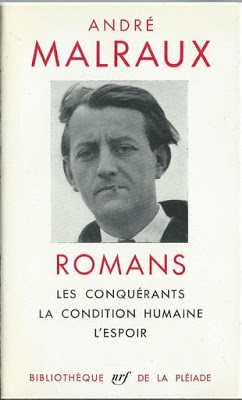
André Malraux : Romans (1947)
Malraux, André. Romans : Les Conquérants - La Voie royale - La Condition humaine - L'Espoir. 1928, 1930, 1946, 1937. Bibliothèque de la Pléiade, 70. 1947. Paris: Gallimard, 1978.
Épuisé, Parution en Juin 1947, 864 pages
Prosper Mérimée (1803-1870)
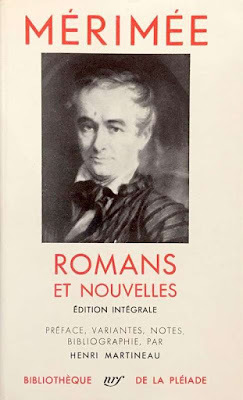
Prosper Mérimée : Romans et nouvelles (1934)
Mérimée, Prosper. Romans et nouvelles : Chronique du règne de Charles IX - Mosaïque - La Double méprise - Les Âmes du purgatoire - La Vénus d'Ille - Colomba - Arsène Guillot - Carmen - L'Abbé Aubain - Il Viccolo di Madame Lucrezia - La Chambre bleue - Lokis - Djoûmane. Appendice : Histoire de Rondino. Ed. Henri Martineau. Bibliothèque de la Pléiade, 21. Paris: Gallimard, 1934.
Ancienne édition, Parution le 30 Novembre 1934, 864 pages
Jean-Baptiste Poquelin ['Molière'] (1622-1673)
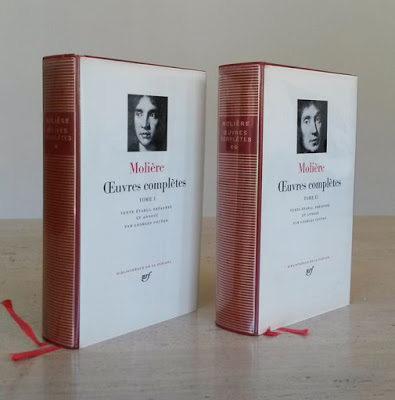
Molière : Œuvres complètes: Tome I (1972)
Molière. Œuvres complètes. Tome 1 : La Jalousie du Barbouillé - Le Médecin volant - L'Étourdi ou Les Contretemps - Le Dépit amoureux - Les Précieuses ridicules - Sganarelle ou Le Cocu imaginaire - Dom Garcie de Navarre ou le Prince jaloux - L'École des Maris - Les Fâcheux - L'École des Femmes - Remerciement au Roi - La Critique de l'École des Femmes - L'Impromptu de Versailles - Le Mariage forcé - Les Plaisirs de l'Île enchantée - La Princesse d'Élide - Le Tartuffe ou L'Imposteur - Appendices. Ed. Georges Couton. 1972. 2 vols. Bibliothèque de la Pléiade, 8. Paris: Gallimard, 1981.
Ancienne édition, Parution le 23 Février 1972, 1488 pages
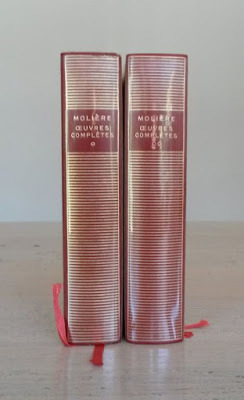
Molière : Œuvres complètes: Tome II (1972)
Molière. Œuvres complètes. Tome 2 : Dom Juan ou Le Festin de Pierre - L'Amour médecin - Le Misanthrope - Le Médecin malgré lui - Le Bal des Muses - Pastorale comique - Mélicerte - Le Sicilien ou L'amour peintre - Amphitryon - Le Grand divertissement royal de Versailles - George Dandin ou Le Mari confondu - L'Avare - Monsieur de Pourceaugnac - Les Amants magnifiques - Le Bourgeois gentilhomme - Psyché - Les Fourberies de Scapin - La Comtesse d'Escarbagnas - Les Femmes savantes - Le Malade imaginaire - Œuvres diverses - Appendices. Ed. Georges Couton. 1972. 2 vols. Bibliothèque de la Pléiade, 9. Paris: Gallimard, 1981.
Ancienne édition, Parution le 23 Février 1972, 1584 pages
Georges Perec (1936-1982)
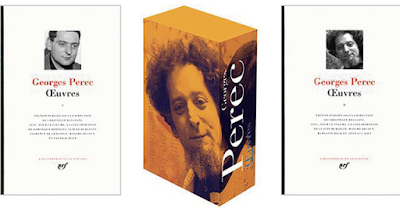
Georges Perec : Œuvres: Tome I (2017)
Perec, Georges. Œuvres I : Les Choses - Quel petit vélo à guidon chromé au fond de la cour? - Un homme qui dort - La Disparition - Les revenentes - Espèces d'espaces - W ou Le souvenir d'enfance - Je me souviens. 2 vols. Ed. Christelle Reggiani, with Dominique Bertelli, Claude Burgelin, Florence de Chalonge, Maxime Decout & Yannick Séité. Bibliothèque de la Pléiade, 623. Paris: Gallimard, 2017.
Parution le 11 Mai 2017, 1184 pages, 61.50 €
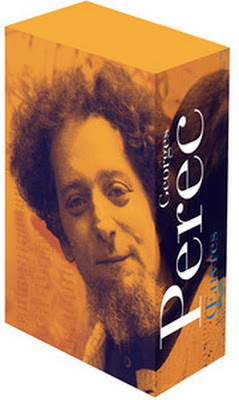
Georges Perec : Œuvres: Tome II (2017)
Perec, Georges. Œuvres II : La Vie mode d'emploi - Un cabinet d'amateur - La Clôture et autres poèmes - L'Éternité. Appendice : Tentative d'épuisement d'un lieu parisien - Le Voyage d'hiver - Ellis Island - L'art et la manière d'aborder son chef de service pour lui demander une augmentation - L'Augmentation. 2 vols. Ed. Christelle Reggiani, with Claude Burgelin, Maxime Decout, Maryline Heck et Jean-Luc Joly. Bibliothèque de la Pléiade, 624. Paris: Gallimard, 2017.
Parution le 11 Mai 2017, 1280 pages, 63.50 €
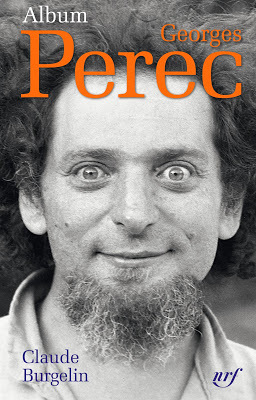
Claude Burgelin : Album Georges Perec (2017)
Burgelin, Claude. Album Georges Perec : Iconographie commentée. Bibliothèque de la Pléiade. Albums de la Pléiade, n° 56. Paris: Gallimard, 2017.
Parution le 11 Mai 2017, 256 pages, 202 ill.
Fernando António Nogueira de Seabra Pessoa (1888-1935)
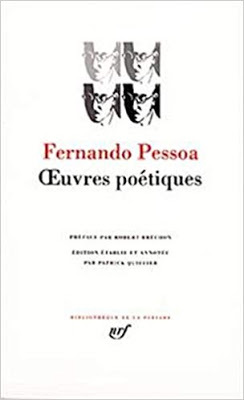
Fernando Pessoa : Œuvres poétiques (2001)
Pessoa, Fernando. Œuvres poétiques : Alberto Caeiro : Le Gardeur de troupeaux - Le Berger amoureux - Poèmes non assemblés. Ricardo Reis : Odes. Livre premier - Odes publiées dans la revue «Presença» - Odes éparses. Álvaro de Campos : Premiers poèmes - Les Grandes odes - Autour des grandes odes - Derniers poèmes. Fernando Pessoa : Poèmes paülistes, sensationnistes et intersectionnistes - Pour un «Cancioneiro» - Sonnets - Quatrains - Rubayat - Poèmes politiques - Poèmes ésotériques et métaphysiques - Message - En marge de «Message» - Praça da Figueira - Un Soir à Lima - Poésie humoristique et vers de circonstance. Poésie anglaise : Poèmes d'Alexander Search - Épithalame - Antinoüs - Trente-cinq sonnets - Inscriptions - Le Violoneux fou - Poèmes anglais épars. Appendices : Poèmes de jeunesse - Aux frontières de la littérature : les poèmes français. Ed. Patrick Quillier. Trans. Olivier Amiel, Maria Antónia Câmara Manuel, Michel Chandeigne, Pierre Léglise-Costa et Patrick Quillier. Préface de Robert Bréchon. Bibliothèque de la Pléiade, 482. Paris: Gallimard, 2001.
Parution le 14 Novembre 2001, 2176 pages, 76.00 €
Valentin Louis Georges Eugène Marcel Proust (1871-1922)
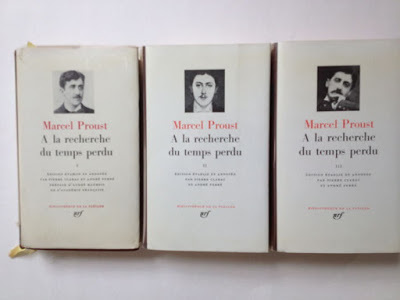
Marcel Proust : À la recherche du temps perdu: Tome I (1954)
Proust, Marcel. À la recherche du temps perdu. Tome 1 : Du Côté de chez Swann - À l’Ombre des jeunes filles en fleur. Preface by André Maurois. Ed. Pierre Clarac & André Ferré. 3 vols. Bibliothèque de la Pléiade, 100. 1954. Paris: Gallimard, 1964.
Épuisé, Parution le 30 Novembre 1954, 1056 pages
Jean Racine (1639-1699)
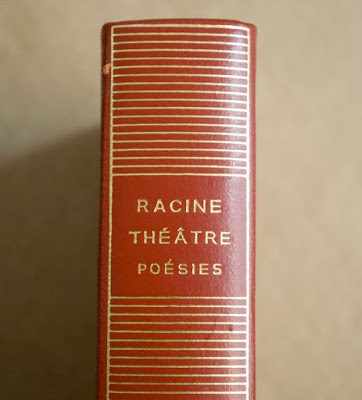
Jean Racine : Œuvres complètes: Tome I (1931)
Racine. Oeuvres complètes I : Théâtre : La Thébaïde ou les frères ennemis - Alexandre Le Grand - Andromaque - Les Plaideurs - Britannicus - Bérénice - Bajazet - Mithridate - Iphigénie - Phèdre - Esther - Athalie. Poésies : Épigrammes - Cantiques spirituels - Paysage ou les promenades de Port-Royal-Des-Champs - Poésies latines. Ed. Raymond Picard. Bibliothèque de la Pléiade, 50. 1931. Paris: Gallimard, 1964.
Épuisé, Parution en Décembre 1931, 1216 pages
Antoine de Saint-Exupéry (1900-1944)
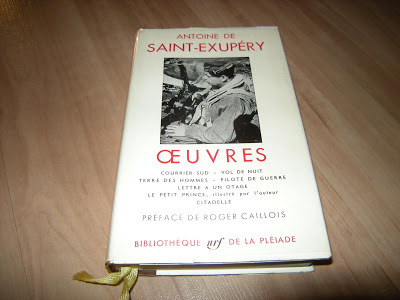
Antoine de Saint-Exupéry : Œuvres (1953)
Saint-Exupéry, Antoine de. Œuvres : Courrier Sud - Vol de nuit - Terre des hommes - Pilote de guerre - Lettre à un otage - Le Petit Prince - Citadelle. Preface de Roger Callois. Bibliothèque de la Pléiade, 98. 1953. Paris: Gallimard, 1959.
Épuisé, Parution en Novembre 1953, 1056 pages, ill.
Alexis Leger [Saint-John Perse] (1887-1975)
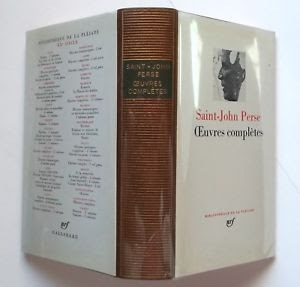
Saint-John Perse : Œuvres complètes(1972)
Saint-John Perse. Œuvres complètes : Œuvre poétique : Éloges - La Gloire des rois - Anabase - Exil - Vents - Amers - Chronique - Oiseaux - Chanté par celle qui fut là - Chant pour un équinoxe. Prose : Discours - Hommages - Témoignages. Correspondance : Lettres de jeunesse - Lettres d'Asie - Lettres d'exil. 1972. Bibliothèque de la Pléiade, 240. Paris: Gallimard, 2004.
Parution le 27 Novembre 1972, 1472 pages, 56.00 €
Jean-Paul Charles Aymard Sartre (1905-1980)
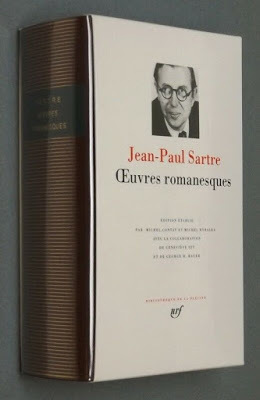
Jean-Paul Sartre : Œuvres romanesques(1982)
Sartre, Jean-Paul. Œuvres Romanesque : La Nausée - Le Mur. Les Chemins de la liberté : L'Âge de raison - Le Sursis - La Mort dans l'âme - Drôle d'amitié. Appendices : Dépaysement - La Mort dans l'âme [Fragments de journal] - La Dernière chance [Fragments]. Ed. Michel Contat & Michel Rybalka, with Geneviève Idt & George H. Bauer. Bibliothèque de la Pléiade, 295. Paris: Gallimard, 1981.
Parution le 13 Janvier 1982, 2304 pages, 73.50 €
Somadeva (c.11th century)
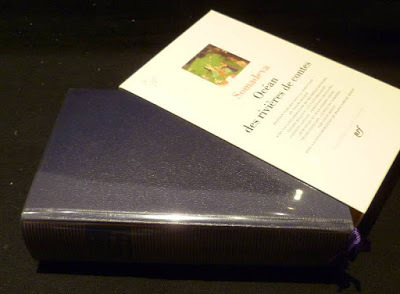
Somadeva : Océan des rivières de contes(1997)
Somadeva. Océan des rivières de contes. Ed. Nalini Balbir, with Mildrède Besnard, Lucien Billoux, Sylvain Brocquet, Colette Caillat, Christine Chojnacki, Jean Fezas & Jean-Pierre Osier. Traduction des ‘Contes du Vampire’ par Louis & Marie-Simone Renou, 1963. Bibliothèque de la Pléiade, 438. Paris: Gallimard, 1997.
Parution le 5 Septembre 1997, 1792 pages, ill., 76.00 €
Marie-Henri Beyle ['Stendhal'] (1783-1842)
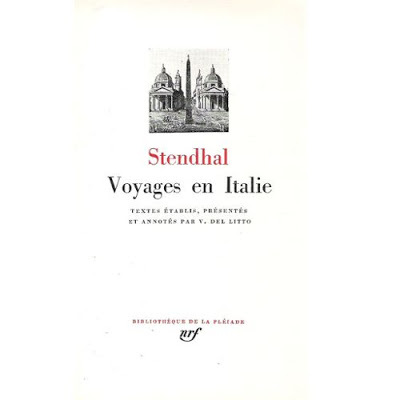
Stendhal : Voyages en Italie(1973)
Stendhal. Voyages en Italie : Rome, Naples et Florence en 1817 - L'Italie en 1818 - Rome, Naples et Florence (1826) - Promenades dans Rome. Suppléments : Les Marionnettes - Lettres de Rome à Romain Colomb - Les Ambassadeurs, etc. Ed. V. Del Litto. Bibliothèque de la Pléiade, 249. Paris: Gallimard, 1973.
Parution le 26 Octobre 1973, 1920 pages, 60.00 €
Paul-Marie Verlaine (1844-1896)
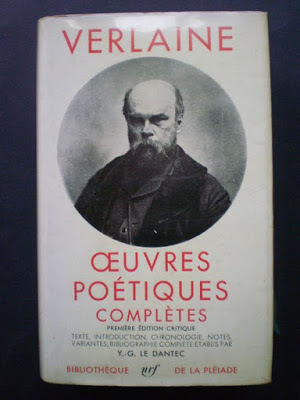
Paul Verlaine : Œuvres poétiques complètes (1938)
Verlaine, Paul. Œuvres poétiques complètes : Premiers vers - Poèmes saturniens - Fêtes galantes - Poèmes contemporains des «Poèmes saturniens» et des «Fêtes galantes» - La Bonne chanson - Contribution à l'«Album zutique» - Romances sans paroles - Poèmes contemporains de «La bonne chanson» et des «Romances sans paroles» - Sagesse - Reliquat de «Cellulairement» et poèmes contemporains de «Sagesse» - Jadis et naguère - Amour - Parallèlement - Poèmes contemporains de «Parallèlement» - Dédicaces - Bonheur - Chansons pour elle - Liturgies intimes - Odes en son honneur - Élégies - Le Livre posthume - Dans les limbes - Épigrammes - Chair - Invectives - Biblio-sonnets - Poèmes divers. Œuvres libres : Femmes - Hombres. Ed. Y.-G. Le Dantec. Bibliothèque de la Pléiade, 47. 1938. Paris: Gallimard, 1954.
Parution en Juillet 1938, 1600 pages, 61.00 €
Blessed Jacobus de Varagine / Voragine [Giacomo da Varazze / Jacopo da Varazze] (c.1230–1298)
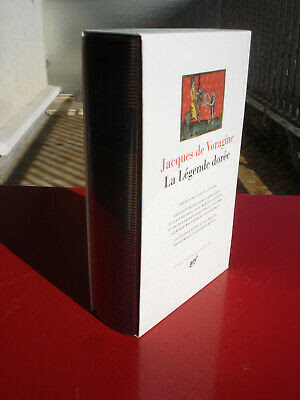
Jacques de Voragine : La Légende dorée (2004)
Voragine, Jacques de. La Légende dorée. Preface by Jacques Le Goff. Ed. Alain Bouveau, Monique Goullet, Pascal Colomb, Laurence Moulinier, & Stefano Mula. ‘La Legende dorée et ses images’, by Dominique Donadieu-Rigaut. Bibliothèque de la Pléiade, 504. Paris: Gallimard, 2004.
Parution le 11 Mars 2004, 1664 pages, 197 ill., 69.00 €
Published on June 07, 2019 15:27
May 13, 2019
My Grandmother & the Folio Society
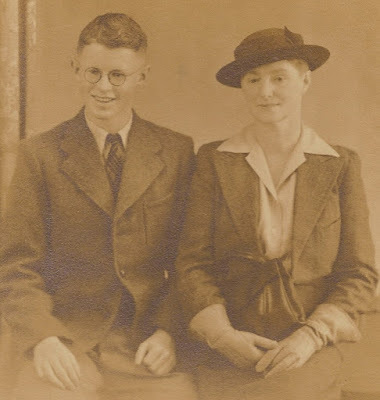
My father John Ross with my grandmother, Mary Maclean Ross (1940s)
Shortly after the end of the Second World War, my grandmother decided to join the Folio Society. Both she and my grandfather had always had a fascination for books - much earnest calculation had gone into their earlier choice to invest in a collected set of Dickens (which I now own) back in the 1930s.
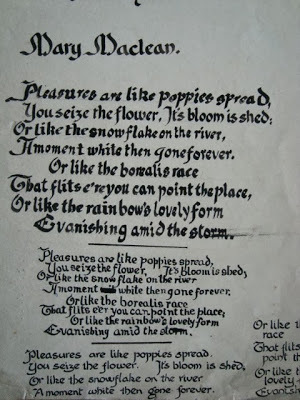
Mary Maclean: Calligraphy (1915)
When Bronwyn and I found an old art portfolio of hers, dating from 1915 (when she was 21), it made clear her interest in calligraphy and figure studies.
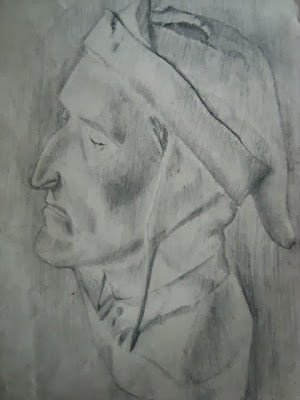
Mary Maclean: Dante Alighieri (1915)
I inherited a number of the books she collected after my father's death, and I have to say that they've begun to fascinate me more and more. For a start, there's the fact that she owned a copy of the very first Folio Society book ever: Tales, by Leo Tolstoy (1947).
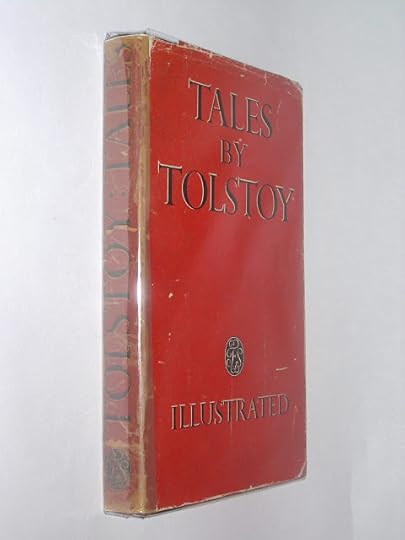
Leo Tolstoy: Tales (1947)
My grandmother was a very remarkable person. Born in Achiltibuie on the West Coast of Scotland in 1894, she was brought up speaking Gaelic, and didn't in fact learn English until she went to school - in Ullapool, a day's walk away along the coast.
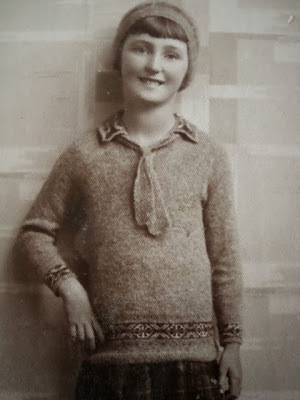
Mary Maclean (aged 11 or 12)
She studied Mathematics and Science at Glasgow University before the First World War, but was also an active suffragette. She told me once that she didn't mind chaining herself to railings, but - given the poverty of her upbringing - couldn't bear smashing large plate-glass windows.
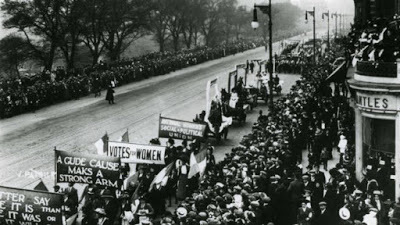
Votes for Women! (Scotland)
Virtually all the boys she knew died in the war. As a result, she was forced to contract a 'mixed marriage' - i.e. to marry a lowlander and a non-Gaelic speaker, my grandfather Angus Alexander Ross, from Dingwall in Ross-shire. The two, however, did have a number of things in common.
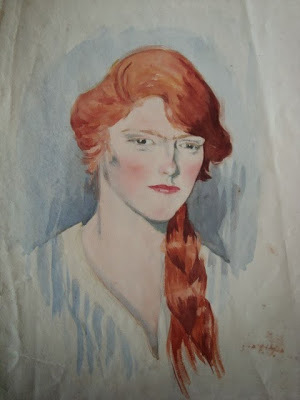
Mary Maclean: Self-Portrait (1915)
They detested priests. Both had qualified as school teachers, but my grandmother in particular hated the fact that the parish minister had to approve your morals before you were allowed to teach in any district in Scotland. And you had to take Sunday School. As an atheist and rationalist, she found this extremely difficult, as did my grandfather.
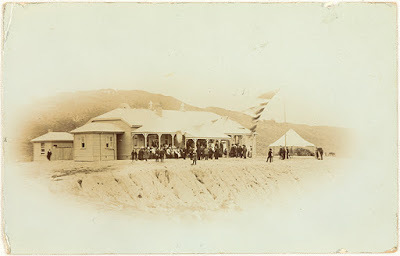
Rawene Hospital (1920s)
In search of irreligious freedom, my grandparents came out to New Zealand in the early 1920s. The first place they were sent to was Rawene, on the Hokianga harbour, where they were renowned for having the only tin bath in the district - that is, until my grandfather riddled it with bullet holes while trying to take out a particularly cheeky rat. He was rather fond of guns, in fact: shooting fish from the wharf was another of his favourite sports (you had to get the angle of refraction right, apparently, which he was able to do from long practice in his earlier life as a fisherman in Canada, before the Great War).
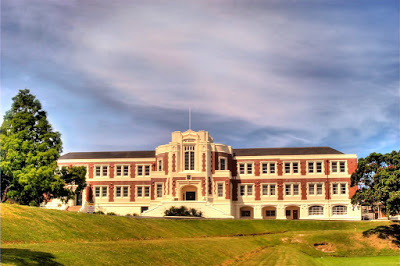
Takapuna Grammar School today
My grandfather died in the Second World War, leaving my grandma to raise two boys on her own. She taught Maths at various schools in Auckland: Epsom Girls and Takapuna Grammar among them. It was in her house in Bayswater, with the beautiful glass-fronted bookcases, that we first became acquainted with her eclectic taste in books. By then she'd become interested in Christian Science, but only as a sideline. She remained a Labour-voting Socialist and rationalist to the end. She didn't suffer fools gladly.
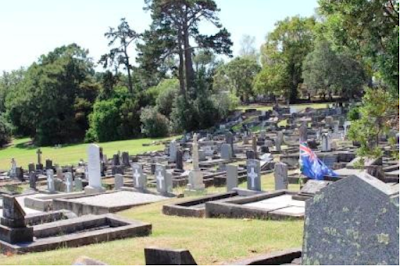
Bayswater Cemetery
She died in 1990 at the age of 96. I miss her: her sardonic wit, not to mention her immense experience of life.
•

Folio Society Books
Folio Society Books
in my possession
(1947 to the present day)
* = originally owned by Mary Maclean Ross
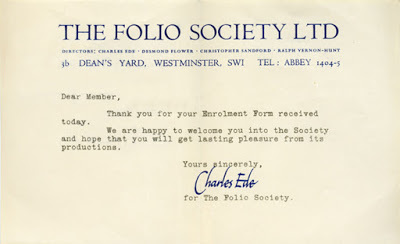
Charles Ede: Welcome Letter (1947)
[1947]:
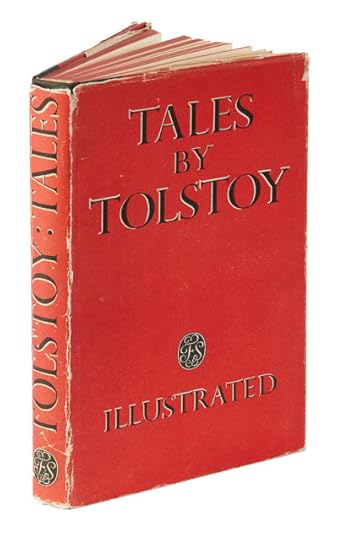
Leo Tolstoy: Tales (1947)
*Tales, by Leo Tolstoy. [The Raid; Two Hussars; Three Deaths; Poliskushka; The Death of Ivan Ilyitch; Two Old Men]. Translated by Louise and Aylmer Maude, and by Constance Garnett. 9 pen and ink sketches by Elizabeth Macfadyen. Quarter-bound in black cloth with red cloth covers. White dust-jacket printed in red and black. 280 pp. 25.3 x 16 cm. (First book published by the Folio Society).
[1948]:
The Confessions of an English Opium-Eater, by Thomas de Quincey. 10 wood-engravings by Blair Hughes-Stanton. Bound in black cloth blocked with a gilt design. White dust-jacket printed in red and black. 220 pp. 22.2 x 14.1 cm.
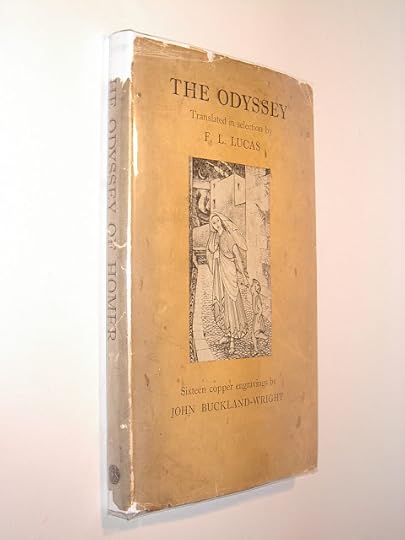
Homer: The Odyssey (1948)
*The Odyssey, by Homer. Selected and translated by F.L. Lucas. 16 engravings on copper by John Buckland-Wright. Bound in brown canvas with gilt blocked figure. White dust-jacket printed in light brown and black. 136 pp. 25.3 x 16.1 cm. .
[1949]:
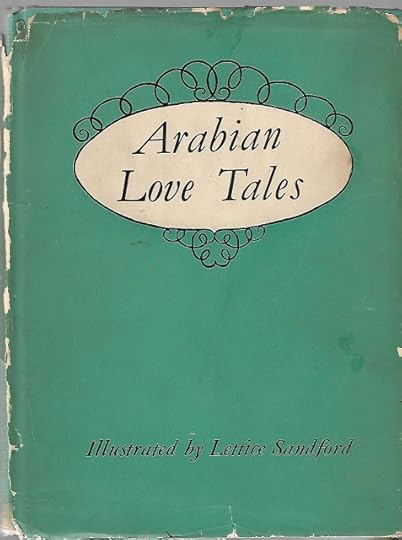
Lettice Sandford, illus.: Arabian Love Tales (1949)
Arabian Love Tales, Being Romances Drawn from the Book of the Thousand Nights and One Night, Anonymous, rendered into English from the literal French translations of Dr J.C. Mardrus by Powys Mathers, 12 full-page line drawings by Lettice Sandford. Bound in full blue-green cloth decorated in brown and gold, endleaves with a design in green by Sandford. White dust-jacket printed in blue-green and black. 246 pp. 22.5 x 17.2 cm.The Compleat Angler or The Contemplative Man's Recreation, by Izaak Walton and Charles Cotton, with a full-page frontispiece and 28 small illustrations in the text by Lynton Lamb. Bound in full green cloth with a border of rules in blind; endleaves with a design in grey by Lamb. White dust-jacket printed in grey and black. 274 pp. 22.9 x 15 cm.*Jorrocks' Jaunts and Jollities, by R.S. Surtees. 15 hand-coloured plates by Henry Alken. Bound in full red buckram. White dust-jacket printed in grey and black. 228 pp. 22.9 x 15.2 cm.*The Parson’s Daughter and Other Stories, by Anthony Trollope, selected and introduced by John Hampden, 17 wood-engravings by Joan Hassall. Bound in full cream cloth with a repeat pattern in green. White dust-jacket printed in green and black. 228 pp. 21.9 x 14.4 cm.
[1950]:
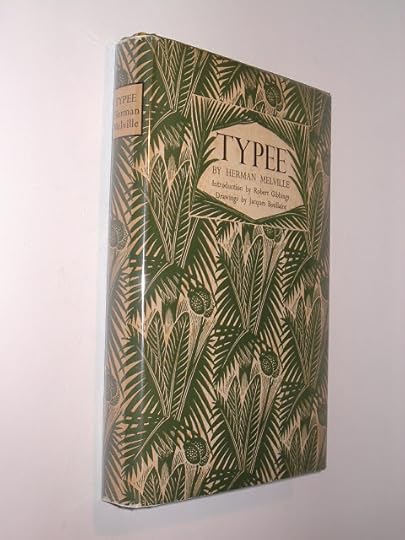
Herman Melville: Typee (1846)
*Typee, by Herman Melville, introduction by Robert Gibbings, nine leaves of pencil drawings by Jacques Boullaire. Bound in full yellow cloth with a repeat pattern in green by John Buckland-Wright. White dust-jacket printed in green and black. 278 pp. 22.8 x 14.9 cm.
[1951]:
The Complete Poems of Emily Brontë. Edited and introduced by Philip Henderson. Portrait frontispiece. Bound in quarter red-brown leather with dark green cloth boards. Dust-jacket. 282 pp. 19 x 13 cm.*The Newgate Calendar. Edited and introduced by Sir Norman Birkett. 8 leaves of contemporary engravings. Bound in quarter red cloth with marbled paper boards. White dust-jacket printed in red and black. 259 pp. 22.7 x 15 cm.
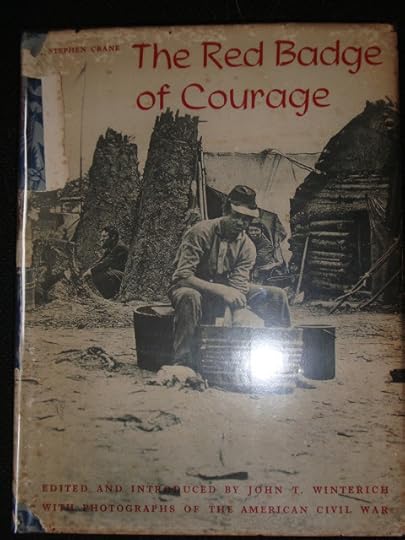
Stephen Crane: The Red Badge of Courage (1895)
*The Red Badge of Courage, by Stephen Crane. Edited and introduced by John T. Winterich. 10 leaves of civil war photographs. Bound in grey cloth blocked with a dark blue pattern. White dust-jacket printed in red and black. 159 pp. 22.4 x 17.2 cm.*The Sofa: A Moral Tale, by Crébillon Fils [Claude-Prosper Jolyot de Crébillon]. Translated by Bonamy Dobrée. 7 leaves of etchings by Robert Bonfils. Bound in pink cloth. White dust-jacket printed in pink and black. 256 pp. 22.8 x 15.2 cm.
[1952]:
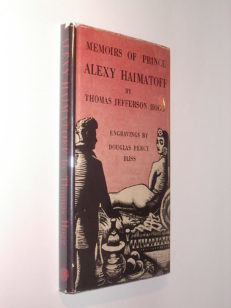
T. J. Hogg: Memoirs of Prince Alexy Haimatoff (1813)
*Memoirs of Prince Alexy Haimatoff, by Thomas Jefferson Hogg. Introduced by Sidney Scott. 8 full page engravings by Douglas Percy Bliss. Quarter bound in dark green buckram with marbled paper boards. White dust-jacket printed in pink and black. 155 pp. 22.5 x 13.5cm.*The Quest for Corvo, by A.J.A. Symons. Introductions by Sir Norman Birkett and Sir Shane Leslie. 6 pages of collotype plates. Quarter-bound in black buckram with light grey boards blocked with a design in dark grey and red. White dust-jacket printed in red. 289 pp. 22.7 x 15.3 cm.*Two Tales of the Congo, by Joseph Conrad. Eight copper engravings by Dolf Rieser. Bound in grey cloth blocked in black with an African effigy design. White dust-jacket printed in black. 166 pp. 22 x 14 cm.
[1953]:
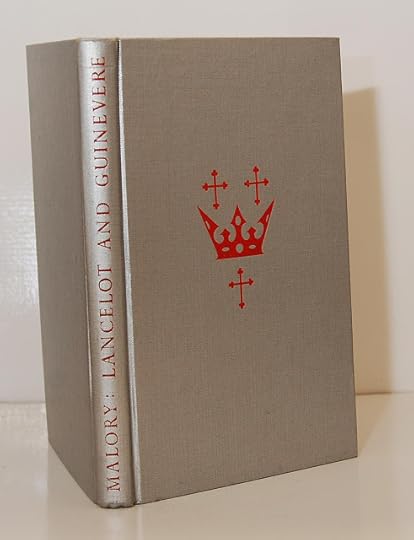
Sir Thomas Malory: Lancelot & Guinevere (1485)
*Lancelot & Guinevere, edited from Sir Thomas Malory's Morte Darthur, twelve drawings by Lettice Sandford. Full silver cloth decorated in red. No dust-jacket. 22.6 x 14.6 cm. 208 pp. The Presentation Volume for 1953.*Readings from Dickens, by Emlyn Williams, introduction by Bernard Darwin. Four leaves of plates. Full dark green linen with a vignette in gold on a red ground. White dust-jacket with a design in red and green. 22.1 x 14.4 cm. 164 pp.
[1954]:
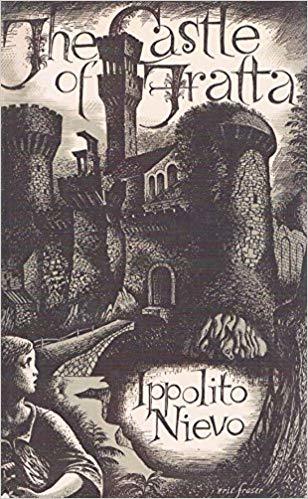
Ippolito Nievo: The Castle of Fratta (1867)
*The Castle of Fratta, by Ippolito Nievo, translated by Lovett F. Edwards, 8 leaves of illustrations by Eric Fraser, drawn in black ink and Chinese white on marbled linoleum. Bound in quarter grey canvas, marbled paper boards. White dust-jacket printed in grey and dark brown. 22.8 x 14.2 cm. 226 pp.
[1955]:
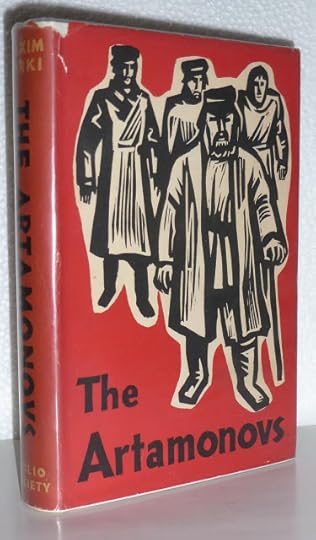
Maxim Gorki: The Artamonovs (1927)
*The Artamonovs, by Maxim Gorki, translated and with an introduction by Alec Brown, nine wood-cuts by Peter Pendrey. White dust-jacket printed in red and black. 22.8 x 15.3 cm. 282 pp.*The Discovery of Tahiti, by George Robertson, edited and introduced by Oliver Warner, ten wood-engravings by Robert Gibbings. Bound in quarter green cloth, yellow paper boards with a repeat pattern in dark brown by Gibbings. No dust-jacket. 22.1 x 14.6 cm. 128 pp. The Presentation Volume for 1955. *The London Spy, by Ned Ward, edited and introduced by Kenneth Fenwick with 12 leaves of contemporary prints by Hogarth and others. Quarter black cloth, marbled paper boards, designed by John Westwood. White dust-jacket printed in dark blue. 22.7 x 14.8 cm. 328 pp.
[1956]:
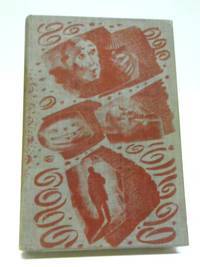
Walter de la Mare: Ghost Stories (1956)
Ghost Stories, by Walter de la Mare. 16 lithographs by Barnett Freedman. Introduction by Kenneth Hopkins. Bound in yellow canvas blocked with a brown design. Dark grey slipcase. 234pp. 22.5 x 15 cm.
[1958]:
A Memoir of the Forty-Five, by The Chevalier de Johnstone. Introduced by Brian Rawson. 8 leaves of gravure plates. Bound in dark blue buckram blocked with a gilt design. 22 x 14.5 cm. 251 pp.
[1960]:
Hermsprong, or Man As He Is Not, by Robert Bage. Introduction by Brian Rawson. 10 two-colour drawings by Cecil Keeling. Design printed endleaves. Quarter-bound in black buckram with marbled paper covers. Aqua slipcase. 262 pp. 22.8 x 14 cm.The Life of the Admiral Christopher Columbus, by his son Ferdinand. Translated and annotated by Benjamin Keen. 11 contemporary woodcuts and engravings. Map endleaves. Quarter-bound in cream leather with Japanese wood veneer boards. Black slipcase. 272 pp. 25 x 15.8 cm.
[1961]:
The Conquest of New Granada, by Juan Rodriguez Freile. Translated by William C. Atkinson. 7 wood-engravings by Harold Bennett. Bound in dar green buckram blocked with a gilt design. Dark red slipcase. Map endleaves. 228 pp. 22.3 x 14.7 cm. From Atlanta to the Sea, by William T. Sherman. Edited and with an introduction by B.H. Liddell Hart. 16 photographic plates. Bound in blue and grey cloth centrally divided down each cover and blocked with a gilt design. Map endleaves. Red slipcase. 304 pp. 23 x 17 cm.
[1963]:
A Shameful Revenge and other stories, by Maria de Zayas y Sotomayor. Translated with an introduction by John Sturrock. 9 full-page wood-engravings by Eric Fraser. Bound in quarter red cloth, white paper boards patterned with a marbled design by John Piper. Red endleaves. 22.6 x 14.8 cm. 200 pp.
[1964]:
Poems of Andrew Marvell. Introduction by C.V. Wedgwood. Wood-engraved frontispiece portrait by Peter Reddick. Quarter bound in grey leather, green cloth boards. Pink endleaves. Grey slipcase. 19 x 12.9 cm. 184 pp.
[1965]:
Ars Amatoria, by Publius Ovidius Naso. Translated by B.P. Moore. Drawings (frontispiece, three head-pieces and 71 smaller decorations) by Victor Reinganum. Quarter bound in dark green leather, brown cloth boards. Endleaves with a repeat pattern in brown by Reinganum. Grey slipcase. 18.9 x 12.9 cm. 128 pp.
[1967]:
Colonel Jack, by Daniel Defoe, 12 leaves of two-colour full-page wood-engravings by John Lawrence. Full yellow linen with an illustrative design in black by Lawrence, black leather spine-label, black endleaves. Black slipcase. 22.3 x 14.8 cm. 320 pp.The History of the Great Rebellion, by Edward Hyde, Earl of Clarendon, edited by Roger Lockyer, with 32 pages of contemporary etchings and portraits. Full dark blue buckram with a design in gold, blue-grey endleaves. Grey slipcase. 25.5 x 16.1 cm. 472 pp.Sir Roger de Coverly, by Joseph Addison, Sir Richard Steele and Eustace Budgell, edited by John Hampden, wood engravings by Richard Shirley Smith (frontispiece portrait and thirty head-pieces). Quarter brown buckram, marbled paper boards, green endleaves. Brown slipcase. 22.6 x 14.8 cm. 160 pp.
[1977]:
The Charterhouse of Parma, by Stendhal, translated by C.K. Scott Moncrieff, introduction by Gilbert Phelps, nineteen full-page wood-engravings by Zelma Blakely. Full green cloth with a repeat pattern in dark green by Blakely, black leather spine-label, green endleaves. Dark orange slipcase. 22.8 x 15 cm. 500 pp.Ralph Rashleigh, by James Tucker, introduced and edited by Colin Roderick, sixteen full-page drawings by Nigel Lambourne. Full pale green cloth with a design in brown by Lambourne, map endleaves, Brown slipcase. 22.8 x 15.1 cm. 344 pp.
[1982]:
Songs of the Wandering Scholars, by Helen Waddell, edited and with a preface by Dame Felicitas Corrigan, ten wood-engravings by Joan Freeman. Full brown-green cloth with a frieze of Monotype ornaments in purple and gold, pale brown endleaves. Lilac slipcase. 25.3 x 16 cm. 372 pp.
[1983]:
A Tour Through the Whole Island of Great Britain, by Daniel Defoe (3 vols. - 288, 288 & 366 pp.), introduction by Pat Rogers, with 102 contemporary prints, drawings and paintings. Full brown buckram decorated in gold, map endleaves. Dark red and pale brown three-volume slipcase printed in brown. 25.3 x 18.9 cm.
[1989]:
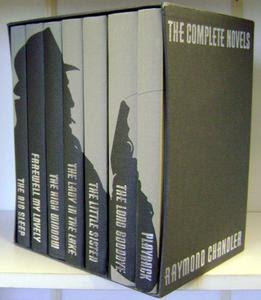
Raymond Chandler: The Complete Novels (1939-58)
The Complete Novels, by Raymond Chandler. (7 vols). Introduction by Frank MacShane, frontispiece drawings by Sue Bradbury. From the third printing, Sue Bradbury's drawings were dropped and each volume contained between six and nine drawings by Geoff Grandfield. Full grey cloth with a silhouette of Philip Marlowe by David Eccles in dark grey, dark red endleaves. Dark grey seven-volume slipcase titled in silver. 22.2 x 14.1 cm. The Big Sleep, 184 pp. Farewell My Lovely, 228 pp. The High Window, 204 pp. The Lady in the Lake, 208 pp. The Little Sister, 224 pp. The Long Goodbye, 288 pp. Playback, 156 pp.
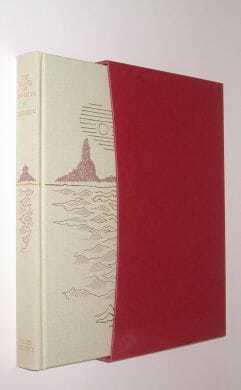
Anton Chekhov: The Island of Sakhalin (1895)
The Island of Sakhalin, by Anton Chekhov, translated by Luba and Michael Terpak, introduction by Irina Ratushinskaya, with fifteen leaves of contemporary photographs. Full pale grey-brown cloth with a design in red and gold by Sue Bradbury, dark red endleaves. Dark red slipcase. 25.2 x 16.1 cm. 288 pp.
[1991]:
Coleridge Among the Lakes and Mountains, selected and edited by Roger Hudson, with 68 illustrations reproducing contemporary paintings, prints and documents. Full white cloth lithographed in colour with a painting of Lake Windermere, pale green endleaves. Pale green slipcase. 24.5 x 17.3 cm. 256 pp. The Presentation Volume for 1992.
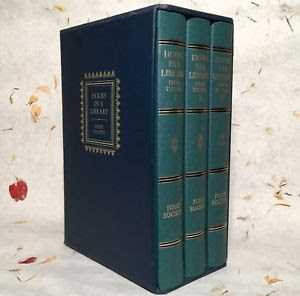
Leslie Stephen: Hours in a Library (1874-79)
Hours in a Library, by Leslie Stephen (3 vols). Introduction by Jonathan Steinberg, with 35 full-page portraits. Full blue-green cloth with a design in black and gold by Caroline Archer, dark blue endleaves. Dark blue three-volume slipcase. 22.8 x 15 cm. 354 / 360 / 344 pp.
[1993]:
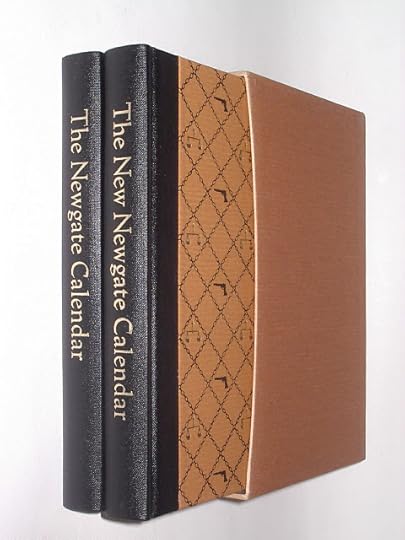
Sir Norman Birkett, ed: The Newgate Calendars (1951 & 1960)
The Newgate Calendars. (2 vols): The Newgate Calendar, edited and introduced by Sir Norman Birkett, with contemporary engravings, 260 pp. The New Newgate Calendar, edited and with an introduction by Lord Birkett, illustrated by Hablot K. Browne ('Phiz'), 265 pp. Quarter black cloth, brown paper boards with a repeat pattern in black and gold by Daniel Norman, brown endleaves. Brown two-volume slipcase. A photolithographic reprint of two volumes first published in 1951 and 1960 respectively. 22.7 x 15.1 cm.The Source of the Nile: The Lake Regions of Central Africa, by Richard F. Burton Introduced by Ian Curtis. Full pale brown cloth binding with a pastiche Victorian design in black and gold by David Eccles. Brown endleaves. Map loosely laid in. Black slipcase. 25.3 x 17.6 cm. 606 pp.
[1997]:
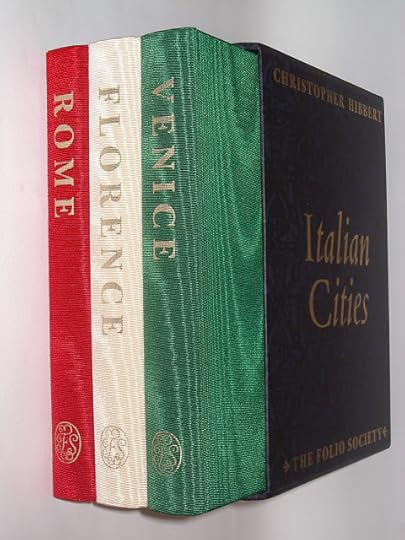
Christopher Hibbert: Italian Cities (1985-93)
Italian Cities, by Christopher Hibbert. (3 vols). Full artificial silk (a different colour for each volume), decorated in gold, endleaves printed in gold to a design by David Eccles. 16 pages of colour plates in each volume. Dark blue three-volume slipcase printed in black and titled in gold. Volumes form colours of Italian flag in slipcase. 1. Venice. Green binding, dark green endleaves. 436 pp. 2. Florence. Cream binding, dark brown endleaves. 398 pp. 3. Rome. Red binding, dark red endleaves. 388 pp. 25.2 x 19.6 cm.
[1998]:
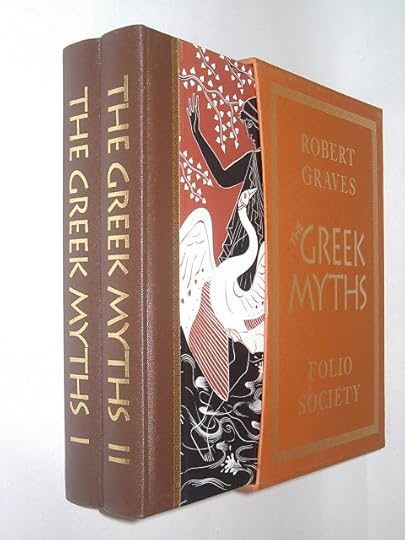
Robert Graves: The Greek Myths (1955)
The Greek Myths, by Robert Graves (2 vols). A reduced size reprint of the first edition of 1996, divided into two volumes in a two-volume slipcase. Vol.1 342 pp, 12 leaves of plates. Vol.2 357 pp, 4 leaves of plates. Map endleaves. Quarter-bound in brown cloth with image printed brown and black covers. Orange slipcase with gilt title. Each book 22.8 x 15 cm.
[1999]:
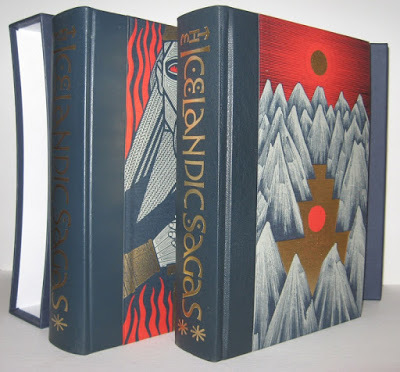
Magnus Magnusson, ed.: The Icelandic Sagas (1999 & 2002)
Icelandic Sagas I. Introduction by Magnus Magnusson. 16 colour plates by Simon Noyes. Map endpapers. Quarter black morocco over illustrated cloth boards with gilt titles on spine. 809 pp. 25.3 x 17.6 cm.
[2001]:
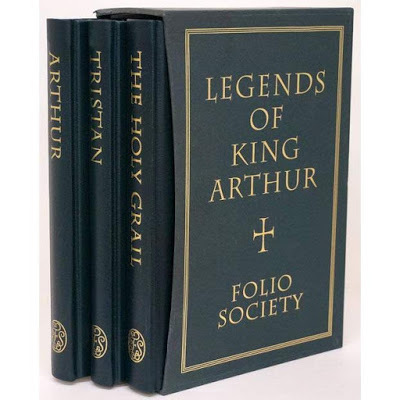
Richard Barber.: Legends of King Arthur (2001)
Legends of King Arthur. (3 vols). Reduced size reprint. Illustrations by Roman Pisarev. Introduced by Richard Barber. 726 pp and 16 pages of plates in total. Quarter-bound in dark green buckram with printed paper boards. Dark green slipcase titled in gold. 22.9 x 15.1 cm.
[2002]:
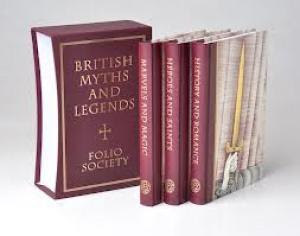
Richard Barber.: British Myths & Legends (2002)
British Myths & Legends. Reduced size reprint. (3 vols). Vol.1 Marvels and Magic, 8 Monochrome plates. Vol.2 Heroes and Saints, 4 Monochrome plates. Vol.3 History and Romance, 5 Monochrome plates. Quarter-bound in dark red buckram. 708 pp in total. 22.8 x 15 cm.Icelandic Sagas II. Translated, edited and introduced by Magnus Magnusson. Illustrations by John Vernon Lord. Map endleaves. Quarter-bound in dark blue leather with design printed cloth boards. 759 pp. 25.2 x 17.7 cm.
[2003]:
Satyrica, by Petronius Arbiter. Translated by Frederic Raphael. 7 illustrations by Neil Packer. Pictorial endpapers. Illustrated endpapers. Quarter bound in brown cloth with image printed paper sides. 157 pp. 28.8 x 19.3 cm.Selected Poems, by Samuel Taylor Coleridge. Edited and introduced by Richard Holmes. 74 wood engravings by Miriam Macgregor. Quarter-bound in dark blue leather with patterned cloth boards. Dark blue slipcase. 372 pp. 28 x 18.7 cm.
[2005]:
The Assassins: A Radical Sect in Islam, by Bernard Lewis. 14 colour plates of Islamic miniatures and photographs. Bound in image blocked red cloth. 242 pp. 23 x 15 cm.
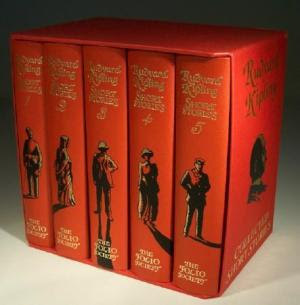
Rudyard Kipling: The Collected Short Stories (1888-1932)
Collected Short Stories, by Rudyard Kipling. (5 vols). Vol.1, Plain Tales from the Hills, Soldiers Three and other stories, 446 pp. Vol.2, Wee Willie Winkie and other stories and Life's Handicap, 503 pp. Vol.3, Many Inventions and The Day's Work, 507 pp. Vol.4, Traffics and Discoveries, Actions and Reactions and A Diversity of Creatures, 574 pp. Vol.5, A Diversity of Creatures (continued), Debits and Credits and Limits and Renewals, 590 pp. 11 illustrations by Philip Bannister in each volume. Bound in red cloth blocked with a black and gold image. Illustrated red slipcase. 25 x 16 cm.
[2007]:
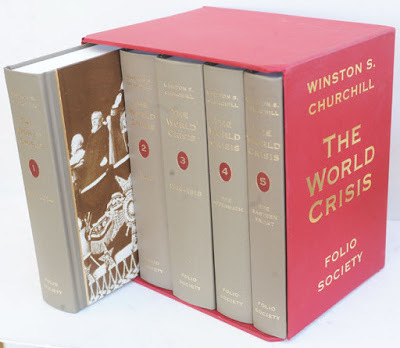
Winston Churchill: The World Crisis (1923-31)
The World Crisis, by Winston Churchill. (5 vols). Volume 1 1911-1914 xvii plus 464 pages. Volume 2 1915 xiii plus 453 pages. Volume 3 1916-1918 xiii plus 474 pages. Volume 4 The Aftermath xii plus 383 pages. Volume 5 The Eastern Front xii plus 311 pages. All volumes include b&w textual maps and b&w illustrations. Three-quarter bound in grey cloth with printed cover. Title gilt printed on crimson slipcase.
[2008]:
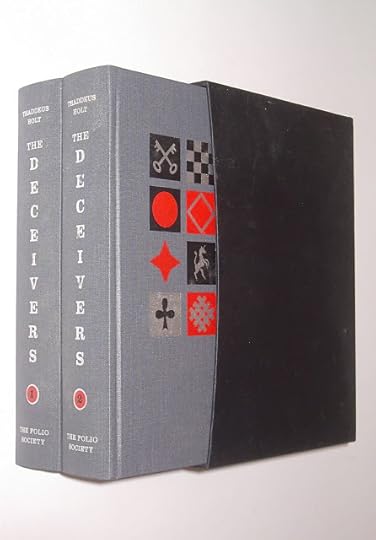
Thaddeus Holt: The Deceivers (2004)
The Deceivers, by Thaddeus Holt. (2 vols). Foreword by Sir Michael Howard. Frontispiece and 32 pages of black & white plates. Bound in grey cloth blocked with a black and red design. Black two volume slipcase. 9½ x 6¼ in. 1064 pp.
[2009]:
The Realm of the Unreal and Other Stories, by Ambrose Bierce. Introduction by Will Self. 10 black & white etchings by Nathan Sissons. Bound in orange image blocked cloth. 534 pp. 9½ × 6¼ in.
[2010]:
Brat Farrar, by Josephine Tey. Introduced by Ruth Rendell. 8 colour illustrations by A. Richard Allen. Bound in purple design blocked cloth. 232 pp. 23.7 x 15.7 cm.
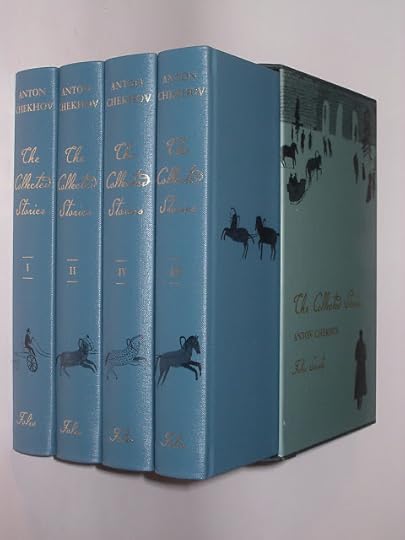
Anton Chekhov: Collected Stories (2010)
Collected Stories, by Chekhov. (4 vols). Volumes 333 pp; 347 pp; 303 pp; 364 pp. 60 stories. Translated by Ronald Hingley. Illustrations by Laura Carlin. Introduced by James Lasdun. Bound in blue cloth with gilt titles. Decorated slipcase. 9¾ x 7¾ in.Crusader Castles, by T. E. Lawrence. Introduced by Mark Bostridge. 118 black & white illustrations. Bound in buckram blocked with an illustration by Joe McLaren. 240 pp. 8½ × 6½ in.
[2011]:
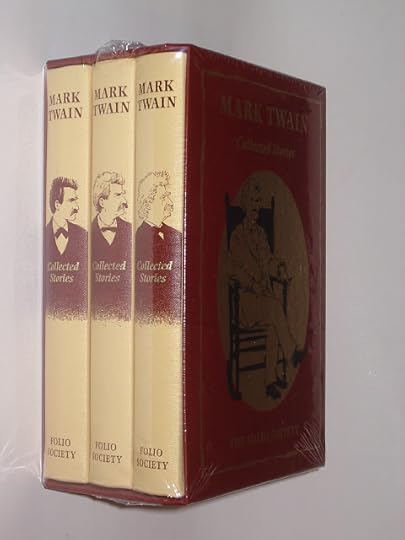
Mark Twain: Collected Stories (2011)
Collected Stories, by Mark Twain. [3 vols]. Bound in image blocked cream Buckram. Black & white illustrations by Roger Fereday. Three volume maroon image printed slipcase. 928 pp. 24 x 15 cm.Folk Tales of Britain: Narratives. (3 vols). Collected and edited by Katharine M. Briggs. Preface by Philip Pullman. Bound in buckram, blocked with individual designs by Hannah Firmin et al. 25 cm.

Katherine M. Briggs: Folk Tales of Britain: Legends (2011)
Folk Tales of Britain: Legends. (3 vols). Collected and edited by Katharine M. Briggs. Preface by Kevin Crossley-Holland. Illustrated by Hannah Firmin et al. 28 monochrome illustrations in each volume. Bound in pictorial maroon cloth, upper boards and backstrips blocked and lettered in gilt and black. Maroon endpapers. 25 cm.
[2012]:
Chronicles, by Raphael Holinshed. Frontispiece and 90 woodcuts. Bound in buckram printed and blocked with the title page from the 1577 edition. 456 pp. 10.2 x 6.6 in.
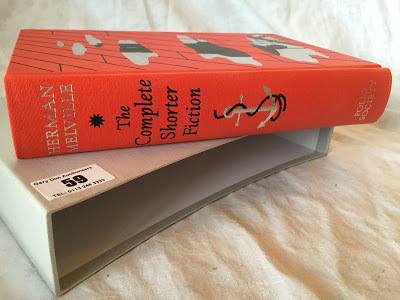
Herman Melville: The Complete Shorter Fiction (2012)
The Complete Shorter Fiction, by Herman Melville. Introduced by Jay Parini. Frontispiece and 15 colour illustrations by Bill Bragg. Bound in buckram blocked with a design by Bill Bragg. 528 pp. 10 × 6¼ in.
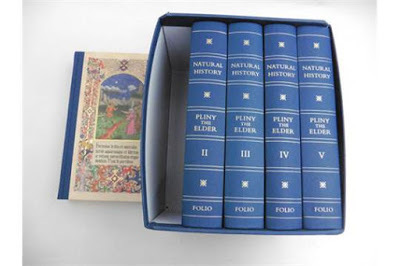
Pliny the Elder: Natural History (77)
Natural History, by Pliny the Elder. (5 vols). 379 pp., 429 pp., 384 pp., 354 pp., 421 pp. Translated by H. Rackham et al. Introduction by Anthony T.Grafton. 100 colour plates across all volumes. Bound in 3/4 buckram with pictorial paper front. Title and pattern on slipcase. 26.5 x 17.5 x 22.7cm.Paris After the Liberation, by Antony Beevor and Artemis Cooper. New introduction by the authors. Frontispiece and 32 pages of colour and black & white plates. Three-quarter bound in buckram printed with a photograph of an AFPU photographer kissing a child before cheering crowds, 26 August 1944. 448 pp. 10 × 6¾in.
[2013]:
Conrad’s Congo, by Joseph Conrad. Introduced by J. H. Stape. Preface by Adam Hochschild. Frontispiece and 16 pages of sepia and black & white plates and some integrated diagrams. Bound in cloth blocked with a design by Neil Gower. 256 pp. 9 x 6¼in.
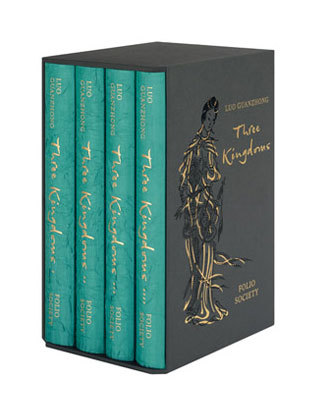
Luo Guanzhong: The Three Kingdoms (2013)
Three Kingdoms. AD 168 to 280. (4 vols). Translated by Moss Roberts. Introduced by Ma Jian. 280 integrated woodcuts from a 19th-century edition. Bound in shimmering cloth, blocked with four key figures redrawn by Neil Gower. Pictorial slipcase.
[2014]:
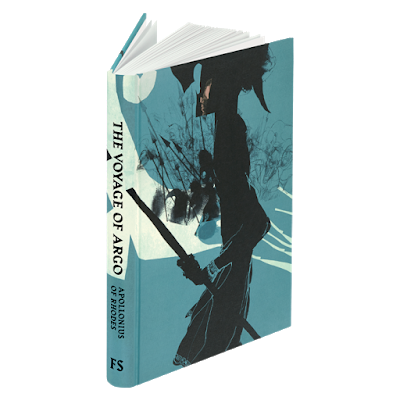
Appolonius of Rhodes: The Voyage of Argo (2014)
The Voyage of Argo, by Apollonius of Rhodes. Introduced by Lawrence Norfolk. Title page spread and 7 double-page colour illustrations by Daniel Egnéus. Translated from the Classical Greek by E. V. Rieu. Pictorial slipcase. Printed endpapers. Full colour binding, bound in cloth. 208 pp. 10 x 6¾ in.
[2017]:
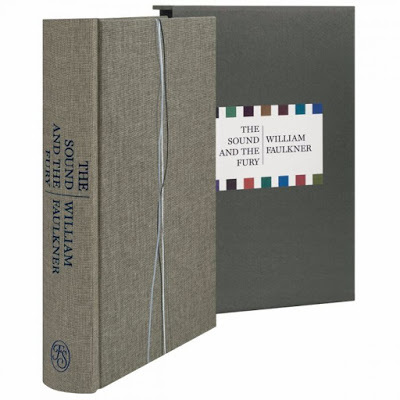
William Faulkner: The Sound and the Fury (2017)
The Sound and the Fury, by William Faulkner. Introduced by Stephen M. Ross and Noel Polk. Coloured text and colour-coded bookmark. Slipcase with printed label. Bound in blocked cloth. 552 pp. 10 x 6¼ in. Fine edition.
[2018]:
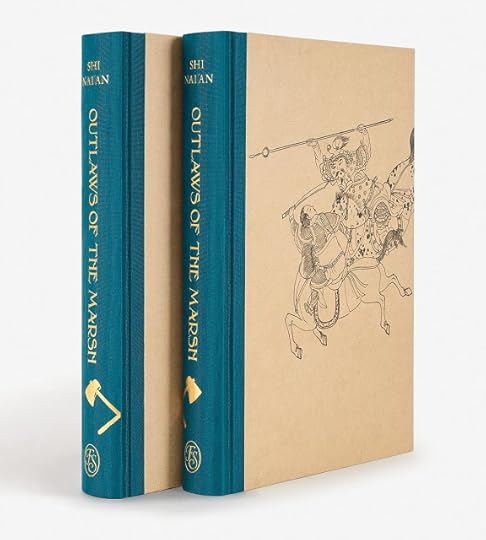
Shi Nai’an: Outlaws of the Marsh (2018)
Outlaws of the Marsh: The Water Margin, by Shi Nai’an. (2 vols). Introduced by Frances Wood. Translated by J. H. Jackson. Illustrations from the Rong Yu Tang edition by Shi Nai'an. Three-quarter bound in image blocked aqua-blue Art Silk with a printed cloth front board. Illustrated title pages and 141 woodblock illustrations. Ribbon markers. Gilded page tops. Image printed light brown cloth slipcase. 880 pp. in total. 11 x 7¼ in.
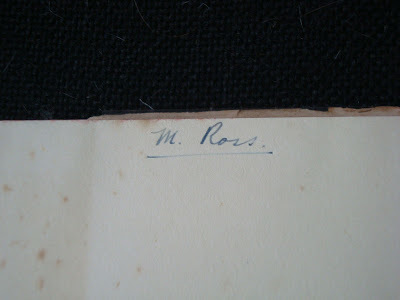
Jack Ross: Mary Ross's signature (1951)
Published on May 13, 2019 14:25



